The 2022 Global Energy Agenda
The year 2021 began with high hopes for climate action, as many members of the international community—including, once again, the US—rededicated themselves to the effort and looked to deploy resources accordingly. And there were certainly landmark achievements: the Global Methane Pledge was launched, the Paris Agreement rulebook was completed, and the private holders of $130 trillion in assets under management pledged their collective financial muscle to the fight against climate change, among other victories. But as global economic demand roared back from its pandemic-dampened level in 2020, energy supply failed to keep up, inflating hydrocarbon prices, driving countries back to dirty coal generation, and underscoring the challenges of the “transition” part of the energy transition. It became clear that countries will need to thread the needle between pushing for ambitious emissions reductions and keeping prices down and the lights on in the interim, all against an ever more precarious geopolitical backdrop.
With these considerations in mind, The 2022 Global Energy Agenda details a more pessimistic outlook on the promise of the energy transition, as respondents reckoned with concerns old and new. In these pages, experts offer ways forward in the face of hazards like Russian aggression, supply-demand mismatch, and a transition that threatens to leave the global poor behind. Though the pitfalls that emerged in 2021 gave many pause, this report reveals that leaders are no less determined to find solutions, and to chart a more stable and inclusive course in 2022.
Foreword
The 2022 Global Energy Agenda
By Frederick Kempe
As we begin 2022, still under the shadow of the COVID-19 pandemic, it may seem as though much of the world remains in a holding pattern. 2021 began with optimism but saw the continual resurgence of the pandemic, forcing world leaders to turn their attention and resources to fighting it back repeatedly. Still, 2021 was a significant year in energy and climate and much was accomplished. Crucially, global leaders were able to convene—for the first time since 2019—in Scotland at the 2021 United Nations Climate Change Conference (COP26). And while the outcomes are to be lauded, many observers left Glasgow feeling that more could have been accomplished.
I was fortunate to attend COP26, where I participated in programming in downtown Glasgow’s Blue Zone (with the Atlantic Council’s Adrienne Arsht- Rockefeller Foundation Resilience Center) and at the Climate Action Solution Centre (with the Atlantic Council Global Energy Center) at the stunning Blair Estate. In Scotland, I watched with my own eyes as world leaders—from government, industry, and civil society—recommitted themselves to addressing the global challenge of climate change and putting civilization on a path to net-zero carbon emissions by mid-century. There were reasons for optimism: the Glasgow Climate Pact, which committed to doubling global finance for adaptation; the request that each country present a more ambitious pledge at COP27 (indicating a far greater sense of urgency than before; the Paris COP had only asked for new nationally determined contributions every five years); and, of course, the ability to hold meetings face-to-face and to gather once again as a global community. However, it was clear to all that there remains more to be done and that the path to net-zero will be fraught with challenges and setbacks.
At the time, I concluded that the world is experiencing an energy transition, rather than an energy revolution, and supporting that transition will require significant breakthroughs in clean energy technologies (with commensurate investments in those technologies) and that policy changes (like putting a price on carbon) were also necessary to support the energy transition. I predicted that climate change adaptation strategies will become just as crucial as climate mitigation. Finally, I noted that geopolitical competition and cooperation between countries—especially the US, China, Russia, and India—will shape the global energy future and play as important a role as clean energy technologies and climate change itself. How the US responds to the geopolitical challenge may be shaped by the trajectory of our domestic political landscape, which—having just passed the first anniversary of January 6, 2021—seems to hang in the balance now, more than ever.
I believe that we are up to this set of great challenges, but—as always—the devil is in the details. COP26 took place against the backdrop of an ongoing energy price spike, largely focused on Europe but truly global.
These dynamics will cast a shadow over the energy transition and have the potential to cause a backlash. This backlash could have an impact that reverberates through domestic elections in any number of countries—especially since a world that lacks energy security will also be lacking in political security—and could put a damper on the global movement towards decarbonization.
The course that we chart to net-zero must be steady but also ambitious enough to meet the challenge. Energy access must remain a key priority, especially since the steps we take at this crucial moment will determine what our world looks like by mid-century. It is clear that oil and gas—especially with mitigation efforts like carbon capture, utilization, and storage— will continue to play a role in a low-carbon future.
This second edition of The Global Energy Agenda once again sets the stage for the upcoming year. We have again polled energy leaders from governments, industry, think tanks, and academia, capturing their views of the most important trends to watch and the ways in which we can work together to shape the global energy agenda. As with last year, the key indicator of how respondents answered the survey questions was, on the one hand, respondents who believed that peak oil demand had already occurred or would do so in the near-term and, on the other hand, respondents who believed that peak oil demand would not happen until 2040 at the earliest.
This year, there were two dramatic differences in survey answers from 2020. The first is that respondents’ prediction of when oil demand will peak shifted back by several years, suggesting they now think the energy transition is happening more slowly than they thought last year. Second, respondents’ views on the impact of COVID-19 on the energy system changed. In 2020, COVID-19 was seen as the biggest geopolitical risk to energy supply and production, but this year, cyber attacks were viewed as the greatest geopolitical risk.
As we look ahead to the coming year, I hope it is one of progress, with even greater climate commitments made at COP27 in Egypt (to be followed by COP28 in the United Arab Emirates). Furthermore, I hope this is the year when we leave the worst of COVID- 19 behind, which can only happen through the kind of global cooperation that will also be necessary to combat climate change and all of the other unforeseen challenges that this century is likely to present.
Frederick Kempe is the President and Chief Executive Officer of the Atlantic Council.
Introduction
Introduction
2021 was supposed to have been a game-changing year of climate action, with the US reentering the Paris Agreement and the pandemic recovery funds of many countries aimed at “green stimulus.”
From the finalization of the Paris rulebook to the launch of the Global Methane Pledge—and from renewal of US-China cooperation on climate to a dramatic increase in net-zero commitments from countries and companies—much was accomplished on climate over the past year. Additions of renewable power capacity likely set yet another record in 2021, and nuclear power might have turned the corner in public perception as a clean power source. Current climate pledges now put the world on track for 1.8 degrees of warming.
But it still was not the year many had hoped for or predicted.
As energy demand recovered from 2020 lows, carbon emissions came roaring back and energy prices skyrocketed, becoming a major driver of inflation and proving a political headache for many global leaders. Natural gas prices in Europe, for instance, hit record highs in December. Brent crude closed the year just shy of $80 but had spent more than half of the fourth quarter above that key threshold. Even a historic coordinated release of strategic oil stocks with US, China, India, Japan, South Korea, and the UK—coincidentally timed with news of the highly transmissible Omicron variant of COVID-19—brought down prices only briefly. And coal demand, which was thought to have peaked globally in 2014, rose dramatically, signaling a possible record-breaking year in 2022. COP26 did not “resign coal to history” as COP President Alok Sharma had declared it would.
So instead of being remembered as the year when the world turned the corner on climate action, 2021 will likely be remembered as the year global leaders began to confront the challenge of managing continued hydrocarbon demand even as they push for dramatic emissions reductions.
At its most basic level, this is exemplified by the seemingly contradictory calls by the Biden Administration for OPEC and US oil producers to increase production while simultaneously encouraging climate action. But in reality, these efforts were not contradictory at all; energy demand obviously must be met in the short term, even as that demand shifts to cleaner sources in the long term. A better example, then, is the Biden Administration’s creation of the still-nascent Net-Zero Producers Forum, which aims to bring major oil and gas producing economies in line with net-zero goals. So too is the EU’s inclusion of nuclear and gas in its green taxonomy.
2021 was also supposed to have been the year that the COVID-19 pandemic ended, or at least became much more manageable. Though the year began with a winter COVID surge during which, at its worst, nearly 20,000 people globally died per day from the disease, the development of multiple effective vaccines was the proverbial light at the end of the tunnel. And by mid-summer, in the developed world, the pandemic seemed to be ending.
Fast forward to December and, due to waning vaccine efficacy against infection (though still high efficacy against severe disease), a significantly more transmissible variant, and populations and politicians leery of additional lockdowns, global case numbers soared beyond anything seen over the previous two years. While severe disease and death seemed less likely
with Omicron than previous variants, hospitals again were stretched thin, and the world was only beginning to understand the economic disruption from so many people infected at once. How this will impact energy demand could be a major story for at least the beginning of 2022 and potentially for much longer.
In 2022, geopolitics will also be increasingly volatile, with Russia amassing troops on Ukraine’s border, Iran ramping up uranium enrichment, and tensions growing over Taiwan. The energy implications of these flashpoints are potentially dramatic—Russia has already been accused of manipulating the European gas market to increase prices and weaken Europe’s hand in responding to its apparent ambitions in Ukraine—bringing yet another year of disruption to energy markets.
The 2022 Global Energy Agenda and essays
To better understand the key issues facing the energy system in 2022, the Atlantic Council Global Energy Center commissioned a series of essays from global experts, corporate leaders, and government ministers. The Center also surveyed a global group of energy leaders, asking them a dozen high-level energy and climate questions. The survey reached hundreds of experts between November 11th and December 6th, 2021, and provides a valuable look at current thinking.1
This is the second annual Global Energy Agenda survey, and the inclusion of various questions from the first survey, conducted in the fall of 2020, also provides useful information on how views are changing.
These essays are not intended to provide a uniform outlook for the year ahead in energy. Instead, through their diversity, they aim to set the terms of debate and outline what possible outcomes might look like, depending on the decisions that governments and industry collectively make.
The survey results will be explored in more detail in the volume that follows. But a few key takeaways help provide overall context.
Fossil fuels will play a larger role for longer. Compared to last year, the energy sector as a whole thinks that fossil fuels will remain a part of the picture for slightly longer. This shift takes two forms. First, in our 2020 survey, respondents on average thought that peak oil demand would occur 10.5 years into the future. Among those surveyed in 2021, the figure has not declined by a year—as one might expect— but is now 12.8 years. Second, while 36 percent of 2021 respondents called the achievement of global net zero emissions by 2050 either somewhat or very likely, that figure has dropped to 27 percent in our current survey.
Two types of energy transition skeptics. Last year, our analysis identified—across age, geography, and, to an extent, area of activity within the sector—three broad schools of thought. The clearest marker of the group into which respondents fell was their estimate of peak oil demand’s likely date. Those we named “transition bulls” thought that this had already occurred or would do so by 2025; “transition bears” believed that it would not happen until 2040 at the earliest, if ever; and “moderates” forecast a year between 2025 and 2040.
In our current survey, the same division is apparent. This year, however, we had more “transition bears” as survey respondents, which permits more detailed analysis. We found that bears who believe that global net zero by 2050 is unlikely—and that, if reached, such an achievement would adversely affect economic growth—have answers quite distinct from fellow bears. The latter group sees political will as the largest barrier to reaching net-zero. The former group, however, largely believes that technology will not be able to deliver net-zero, making questions of policy and political will moot.
COP26 was “more blah, blah, blah.” When asked to rank the outcome of the conference on a scale from “more blah, blah, blah” to “creating a foundation for achieving global net-zero by 2050,” 51 percent of respondents chose the former and only 11 percent the latter. The rest said that it fell in between. Although Europeans and our transition bulls group were slightly more sympathetic, even among these respondents, more had a negative than a positive take.
Divergence on the future of natural gas. While on average, expectations about the long-term future of natural gas appear to have changed little from last year—a substantial majority still think that it will have a long-term future—geography is starting to be a predictor of thinking. 58 percent of European respondents believe that gas has a long-term future, close to the 62 percent in the US, but well behind the 71 percent in the Middle East. More striking, while only 40 percent of bulls think that the fuel has a long-term future, 59 percent of moderates do too, even though the groups gave similar answers last year.
COVID-19 is no longer the biggest perceived risk or driver of change. Last year, 39 percent of those surveyed thought that COVID-19 was the biggest geopolitical risk to energy supply and production. This time, only 11 percent do, with cyberattacks the most frequently cited at 26 percent. Similarly, the pandemic is no longer as widely perceived as a driver of change: the proportion thinking that it will accelerate the energy transition has dropped from 61 percent to 36 percent.
Taken together, we hope The Global Energy Agenda survey responses, analysis, and essays will lay out the contours of the current energy system, assess the events and trends that will shape the energy system in 2022, inform fact-based debate and analysis about the best path forward, and set the shared energy agenda for the year.
1 Please see the Appendix for a demographic breakdown of survey respondents, including geographic, age, and employment sector.
Chapter 1: Climate change and climate action
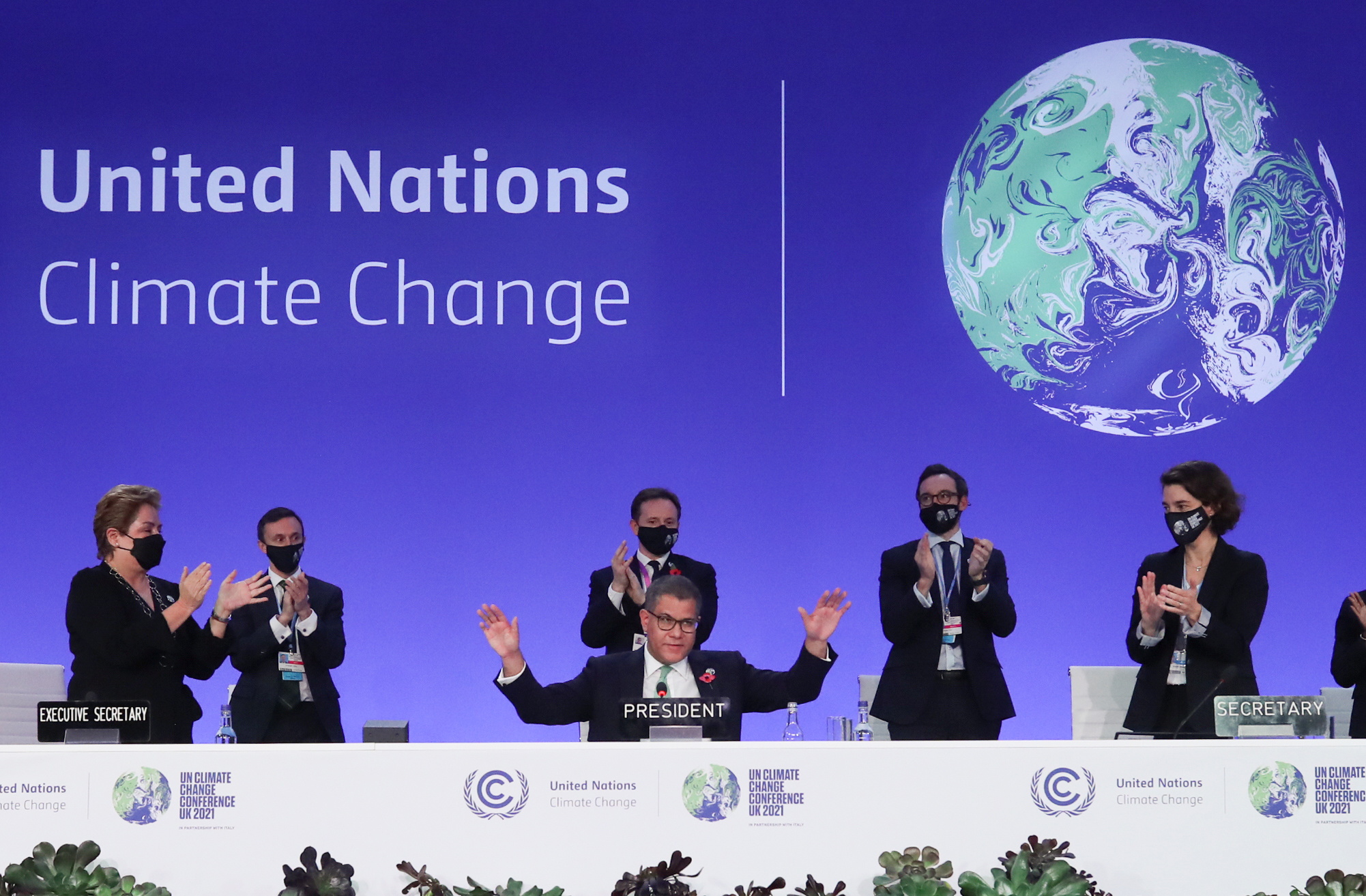
Climate change and climate action
Essays
How voluntary use of carbon markets can help secure sustainable energy for all
By Rachel Kyte
Projecting COP ambitions across COP27 and COP28
A conversation with: H.E. Dr. Sultan Ahmed Al Jaber, Rt. Hon. Alok Sharma MP, H.E. Sameh Shoukry; moderated by Frederick Kempe
COP26 did not deliver everything we wanted, but here is where key progress was made
By Fatih Birol
COP26 and the Climate Action Solution Centre
By Rt. Hon. Charles Hendry
Resource efficiency is crucial for sustainable development
By Jonathan Maxwell
Nuclear energy is essential to achieving a clean, affordable, and equitable energy system for the future
By Sama Bilbao y León
The role of nuclear power in Japan’s future energy system
By Tatsuya Terazawa
Survey results

On his first day in office on January 20, 2021, US President Joe Biden signed the documents necessary to bring the US back into the Paris Agreement. With an aggressive policy platform and significant star power in senior climate jobs, the US was “back.” And with global momentum behind climate action, renewed US leadership, and a focus on COP26, 2021 was supposed to be the year the world turned the corner on climate action. And in many ways, this was the case; by the end of the year, nearly 90 percent of global greenhouse gas emissions were covered by net-zero targets, up from about 70 percent at the beginning of the year.
However, COP26 was not nearly as successful as many had hoped (though it was not the complete failure that some say it was); “green stimulus” was not as forthcoming as had been predicted; and with energy demand roaring back from pandemic lows, emissions jumped as well. For good reason, this has left the energy and climate community in a more pessimistic mood about climate change than it had been at the beginning of 2021.
Despite continued growth in net-zero pledges from governments and the private sector, expectations about achieving net zero by 2050—already pessimistic in the previous survey—have grown more so. The proportion of respondents who think it is at all likely has dropped from 36 percent last year to 27 percent in the current survey. Meanwhile, those who believe that it is unlikely and not possible without adversely impacting economic growth have risen from 24 percent to 35 percent.
Those in renewables are a bit more hopeful: 32 percent call net zero by 2050 somewhat or very likely, but this is still a significant decline from last year when 46 percent thought so.
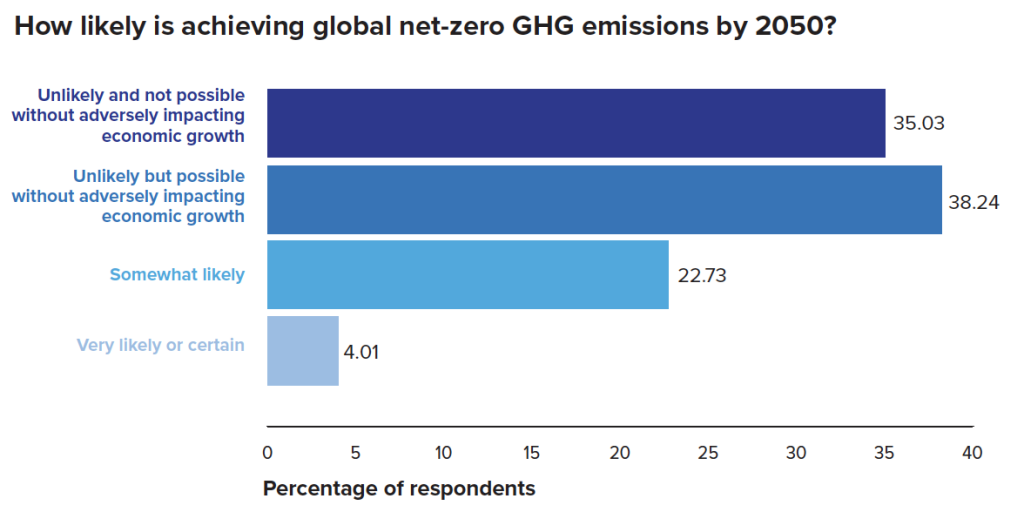
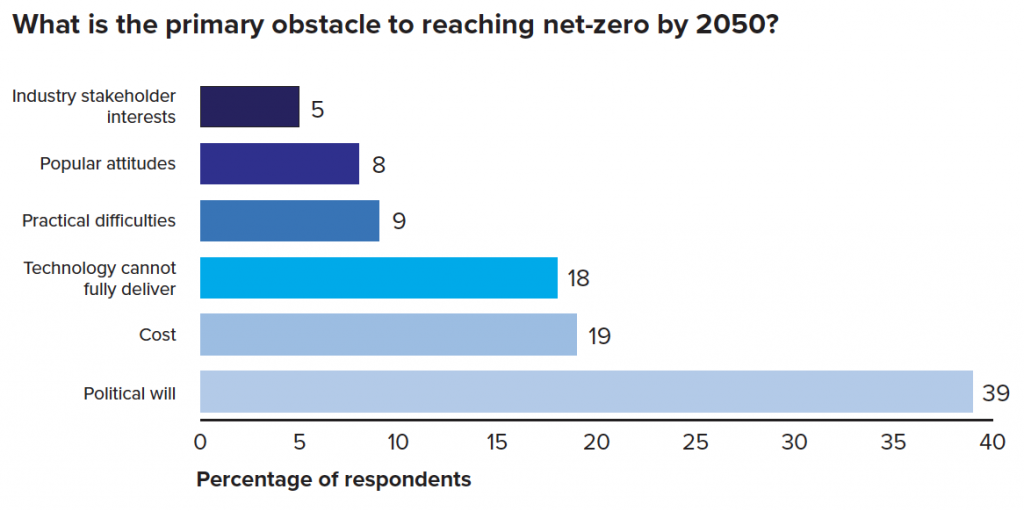
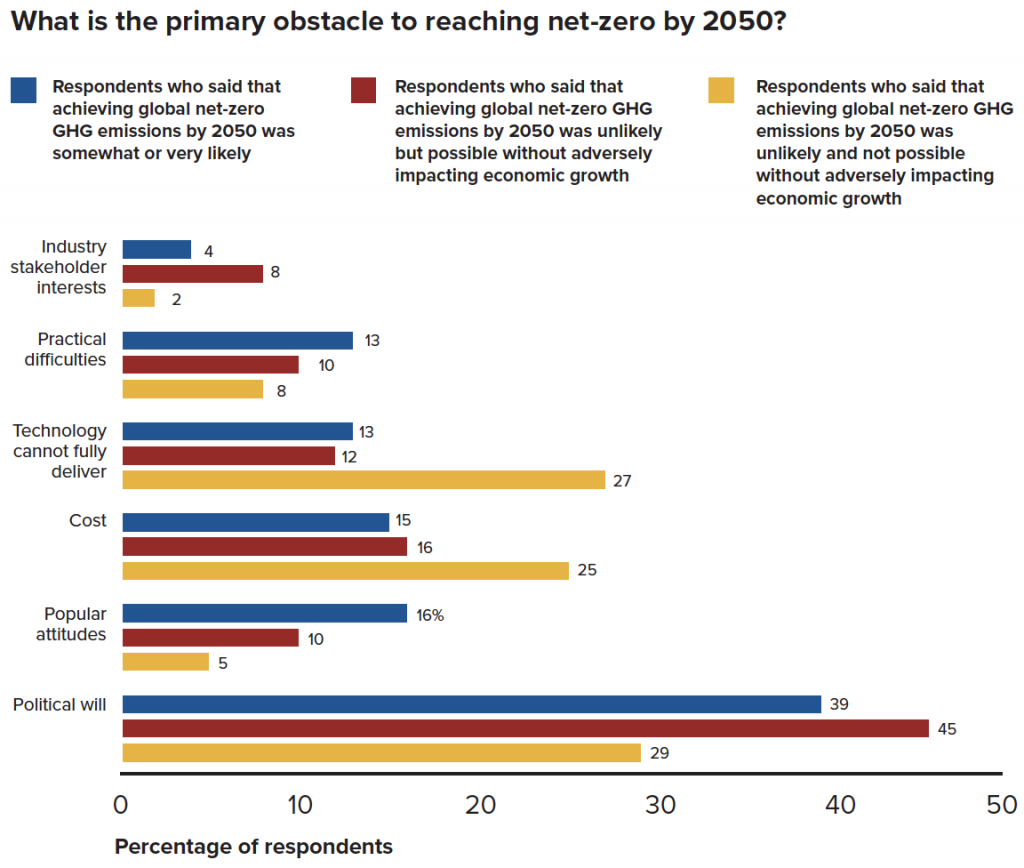
To better understand respondents’ thinking about the potential for net zero, the survey asked them to explain—in their own words—the primary barriers to reaching it. Our analysis coded these into broad categories: political will (including everything from general political will among many countries to attitudes of individual governments and international bodies); lagging technology (covering those who believed clean energy technologies could never deliver the power the world needs to those who thought demand is growing too fast for them to do so by 2050); attitudes within populations (including lack of interest, unwillingness to pay, and fear of nuclear power); energy industry pushback and entrenched interests; and the inherent difficulties of carrying out such a transformation given the drag of existing infrastructure and scope of the challenge. Some comments contained more than one of these; others, none.
The biggest issues overall—political will and cost— come as no surprise. Far more illuminating is how views on these barriers diverge between those who see net zero as likely, those who believe it unlikely but possible with little economic cost, and those who think it unlikely and also a costly pursuit.
For those who think net zero is likely or possible without negative economic impact, political courage and vision are, by a substantial margin, the key requirements for change; the other issues pale in comparison. Typical of the comments from this group about the leading barriers to success are that they boil down to “the inability of political leadership to take bold measures with an impact only years to come” and a “lack of courage to adopt the necessary measures.”
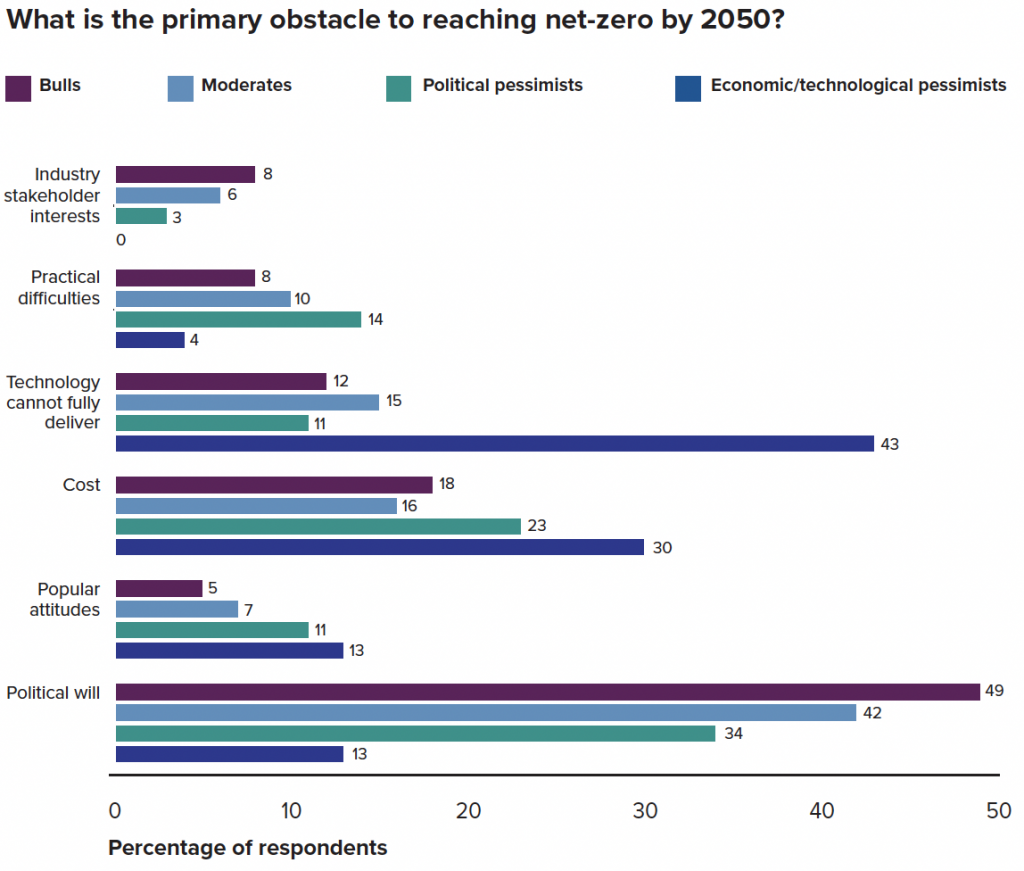
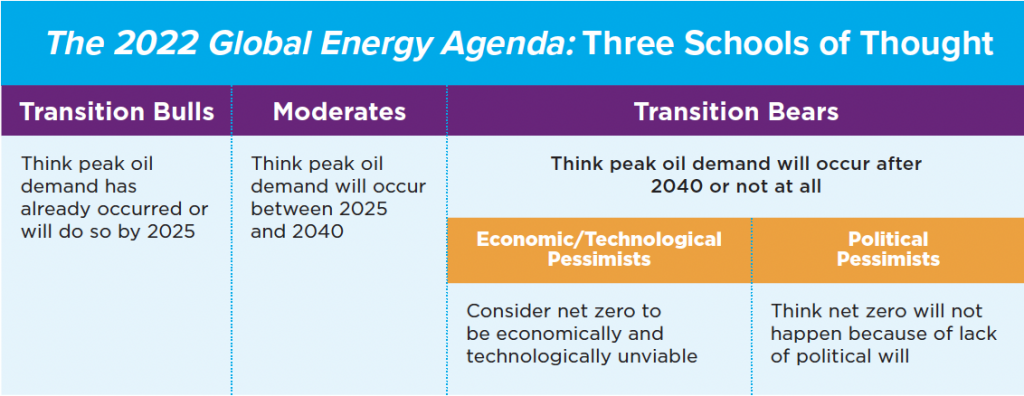
For those who consider net zero impossible without an adverse effect on growth, political will matters, but so do prohibitive cost and an expectation that green technology will not deliver the energy needed.
This divergence is even more pronounced when seen through the prism of attitudes toward the future of peak oil demand. The accompanying chart looks at the responses for our transition bulls, moderates, and bears, but divides the latter between two groups we call economic/technological pessimists and political pessimists, where we find a meaningful difference in the reasoning for their pessimism.
This difference— not visible in the 2020 survey because of the size of our survey sample—suggests there is one group of transition bears who consider net zero to be technologically and economically unviable (the “economic/ technological pessimists”), and another whose pessimism about the future arises from pessimism about human, especially political, behavior (the “political pessimists”).
The political pessimists differ little from the transition bulls and moderates on barriers to net zero. Economic/technological pessimists—who make up 13 percent of the entire respondent pool—operate on fundamentally different premises. For them, political will is almost irrelevant. Oil and other fossil fuels will have staying power because clean technology is unlikely to deliver the goods; politicians who try to bring about change in such an environment will not be far-sighted leaders but more akin to King Canute ordering tides. As one respondent put it, the key barrier is “the reality that fossil fuels are abundant, reliable, affordable, and proven for economic development, and renewables cannot substitute for them.” Or, as another said more succinctly, “we need fossil fuels to run economies.”
In line with the optimism at the beginning of 2021, many leaders pinned their hopes on COP26. For instance, in May, COP26 President Alok Sharma said, “The days of coal providing the cheapest form of power are in the past … So let’s make COP26 the moment we leave it in the past where it belongs.” Of course, COP26 was far more of a mixed bag, with parties declaring a “phase down” instead of a “phase out” of coal, for instance.
It is at least fair to argue that there were significant accomplishments at COP26, and that expectations were simply set too high. Our 2020 respondents certainly were skeptical heading into the COP. For example, only 11 percent thought that the meeting would achieve a consensus on global carbon trading under Article 6 of the Paris agreement. Here Glasgow exceeded expectations, with the relevant rule book now finalized. In her essay on carbon markets, Rachel Kyte, dean of the Fletcher School and former CEO of Sustainable Energy for All, addresses how voluntary carbon markets can complement future Article 6 markets and can be used to fund clean, distributed energy in regions that are most lacking, especially sub-Saharan Africa and South Asia.
2 We do not do this for the bulls and moderates as it reveals no meaningful differences.
How voluntary use of carbon markets can help secure sustainable energy for all
By Rachel Kyte
In 2021, the debate around whether voluntary carbon markets would support or delay urgent climate action came to a head due to countries’ increasing and unmet needs for financing and an unprecedented surge in private sector net-zero commitments, including those by the financial sector.
The long-overdue agreement on the Article 6 rulebook at COP26—rules for international carbon markets—provides renewed confidence that carbon credits may play a credible role in decarbonizing the global economy.
But there is much work to be done to ensure that carbon markets are purposeful, i.e., that they reduce emissions and share the benefits with those who have rights to land, sea, and resources. 2022 is crucial in reaching an agreement on achieving integrity in the voluntary use of carbon markets and ensuring the revenues can be used for resilience and speeding energy transitions.
This trajectory for carbon markets opens opportunities for the energy sector in two ways. First, firms can use carbon credits above and beyond decarbonization as part of their transitions, demonstrating credibility. Secondly, voluntary carbon markets can open funding flows to enable clean energy infrastructure in developing economies.
We will only realize these opportunities if we build carbon markets on a foundation of inclusivity and integrity. Inclusivity and integrity are end-to-end prerequisites and will be equally important for those who supply the carbon credits and those who buy and make claims based on them.
Opening up new finance flows to accelerate energy access
Despite early voluntary carbon markets and the Kyoto Protocol Clean Development Mechanism’s focus on renewable energy, over the last few years, voluntary carbon markets have, for the most part, become synonymous with offsets based on protecting and restoring nature.
But, given that projects to generate credits in a high-integrity market must be additional—meaning they would not happen without finance from carbon credits—opportunities abound in the energy sector. In particular, carbon markets could bring a much-needed revenue stream to scale distributed renewable energy infrastructure that might not yet be commercially viable, including those that serve the bottom of the pyramid (for example, scaling the distribution of clean cookstoves). There has been plenty of innovation and experience in the last several years on which we can build.
In my previous role as CEO of Sustainable Energy for All, I saw firsthand the transformative impact of energy access, the resilience that distributed renewables and clean cooking solutions build, and the impact of these efforts on women’s leadership roles within society. Amid the pandemic and with extreme heat on the rise, energizing health systems, reaching the poorest through safety nets with bundled energy and clean cooking, and ensuring access to sustainable cooling are essential elements of resilience in the climate crisis.
We know those without energy are predominantly women in sub-Saharan Africa and South Asia, either living beyond or below the power lines of expensive, low-performing grids. SEforALL and Climate Policy Initiative’s finance tracking published in Energizing Finance reports shows that despite international pledges, the funding for decentralized renewable energy and clean cooking is still too little and too slow for the task at hand. And it is still not a domestic funding priority for many governments. Voluntary use of carbon markets may provide a timely new revenue stream.
Putting voluntary carbon markets on a runway to regulation
While voluntary carbon markets are separate from future Article 6 carbon markets, the newly agreed-upon rulebook establishes guidance to deliver carbon trading aligned with the goals of the Paris Agreement. Therefore, voluntary use of carbon markets cannot undermine the goals of the Paris Agreement and the future Article 6 market that stems from it.
Put another way, voluntary carbon markets can form a runway to regulation and may become part of—or be closely aligned with—future Article 6 carbon markets. How long a runway depends on leadership from governments in putting effective carbon pricing in
place and on initiative from stakeholders committed to forming high-integrity markets.
The Voluntary Carbon Markets Integrity Initiative (VCMI) aims to establish guardrails for private sector climate action claims, like “net-zero,” “climate-neutral,” or the many variations on that theme. These claims will need to be aligned with the Paris Agreement, meaning that carbon credits are being used above and beyond action to meet a science-based abatement pathway. In short, carbon credits must not replace, delay, or obscure decarbonization.
The first step in establishing these guardrails will come in April 2022 when VCMI publishes draft practical claims guidance for firms on how and under what circumstances they should use carbon credits and the claims they can credibly make about this use.
At the same time, we must ensure that rightsholders are at the core of the design and regulation of these markets. The onus to deliver this is not just on project managers or regulators; firms that use carbon credits are accountable for what happens on the ground.
Decarbonizing energy systems that work for all is critical for sustainable development. As we move along the runway to regulation, high-integrity, voluntary use of carbon markets may smooth the shift to clean, affordable, and reliable energy systems for everyone.
Rachel Kyte is dean of the Fletcher School at Tufts University and previously served as special representative of the UN secretary-general and chief executive officer of Sustainable Energy for All (SEforALL).
Agreements on coal and methane were among the other outcomes, although the strength of these agreements, and the extent to which states are likely to adhere to other long-term commitments made at the meeting, remain up for debate.
Overall, this year’s survey respondents do not appear to consider COP26 to be an impressive milestone toward a new energy future. We asked them to assess its outcome on a numeric scale where one described the event, per Greta Thunberg, as “more blah, blah, blah” and five indicated that COP26 created a “firm foundation for achieving net-zero globally by 2050”.
The assessment was noticeably more negative than positive. Over half (51 percent) characterized the outcome of COP26 as yet more blah, blah, blah. Most of the rest (38 percent) put it half-way between the two choices, and just 11 percent considered it a solid foundation.
In every subsection of the energy sector that we look at in this analysis, those with a downbeat assessment outnumbered those who saw the progress as substantial. Two groups that were less negative, however, are worth noting.
First, European respondents were noticeably more sympathetic to the results of the meeting. More than one in five (22 percent) answered with a four or five on our scale, and only 35 percent rated it toward the “blah, blah, blah” end. This is still an overall negative result, but it contrasts sharply with the US respondents of 9 percent and 55 percent respectively. Results from the Middle East respondents—15 percent and 44 percent—were somewhere in between.
Secondly, attitudes about the future of fossil fuels and carbon also have a marked impact on assessing whether a result—which conventional wisdom deems largely mixed—represents progress or hot air. As the chart shows, there is a noticeable difference in how positively our transition bulls, moderates, and bears see the outcome of COP26. For our transition bulls, while not everything they hoped for, 18 percent believe that Glasgow represents more of a firm foundation for progress than yet more talk of little consequence. Among the economic/technological pessimists, fully 77 percent characterized it as “blah, blah, blah.” Presumably, a greater belief that these efforts can make a difference increases the sympathy of those judging their value.
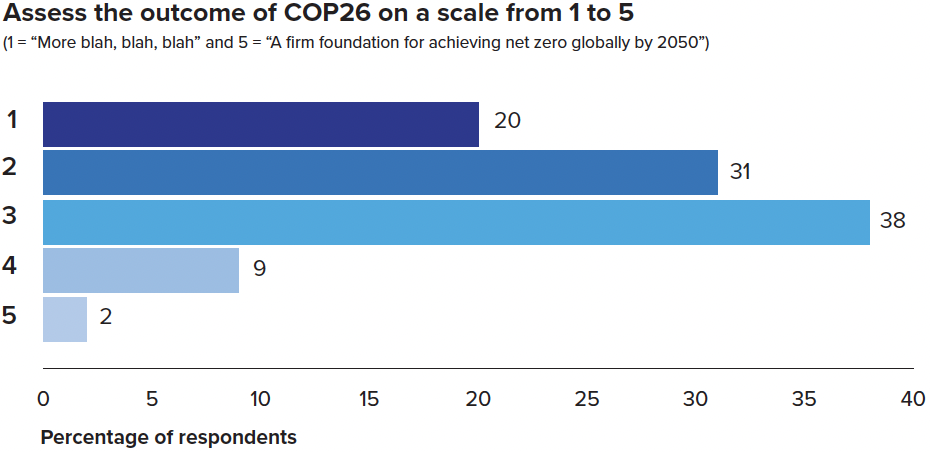
Regardless of one’s take on COP26, there is a tremendous amount of work to do. Our essay contributors provide a number of ideas for immediate and long-term action.
First, in an interview moderated by Atlantic Council CEO Fred Kempe during Abu Dhabi Sustainability Week, COP26 President Alok Sharma, COP27 President and Egyptian Foreign Minister Sameh Shoukry, and UAE Special Envoy for Climate Dr. Sultan Al Jaber lay out their vision for how to build on COP26 to have success at COP27 in Egypt and COP28 in the UAE.
Then, International Energy Agency (IEA) Executive Director Fatih Birol provides his take on COP26, which is far more positive than negative, and outlines several key actions the IEA is taking to accelerate progress on net zero.
The Rt. Hon. Charles Hendry, former UK Minister of State for Energy at the Department of Energy and Climate Change, discusses conversations that happened on the sidelines of COP26 at the Climate Action Solution Centre, where a group of global stakeholders gathered for 12 days to discuss crucial climate issues that could not be addressed under the auspices of the COP.
Jonathan Maxwell, the CEO of Sustainable Development Capital, follows up with a deep dive on energy efficiency, a crucial topic we discussed at CASC but that gets short shrift in international climate conversations.
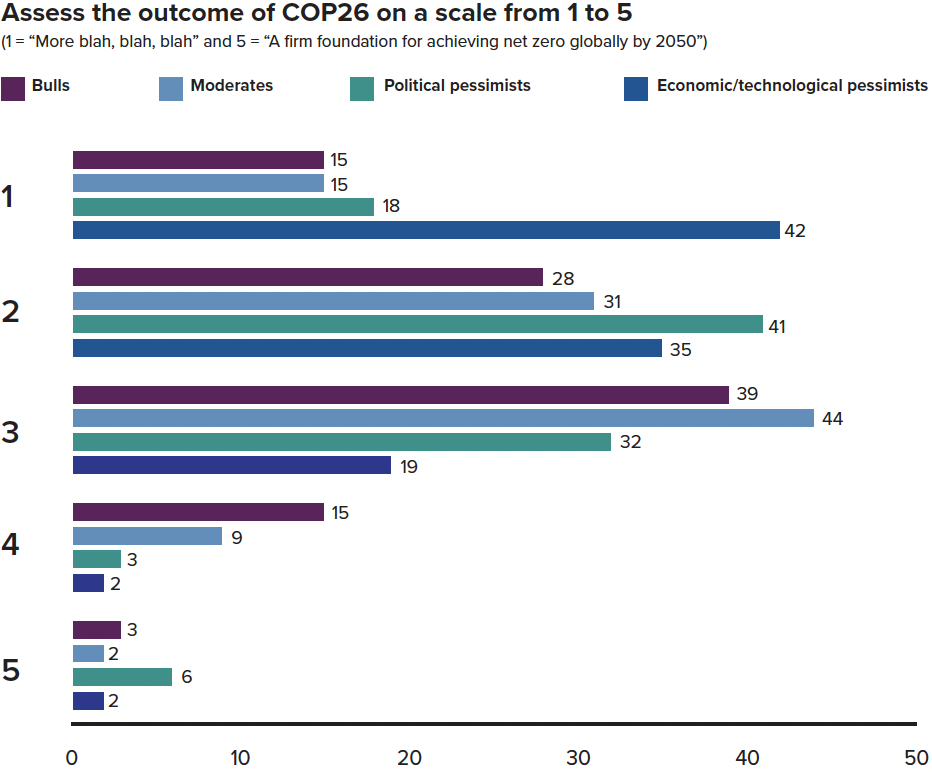
Finally, Sama Bilbao y León, the Director General of the World Nuclear Association, discusses the importance of nuclear power in meeting net-zero goals; and Tatsuya Terazawa, Chairman and CEO of the Institute for Energy Economics Japan, takes a look at nuclear power in Japan and the complicated role it plays in Japan’s net-zero ambitions following the Fukushima Daiichi accident.
Projecting COP ambitions across COP27 and COP28
A conversation with: H.E. Dr. Sultan Ahmed Al Jaber, Rt. Hon. Alok Sharma MP, H.E. Sameh Shoukry; moderated by Frederick Kempe
This conversation has been edited for brevity and clarity.
Fred Kempe: The success of future COPs relies on sustaining the momentum of those past and identifying pathways forward for the social, environmental, economic well-being of the global community. Think of it as a sort of relay race for the future, and we have three individuals here, very important individuals, passing the baton to each other. I would like to ask each of you to give a brief review of COP26. What did it accomplish? Where did it fall short?
Rt. Hon. Alok Sharma: We set out very early on in our presidency what we wanted to achieve at COP26. Our overarching ambition was to ensure that we kept 1.5 [degrees] alive and what that means is that the Paris Agreement said that world leaders should work together to limit global temperature rises to two degrees and—aiming for well below that—1.5. And that’s why keeping 1.5 alive was so important for us. The way to deliver that was to get much more progress on emission reduction commitments, on finance to support developing nations, on getting support for adaptation and then, of course, to close off the outstanding elements of the Paris rulebook so that that could be operationalized.
If you look at before Paris, the world was heading towards four degrees of global warming by the end of the century. After commitments at Paris, it was at around three degrees. And now, if you take the commitments made in the lead up to COP26, we are heading to below two degrees. So we kept 1.5 alive.
I would just say that we live in a fractured world in terms of politics. And yet, we had almost 200 countries coming together and ensuring that we were tackling this global problem together. So, I think we can be very proud of what we achieved in terms of the Glasgow climate pact.
When we took on this role, less than 30 percent of the global economy had a net-zero commitment. We now have 90 percent. We’ve got a commitment for countries to phase down coal use. For the first ever, in any of these COP processes, we’ve ensured that the $100 billion funding will be delivered by 2023 to developing countries, maybe earlier and, indeed, developed countries agree to double the amount of adaptation finance support to those countries. And we’ve got various work programs in place as well on driving action on adaptation, on loss and damage.
What we achieved is historic. But I also said in Glasgow that this is a fragile win. And that’s because we now need to spend the coming years ensuring that all these commitments are translated into action. And that, frankly, is what the world demands, and that’s what the populations demand.
H.E. Sameh Shoukry: Let me start by congratulating Minister Sharma of the United Kingdom on the success of COP26, both in terms of the substance and what was achieved. And I believe it was important that COP26 was held after a hiatus of about two years due to the COVID-19 pandemic and the lack of engagement at the multilateral level on climate negotiations. There was a particular need at this juncture to finalize the very last outstanding elements of the Paris Agreement work program, and we hope that COP27 will be equally successful, both from a logistical and a substantive perspective.
I think Glasgow was an important step in the direction we need to be taking on global climate action, that is to say, from pledges to actual implementation on the ground. And I think the main element in COP26 is to finalize the provisions on the markets, transparency, and common timeframes for NDCs. It is important that there shouldn’t be any further delay in implementation. What the world needs today is to focus on implementing commitments outlined in NDCs conclusively and expeditiously on issues of mitigation, adaptation, and providing climate finance to developing countries.
More importantly, outcomes from Glasgow reflected the clear political commitment from all parties to step up climate action on all fronts. The call to submit enhanced NDCs, and to phase out unabated coal power and inefficient fossil fuel subsidies are all steps in the right direction.
In addition, we are also very encouraged by the launch of the comprehensive two-year Glasgow Summit – Sharm el-Sheikh Work Program on the global goal on adaptation, as well as the initiation of deliberations on a new collective qualified role on climate finance.
For all of these reasons, we were satisfied with the COP26. Of course, there are issues pertaining to the developing countries’ ambitions and expectations that we hope will be further developed in the subsequent negotiating process. But we recognize that, in the multilateral negotiating context, we should address—especially in view of the dramatic events of the last two years in terms of climate change—that we need to move in the right direction with the necessary political commitment. And I think that Glasgow provided us the groundwork for future endeavors in this regard.
H.E. Dr. Sultan Al Jaber: It is clear, especially now that the dust has settled, that COP26 was a very good steppingstone. In our view, it was a success. It helped instill the sense of urgency across the board. Glasgow united 90 percent of the world’s economy on the path to net zero and that is a phenomenal achievement. The international community made significant global deals on meeting emissions reductions and forest protection. And of course, we got closer—even if not the whole way—to reaching the $100 billion target for climate financing.
COP26 also succeeded in launching many partnerships and coalitions between governments and the private sector to accelerate progressive innovation, like Aim for Climate, which we in the UAE are proud to be part of. It was launched by the US, and thirty-four other countries have joined us in this very important initiative. And, critically, COP26 finally reached a deal on Article 6 of the Paris Agreement. That is a very, very critical success factor because it lays the foundation for effective carbon markets. All of this creates great momentum and a great platform that Egypt and the UAE can, should, and will build on for the progressive approach we are adopting for COP27 and COP28.
Fred Kempe: Egypt’s proposal for the COP27 presidency was “Road to COP27: A United Africa for a Resilient Future.” So, resilience underlines the move toward adaptation. Could you talk about how you look ahead to November 2022 and your biggest priorities in Sharm El-Sheikh?
H.E. Sameh Shoukry: I believe that COP27 will be very important in terms of setting the stage and direction for global climate action in this critical decade. Leading up to 2030, COP27 will be the first step in what we believe should be an implementation decade. The world’s collective effort to implementing NDCs under the Paris Agreement should be stepped up, starting at Sharm El-Sheikh. It will show parties that they should be coming with enhanced ambition in all fronts of the war against climate change, whether in terms of mitigation, adaptation, or climate finance.
COP27 will also build on the outcomes of Glasgow. As the COP-designated presidency, Egypt will focus on achieving progress on the mandates coming from COP26, including the global build-up of adaptation and the new goal of climate finance. This global stocktaking is also an important part of the promises that should be made in in this area, in Sharm El-Sheikh, to allow for assessing where we are and where we need to be implementing the Paris Agreement and achieving its goals.
The impacts of climate change are felt universally all around the world, and those affected most are ordinary men, women and children, and their voices should be heard. We will provide the opportunity for all the stakeholders to be heard loud and clear and to have the necessary impact on the decision makers. It’s important, since their livelihoods are at stake, their wellbeing, and that of their children will be affected.
We believe in strengthening the role of youth and civil society, and we are glad that the first Climate Youth Forum will be convened in Egypt this year. We commit to continuing to engage with the young people around the world, and we believe that this is again an aspect that future COPs should concentrate on.
Fred Kempe: Dr. Sultan, congratulations as well to you on the UAE having the COP28 presidency. You were the first country in the Middle East and North Africa to sign the Paris Agreement, and the first to make a commitment to net-zero by 2050. With this momentum, what will your approach be to COP28?
H.E. Dr. Sultan Al Jaber: Let me respond to your question first by saying that we take on this role with a great sense of responsibility. And as such, I would like to take this opportunity to thank the Asia-Pacific Group of Nations and the UNFCCC Secretariat for the trust they have placed in us.
COP28 is going to be a crucial COP. It will mark the first ever global stocktaking that will show us how we are tracking towards the Paris goals, whether it’s on mitigation, adaptation and, of course, on finance. Critically, it would also set the roadmap towards 2030 and beyond. The work towards a successful stocktaking starts now, and I can comfortably tell you that we have already started working very closely with our colleagues and friends in the UK and in Egypt to make sure that all countries continue the momentum of COP26, especially in aligning the international community around net zero by 2050.
But there is also another dimension that we want COP28 to be defined by, and that goes beyond policy objectives to practical outcomes. We want Abu Dhabi to be where countries turn pledges into concrete results. So, we want this to be the start point that will translate policies, strategies, and plans into real action that will deliver tangible results. Of course, we also want to help take commercially viable climate solutions to scale around the world, especially where they are really needed. This is why we want COP28 to build on the momentum and the excitement created at COP26. We want to build on the progress and the momentum that will be achieved and clearly demonstrated through COP27.
And we want COP28 to be as inclusive as possible, reflecting the views of developed nations alongside developing countries, and also reflecting public and private sectors, scientists and civil society. By inclusive, I mean the expertise that is required to help us prepare for this very important transition. In the energy space, the hydrocarbon industry will have to be included as part of the mix because if we want to successfully transition to the energy system of tomorrow, we can’t simply unplug from the energy system of today, and we can’t do this with a flip of a switch. So, we need to take time. We need to consult and engage all those relevant. We need to include the energy experts in the discussions early to make the current system work more efficiently with much less carbon. We should, of course, leverage expertise from across the energy sector to help find meaningful, practical climate solutions that we all need. We should always remember that our goal is to hold back emissions, not to hold back progress or economic development.
Fred Kempe: Dr. Sultan, what a wonderful comment on holding back emissions but not holding back progress. Mr. Sharma, how do you see the UK working with Egypt and the UAE to capitalize on the fact that the next two COPs are in the Middle East and North African region?
Rt. Hon. Alok Sharma: We are working very closely with our friends in Egypt and the UAE, and I think it’s been a very constructive dialogue with both countries leading up to COP26. My first international travel after COP26 this year of course is Egypt and the UAE, and I hope that demonstrates the fact that we want this partnership to work really well. I’ve been so encouraged by what Mr. Shoukry and Dr. Al Jaber have said about their ambitions for COP27 and COP28. And there’s no doubt that what they are looking to achieve is far more ambitious for COP27 and COP28. And honestly, that’s what we had going into Glasgow with the real ambition for COP26.
And if I may just reflect on one of the key elements that my colleagues and friends have talked about is the power of the private sector. If we want to be on the pathway to limit global temperature rises to well below two degrees—aiming for 1.5–we need to halve global emissions by 2030 relative to what they were in 2010, and to be able to do this we need to get the private sector on board.
And I have to tell you, over the past couple of years and at COP26, we saw the private sector stepping forward. We now have a hundred and thirty trillion dollars of assets from the private sector committed to getting to net zero by 2050. I think this is a really exciting part of what came out of COP26, and I’m sure this will be taken forward at COP27 and COP28 as well.
Dr. Al Jaber, as you talked about, the thing that we wanted to do is to get emissions down. And one of the really important achievements of COP26 was an agreement to have this ratchet, whereby every country’s ministries agree to look at the 2030 emission reduction targets and see whether those would be revised by the end of 2022 so they align with the Paris temperature goals. I think this is an area where we need to work closely together, and I’m really excited about this partnership that we have with two very close friends. And I have no doubt based on what I’ve heard from both of my friends, that they are absolutely committed to having real success at COP27 and COP28. And ultimately, the aim of that, of course, is to deliver a cleaner world, a more prosperous world, and a world that is focused on green growth.
Fred Kempe: Obviously, this is a very special dynamic that we’re going to have the next two COPs in the Middle East and in Africa. How do you feel the region can take advantage of this? And where do you feel most optimistic and where do you see the greatest areas in need of work?
H.E. Sameh Shoukry: Our region continues to be highly affected by the negative impacts of climate change, and Egypt belongs to two regions that are most affected: Africa and the Mediterranean. And as COP President on behalf of Africa, we believe it is our responsibility during COP27 to highlight the priorities of the continent, which has suffered the most and which has contributed the least to the problem that we are facing. In this context, we believe that hosting the COP in Africa hosting represents an opportunity to frame the impacts of climate change and to promote and support the exemplary efforts that African countries have taken to address climate change and to adapt to the impacts in accordance with the Paris Agreement, despite the strains that climate action put on their limited resources.
We can also see that there’s a silver lining in addressing climate change in the Middle East and Africa, expediting the green transformation to the benefit of our economies. We believe there’s a great potential to take advantage of the resources that are available to provide green jobs and to provide opportunities to generate the development ambitions of the African and the MENA regions. We hope that this process will continue to address the vulnerabilities that exist and the necessity to provide resources for the countries most affected.
H.E. Dr. Sultan Al Jaber: The focus on our region in the next three years is an important factor that we should capitalize on. This region has specific advantages that can help accelerate the energy transition.
Firstly, as long as the world continues to rely on oil and gas, we can play a very critical role in helping ensure reliable supplies of the least carbon-intensive oil and gas, and we can make sure that this is available to the market where it’s needed. We are, of course, leveraging this position to drive down carbon intensity through the expansion of many, many initiatives and projects such as carbon capture and storage. We’re also investing in our capabilities in hydrogen, green and blue.
Egypt has been very successful in developing a comprehensive holistic energy strategy, and they are one of the countries that have access to high solar irradiance as well as high wind speeds. And they have been harnessing both solar and wind and playing a very important role in helping advance the renewable energy agenda in an effort to help mitigate climate change and reduce carbon emissions.
In the UAE, we have been investing in solar and wind, and we’ve been investing in the clean technology space for more than fifteen years. We have invested in more than forty countries. We today already have access to twenty-three gigawatts of clean zero carbon emission sources of power in forty countries. That positions us uniquely on the global renewable energy map. And only recently, three of the UAE’s energy giants joined in a strategic partnership to turn Masdar into a clean energy powerhouse. Now, this new supercharged Masdar is going to double its capacity to reach at least fifty gigawatts by 2030. This represents a very unique opportunity for Masdar and for its partners, as well as the region.
So, the energy transition has been embraced by this region and, in particular, in Egypt and in the Kingdom of Saudi Arabia, and of course, in the United Arab Emirates. We’re very serious in advancing this agenda. We see a unique economic development opportunity that is sustainable for the future. If we were to capitalize on our deep expertise, as well as the financial resources we have and the technology access—as well as the partnerships that we’ve been able to create over the years—and again globally, there would be at least three trillion dollars that will be invested in the renewable energy space over the next ten years. We in the UAE see this as a unique opportunity for us to capitalize on and seize with our partners. In fact, this is the thinking behind our net-zero strategic initiative. We see it as a new economic development opportunity that will help us create new industries, new skills, new jobs, new partnerships, and new models of engagement with relevant parties around the world. For us, the business of tackling climate change is simply a good business opportunity and, as such, we are aggressively approaching it.
H.E. Dr. Sultan Ahmed Al Jaber is the Minister of Industry and Advanced Technology; UAE Special Envoy for Climate Change; Managing Director and Group CEO of the Abu Dhabi National Oil Company (ADNOC); and Chairman, Masdar, United Arab Emirates. The Rt. Hon. Alok Sharma MP is COP26 President, United Kingdom. H.E. Sameh Shoukry is the Minister of Foreign Affairs, President Designate COP27, Egypt. ADNOC is a sponsor of the 2022 Atlantic Council Global Energy Forum.
COP26 did not deliver everything we wanted, but here is where key progress was made
By Fatih Birol
Climate change is perhaps the greatest challenge that humankind has faced and it is natural—and healthy—that our citizens demand strong action. Therefore, I understand the disappointment and frustration that some people expressed after November’s COP26 Climate Change Conference in Glasgow.
At the IEA, we did not rush into hasty judgments. After taking time to make a considered assessment, I would now say that COP26 actually achieved a lot. Even if it fell short of what we might have ideally hoped for, Glasgow delivered much more than many people perhaps realize.
There are three main areas where COP26 generated important momentum towards helping the global energy sector to reach net-zero emissions by mid-century.
Stronger ambitions
First are the important commitments we saw at the summit and in the weeks leading up to it. Countries that account for about 90% of the global economy have now committed to reduce their emissions to net zero. Of course, pledging to do something and actually doing it are not the same thing, and effective implementation of clear policies to back up these commitments is critical. But governments across the world are now clearly signalling to investors and companies that net zero is where we need to go.
More broadly, IEA analysis shows that if all the energy and climate pledges made by governments ahead of and during COP26 are met on time and in full, it would keep the rise in global temperatures to 1.8°C, the first time this projection has been below 2°C.3 We still have to do everything we can to limit global warming to 1.5 °C, but we still saw a significant step forward in terms of ambition at COP26.
Greater cooperation
We will not successfully reduce global emissions to net zero without strong international collaboration, and that is the second encouraging sign we saw in Glasgow. Two particularly important examples stood out for me. The US-China Joint Declaration was a major statement about the intention of the world’s two largest emitters to work together to accelerate their climate actions, which sends a strong leadership message to the world. And the Just Energy Transition Partnership with South Africa saw a number of countries and institutions coming together to support South Africa’s move away from coal in a way that also focuses on the social aspects of the clean energy transition. On a multilateral basis, the signing of the Global Methane Pledge by over one hundred countries was a major achievement that can make a vital difference to near-term global warming.4
Agreeing on the rules
A third area where I would like to note progress is on rules. A major task in Glasgow was to agree on how to implement different aspects of the Paris Agreement,
and COP26 clearly moved things forward on the inter national rulebook for carbon markets and other key elements. We also saw new mechanisms put in place to encourage countries to keep ratcheting up their commitments at future COPs, which can help close the gap between current commitments and what’s needed to bring us in line with a 1.5°C pathway.
I would like to be able to mention a fourth area, finance, but sadly the progress we saw on that front was not satisfactory. There is still a lot of work to do both in terms of mobilizing the amount of financing that is needed and in channelling it where it can make a real difference, notably in developing economies.
What comes next
As we look beyond COP26, we need to focus on implementation. We need clear and credible policies, major investments, and more clean energy projects and products rolled out around the world to replace the old polluting and emitting infrastructure in use today.
In this vein, I would like to highlight four new initiatives that we at the IEA are undertaking to support rapid and orderly clean energy transitions. Coal accounts for more emissions globally than any other single source and a major new IEA report in June will analyze in detail practical steps between now and 2030 to bring down emissions and air pollution from coal in line with our net zero pathway, while ensuring the transition is fair and affordable, especially for developing economies.
As the IEA’s Roadmap to Net Zero by 2050 shows, we are going to need to generate a lot more electricity on a path to net zero, and it will need to come from a range of low-carbon sources to ensure that supplies are reliable and affordable.5 I was encouraged at COP26 to see nuclear power returning to the fore in this conversation, and our new special report on Nuclear Energy and Net Zero in May will analyse this issue in depth, with a particular focus on the potential role of small modular reactors.
As I mentioned above, the signing of the Global Methane Pledge was a major step forward at COP26. To support the implementation of this pledge, we will be launching an expanded version of our Methane Tracker in February to include estimated emissions from coal, agriculture, and waste.6 And on the subject of tracking, the United Kingdom’s COP26 Presidency asked the IEA to lead global efforts to monitor progress on the Glasgow Breakthroughs, which are aimed at driving down the costs of key clean energy technologies. For this, we will track global progress in critical areas—such as power, road transport, steel and hydrogen—to determine whether it is in line with international climate goals.
In short, COP26 produced valuable progress that can help move the world towards a cleaner and more secure energy future, which is critical to addressing the threat of climate change. The key is for governments not to leave COP26’s gains as mere words, but to put them into action.
3 Fatih Birol, “COP26 climate pledges could help limit global warming to 1.8°C, but implementing them will be the key,” IEA Commentaries, November 4, 2021, https://www.iea.org/commentaries/cop26-climate-pledges-could-help-limit-global-warming-to-1-8-c-but-implementing-them-will-be-the-key.
4 “Executive Director joins world leaders for launch of Global Methane Pledge,” IEA, November 2, 2021, https://www.iea.org/news/executive-director-joins-world-leaders-for-launch-of-global-methane-pledge.
5 International Energy Agency, Net Zero by 2050: A Roadmap for the Global Energy Sector, May 2021, https://www.iea.org/reports/net-zero-by-2050.
6 International Energy Agency, Methane Tracker Database, October 7, 2021, https://www.iea.org/articles/methane-tracker-database.
Fatih Birol is the Executive Director of the International Energy Agency.
COP26 and the Climate Action Solution Centre
By Rt. Hon. Charles Hendry
As the owners of the Blair Estate, a castle just outside Glasgow, my wife and I were honored and delighted to host the Climate Action Solution Centre (CASC), an exceptional array of events on the sidelines of COP26 organized by a consortium including the Atlantic Council, Liebreich Associates, National Grid, and Octopus Energy. As global leaders from the public sector, industry, and civil society met in Glasgow to negotiate the Glasgow Climate Pact and make public commitments to decarbonization, we hosted some of the most influential decisionmakers for a series of private conversations intended to identify solutions to the thorniest climate challenges.
In a way, Blair Estate is symbolic of the approach that was needed to make the COP discussions successful. The house has evolved over 900 years with countless generations making individual decisions, which have led in time to the creation of the magnificent mansion and surrounding estate you see today.
It is that same spirit that was needed at COP, but on a much bigger scale, with global leaders coming together to make decisions which would be seen many years in the future as providing a turning point in the fight against climate change.
The house has never been so alive, with more than 1600 people coming through the doors over the twelve days of COP26. CASC brought together people from across the world to talk about what we need to do; who needs to do it; and how the whole process can be accelerated to meet the challenge.
And it was that concept of “solutions” that was at the heart of every discussion. There was an extraordinary buzz of positivity, of people saying that they know what needs to be done and how it can be achieved. The feedback after every discussion was that people felt more positive about what could be done rather than overwhelmed by the scale of the challenge.
The discussions—from early morning to late at night—looked at the same issues being addressed by the global leaders at COP26 itself on how we decarbonize our societies and our activities, such as energy efficiency, finance, hydrogen, aviation, methane reduction, critical minerals, and the future of fossil fuels.
The conclusions recognized that past COPs have failed to assign energy efficiency its rightful importance. Governments and capital markets all need to deliver more on energy efficiency to make sure we optimize the resources we use. In this regard, regulation will be necessary, and we need to address the issue of how to do this in a way that delivers a just transition and environmental justice.
It was absolutely clear that the financial community is now moving ahead of governments, recognizing the huge opportunities in the green economy. That will mean we will need to have better ways of comparing the actions of companies so investors and advisers can make effective comparisons. No one suggested that adequate funding was a barrier to delivering net-zero emissions by 2050; on the contrary, with $130 trillion reputedly available, the question is how to use that finance most effectively.
There was genuine debate around the role for hydrogen—its viability and the scope for green hydrogen at an affordable cost to replace gas—especially for industrial purposes. That debate mirrors the discussions in government and industry, but even if the solutions are not yet clear, it is an issue which is being discussed with a seriousness and commitment that was simply not evident just a few years ago.
The continuing role of fossil fuels was at the heart of many discussions; we grappled with ways to balance the need to move at much greater speed towards low-carbon solutions whilst ensuring that such ambitions remain deliverable. If anything, we would have welcomed more participation by the industry in the discussions in and around COP, as it will play a central role in determining the speed of change and how traditional sectors can become green.
It was recognized that the supply of critical minerals will determine the pace of progress. An estimated three billion metric tons of critical minerals will be needed to achieve the Paris Agreement goals by 2050, but at present the broader ESG issues are unclear, with insufficient focus on the environmental and working practices of procuring and processing the requisite minerals at scale.
There was, rightly, discussion about tackling methane emissions and especially how the Global Methane Pledge can be extended to include current non-signatories. The immediate requirement is more accurate monitoring and verification, so that any carbon border tax or adjustment policies can be effective.
We looked, too, at how nature-based solutions can be encouraged, and how the accounting mechanisms might be made less challenging. Again, measurement will be key to success.
For aviation, the focus was on how the provision of Sustainable Aviation Fuel (SAF) can be massively developed and then combined with the need for the right policy signals from government to drive investment decisions.
For us, as the owners of Blair, it was exactly what we had wanted to achieve with the house. We wanted to show that one of Scotland’s most historic houses could be at the heart of finding solutions to the challenges of the 21st century. Judging by the level of enthusiasm and the desire of so many people to repeat the exercise and maintain the momentum, we hope that goal was shared by our guests as well.
The Rt. Hon. Charles Hendry CBE PC is a professor at the University of Edinburgh and is a former United Kingdom Minister of State for Energy at the Department for Energy and Climate Change. Charles and Sallie Hendry are the owners of the Blair Estate.
Resource efficiency is crucial for sustainable development
By Jonathan Maxwell
Efficiency first
Energy efficiency is one of the most important priorities for the global energy economy and policymakers in the coming decade. It should be at the very top of the agenda for all businesses and governments. The United Nations Climate Change Conference (COP26) in Glasgow called for energy efficiency improvements, alongside increases in clean power generation, as one of the last features included in the Glasgow Climate Pact and topics of the conference. This is most welcome, but in the future, it should be the first item on the agenda.
Everyone and everything depends on energy; modern society simply does not function or communicate without it. Energy sources are worth trillions of dollars and are one of the most valuable commodities in the world. It is at the heart of both the problems with and the solutions to climate change, involving at least half of global greenhouse gas emissions. Yet we waste most of it.
We must now re-focus urgently on energy efficiency for three key reasons. The first is security. The second is cost. The third, and potentially most universal in the long term, is carbon.
Security
Grids fail. Superstorm Sandy hit New York in 2012 with such a devastating effect, both economically and in terms of loss of life, partly because New York lost power. Fast forward to February of 2021, when the grid failed in Texas as a result of three severe storms, stranding communities and businesses and bankrupting energy companies. The problem hit Louisiana in the summer, and volatile supply is hurting California now. These failures were often related to climate, weather, or natural disasters. But geopolitical risks are just as serious, with scant natural gas supplies disrupting markets in Europe at the time of writing. Grid decentralization and energy efficiency can help address these problems. Conservation and on-site energy generation using local and renewable resources can deliver more reliable solutions that depend less, if at all, on the grid. Policymakers in Europe and the United States have now started to budget and legislate accordingly. China already uses energy efficiency policy to decouple energy demand from economic growth.
Cost
Utility energy prices are a function of the cost of generation, but also of the cost of maintaining centralized transmission and distribution through the grid, as well as tax and market incentives. These costs are too high because we waste two-thirds to three-quarters of energy before it gets to the point of use, through generation, transmission, and distribution losses associated with a centralized grid. These losses occur because energy is often sourced far from where it is used and where there is no use for heat that is produced along with the power, resulting in waste. Indeed, according to the World Economic Forum, some 70 percent of original energy is wasted in the United States, while more than two-thirds of original energy is wasted in Europe. Meanwhile, 70 percent of all energy is used in buildings, industry, and transport, not all of which are efficient. At least 20-30 percent is wasted through sub-optimal equipment such as lighting, motors, controls, heating ventilation, and air conditioning. Decentralization through on-site generation can slash losses on the supply side, while better and more efficient equipment can reduce waste on the demand side. Cutting energy waste reduces costs and improves productivity and profitability.
Carbon
The clock is ticking, and the science is clear. We have a very limited global carbon budget that we will have spent by the end of this decade, and we have no more than this next generation—i.e., the next twenty to thirty years—to decarbonize while transforming the way that we generate and use energy and other resources. The International Energy Agency states that energy efficiency represents at least 40 percent of the decarbonization needed in the energy sector by 2040.
Most companies and governments are committed to limiting global temperature rise to 1.5°C and to net-zero carbon by 2050. But there is simply no such thing as zero-carbon energy generation. Creating new renewable energy generation infrastructure emits carbon, and there are limits to its penetration over time. Today, 80 percent of the world’s energy system is still based on oil, natural gas, and coal, with massive associated investment in infrastructure and supply chains that will take time as well as money to decarbonize. Global energy demand is projected to rise nearly 50 percent by 2050. During this time, there is expected to be more growth in emissions from demand for cooling, which is set to triple, than there is from the entire energy demand from China and India combined today. Decarbonization is going to be a massive long-term investment and we should use energy efficiency to deliver and fund as much of it as possible.
We have to focus on reducing demand for energy and promoting the most efficient ways of generating, transmitting, distributing, and using energy with the best available technology. On-site generation and more efficient equipment in buildings in industry is a large part of the solution. So too is electrification of transport. ‘Well-to-wheel’ efficiency based on oil is some 15-30 percent compared to 75 percent plus from ‘wind-to-wheel’ electricity, and that is before we consider the pollution prevention benefits. Indeed, more people die from premature lung disease in cities than from road traffic accidents, and from war, terrorism, and murder combined. Energy efficiency does not rely on technologies that are yet to be invented, and it can be delivered now, often at lower cost and more reliably than business as usual. The cheapest and cleanest energy is the energy that we don’t use or waste. It is what the International Energy Agency calls the “First Fuel.” Energy efficiency provides the biggest ‘bang for the buck’ from a greenhouse gas emission reduction perspective and it should come first.
From energy transition to energy transformation
In the last decade we saw the market for energy efficient lighting grow from less than 2 percent penetration to over 60 percent globally. Today, electric vehicles are a mere 2 percent of US auto sales. There is a vacuum to fill. There will be a billion new air conditioners in the next five to ten years, and the fluorinated refrigerant gases associated with the old ones are thousands of times more potent than CO2. Methane, unless captured from oil and gas production and landfill sites, is eighty times more potent than CO2 over twenty years. The market for more energy efficient solutions is worth trillions of dollars, potentially two to three times the size of the renewable power market that is rightly attracting US$1-2 trillion per annum in new capital investment. The time to transform the way that we supply and use our energy has come, and we must do so urgently. This revolution involves doing more with less. It is highly profitable. The rewards could not be larger.
Resource efficiency is synonymous with sustainable development. It must come first.
Jonathan Maxwell is the CEO and Founder of Sustainable Development Capital LLP, which was a co-sponsor of the Climate Action Solution Centre.
Nuclear energy is essential to achieving a clean, affordable, and equitable energy system for the future
By Sama Bilbao y León
Nuclear energy offers a golden opportunity to build a cleaner, more equitable world, in which everyone has access to low-carbon, affordable, abundant energy and a high quality of life.
This opportunity comes at a time of need for urgent and realistic action on climate change. Throughout 2021—and at the COP26 conference in Glasgow—there was a clear recognition of the severity of impacts from climate change and a greater commitment from the international community to implement pragmatic approaches to achieving net-zero carbon emissions.
While achieving net-zero emissions by the middle of this century is critical to limiting climate change to 1.5 degrees Celsius, this alone is simply not enough. We must also ensure that the clean energy systems of the future are equally available to everyone in the world and that everyone has access to the around-the-clock reliable energy that powers quality of life in high-income countries.
Meeting this urgent and massive challenge requires an ambitious, pragmatic, and multi-pronged approach. No single energy technology can achieve this on its own.
Nuclear energy is currently the world’s second largest source of low-carbon electricity, meeting more than 10 percent of global electricity demand and accounting for more than 30 percent of global low-carbon electricity.7 Nuclear generation has provided reliable, clean electricity for decades, avoiding the emissions of more than 70 billion metric tons of carbon dioxide over the last fifty years.
We must use, as efficiently as possible, the low-carbon energy that we currently have, and put in place an aggressive action plan to deploy as much new clean generation as fast as is feasible at a global level. Maximizing the contribution of existing nuclear power plants is, according to the IEA, the most cost-effective low-carbon energy investment available today.8 Not only we can ill afford to lose such a significant source of emissions-free electricity, but existing nuclear power plants will be instrumental to help bridge the gap as we accelerate the deployment of new low carbon generation. With more than 75 percent of the global nuclear fleet under 40 years old, and the first approvals for 80 years of operation having been passed in the United States, there is every opportunity for these reactors to continue to produce low-carbon electricity well beyond 2050.
But if we are going to keep the 1.5-degree target within reach in a cost-effective and socially equitable manner, we will need much more energy, and we will need it urgently. The great news is that nuclear energy is one of the only technologies that can produce low-carbon electricity and heat, which could be a game-changer to decarbonize other hard-to-abate sectors beyond electricity, such as industrial processes, heating and cooling of buildings, and hydrogen generation.
According to the World Nuclear Association’s Harmony vision, to meet global decarbonization and sustainable development needs, nuclear energy will need to play a significant role, with more than 25 percent of global electricity generated by nuclear energy by 2050, along with a significant proportion of non-electric applications.9 This means adding about 30 GWe of nuclear power generation every year, which is ambitious but on par with the nuclear construction rates of 31 GWe per year achieved in the mid-1980s.
World Nuclear Association data show that there are currently over one hundred reactor units planned and a further 325 units proposed by governments around the world.10 Since COP26, we have seen a number of new proposals and policy announcements, indicating a growing recognition of the crucial role nuclear energy must play in the future. France announced that it would build new nuclear power reactors to maintain its energy security and to meet its climate change goals. US and Romanian companies announced a partnership to build a first-of-a-kind small modular reactor in Romania. The UK announced regulations to introduce a new funding model to attract a wider range of private investment for new nuclear power projects, as well as funding support for the development of domestic small modular reactor technology. The Netherlands announced plans to build two nuclear power stations in a bid to hit more ambitious climate goals. Poland continues aggressive plans to replace existing coal generation with nuclear plants, large and small. China reiterated plans to build 150 new nuclear units by 2050, while India announced a goal of more than 22 GW of nuclear capacity by 2031. Russia has a number of active nuclear projects both inside the country and abroad, such as in Bangladesh, Egypt, and Turkey.
In the year leading up to COP26, much has been achieved: in 2021, over 5 GWe of new nuclear capacity was connected to grids across the world, in China, India, Pakistan, and the UAE. Construction also began on an additional 6 GWe. Unfortunately, this is not close to the 30 GWe needed, making it crucial for governments to implement clear policy actions to accelerate the deployment of new nuclear.
We must establish human, physical, commercial, and institutional infrastructure that will allow the global nuclear sector to scale up fast to meet the need for urgent and massive decarbonization. A lot of the work should take place within the nuclear industry itself, making the most of lessons learned from recent first-of-a-kind projects and capitalizing on rebuilt capabilities and expertise. But government support will be indispensable: policies and market frameworks that establish a level playing field for all low-carbon technologies—and that instill confidence and a long-term vision for energy strategies—will be instrumental to incentivize investment in nuclear energy projects and associated supply chains, as well as to streamline licensing and regulatory systems.
Nuclear energy brings a unique combination of features essential to the energy systems of the future, and these features need to be recognized and adequately valued by policies and markets alike. Nuclear units can provide the flexible clean generation and spinning reserves needed to ensure the stability and reliability of electricity grids, particularly those with increased penetration of intermittent renewables, thus supporting the transition to a low-carbon energy system. Nuclear power plants produce 24/7 low-carbon energy, locally and independent of geopolitical pressures, the weather, or the season. They have an incredibly small footprint, in terms of land, fuel, and raw materials use, as well as the lowest lifecycle impacts of all electricity generation options.11 Nuclear power plants are cost-competitive, particularly when the costs and the stability of the system as a whole are considered, and bring long-term, well-paid, local jobs and significant socioeconomic development.12
Once the value of nuclear power is recognized by policies and markets, nuclear technologies will be able to play a major role in making a net-zero world with abundant, universal energy access possible.
7 International Atomic Energy Agency, Transitions to low carbon electricity systems: Key economic and investment trends, October 2019, https://www.iaea.org/sites/default/files/19/10/transitions-to-low-carbon-electricity-systems-key-economic-and-investment-trends.pdf.
8 International Energy Agency and OECD Nuclear Energy Agency, Projected Costs of Generating Electricity, December 2020, https://www.iea.org/reports/projected-costs-of-generating-electricity-2020.
9 For scenarios and forecasts of the role of nuclear energy to meet global electricity needs, see World Nuclear Association, “World Energy Needs and Nuclear Power,” updated in November 2021, https://world-nuclear.org/information-library/current-and-future-generation/world-energy-needs-and-nuclear-power.aspx.
10 World Nuclear Association, “Plans for New Reactors Worldwide,” updated in January 2022, https://world-nuclear.org/information-library/current-and-future-generation/plans-for-new-reactors-worldwide.aspx.
11 United Nations Economic Commission for Europe, Life Cycle Assessment of Electricity Generation Options, October 2021, https://unece.org/sed/documents/2021/10/reports/life-cycle-assessment-electricity-generation-options.
12 OECD Nuclear Energy Agency, The Costs of Decarbonisation: System Costs with High Shares of Nuclear and Renewables, 2019, https://www.oecd-nea.org/jcms/pl_15000/the-costs-of-decarbonisation-system-costs-with-high-shares-of-nuclear-and-renewables?details=true; World Nuclear Association, Employment in the Nuclear and Wind Electricity Generating Sectors, 2020, https://www.world-nuclear.org/getmedia/690859bf-ebe6-43a2-bedd-57ddf47ee3ac/Employment-in-Nuclear-Report-Final.pdf.aspx.
Sama Bilbao y León is Director General of the World Nuclear Association.
The role of nuclear power in Japan’s future energy system
By Tatsuya Terazawa
It was on March 11, 2011 that the Great East Japan Earthquake triggered an unprecedented tsunami, which reached fifteen meters high and hit the Tokyo Electric Power Fukushima Daiichi Nuclear Power Plant. The tsunami caused one of the most serious nuclear accidents in history. As more than ten years have passed since then, let me review the status of the nuclear power sector in Japan and the prospects for the future.
There were sixty nuclear reactors prior to March 11, 2011, all of which were taken offline after the accident. Since then, twenty-four nuclear reactors have been shut down permanently. Out of the remaining thirty-six nuclear reactors, ten units have been restarted, and seven units have obtained the authorization to restart. The applications for authorization for ten units are currently under review by the Nuclear Regulatory Authority (NRA), and the applications for the last remaining nine units have not yet been filed, waiting for the others to be processed by the NRA.
For those living outside Japan, the fact that ten units have already restarted may come as a surprise. Considering the public opposition against nuclear power that ensued from the magnitude of the accident, there are some people who believe that all nuclear reactors should still be stopped. However, the additional safety measures that have been put in place and their stringent review by Japan’s Nuclear Regulation Authority (NRA)—a newly established independent safety regulator—have persuaded the public to accept the authorization by the NRA on safety grounds.
Among the seven units with authorization to restart, four units are in the process of completing the necessary safety measures and three units have yet to obtain the go ahead from local governments. In some local regions, the public acceptance for nuclear power is still a challenge.
The review process for the ten units in operation took far much longer than originally expected, including more than seven years for seven of those units. For several locations, the “proof of non-existence” of active faulting has been difficult to establish, since experts cannot demonstrate the complete absence of seismic activities for the last 120,000 years. For many parts of Japan facing the ocean, which have had a history of rising and sinking, it is not easy to find layers of earth that are completely uninterrupted for longer than 120,000 years.
These barriers to nuclear restarts, however, do not change the fact that from a policy perspective, we need to restart the existing nuclear power plants for three reasons.
First, to achieve Japan’s very ambitious Nationally Determined Contribution (NDC) of 46 percent greenhouse gas (GHG) reduction, we are counting on nuclear power to provide 20-22 percent of our power supply by 2030. With ten units having already been restarted, achieving this share will require the restarting of all seventeen units currently authorized or under review. If we fail to restart any one of them, achieving our NDC will become even more difficult.
Second, to cushion the impact of price hikes in the oil and LNG markets and to help contain the increase in the cost of electricity, the expansion of nuclear power generation will be extremely helpful.
The third reason would be to avoid future situations like what is expected for this coming winter in Japan. Depending on various weather and economic conditions, the difference between supply and demand for electricity this winter will be the tightest in ten years. The retirement of a number of thermal power plants, mostly oil fueled, caused by severe competition resulting from the liberalization of the power market and the expansion of renewable power generation, is the immediate reason of this winter’s energy crunch. Without the restarting of the nuclear power plants,
such tension between supply and demand could be even worse in the coming years.
In addition to restarting, there is room for more power generation by nuclear power plants. The current capacity factor for nuclear power plants in Japan is about 80 percent, considerably lower than the 90 percent seen as standard performance in other countries, like the US. The main reason for this lower rate is due to the relatively short intervals between periodic inspections and the relatively long shutdown period for inspections. In Japan, after thirteen months of operation, nuclear units are stopped for three months for periodic inspections. In the US, nuclear units can be in operation for twenty-four consecutive months and can be inspected while in operation, reducing the period of stoppage for inspection to one month.
However, restarting the nuclear power plants and placing longer intervals between inspections are not enough. The current lifetime rule for the length of operation is forty years. Several nuclear power plants will face the forty-year limit before 2030 and many more will reach the limit after 2030. The current regulation allows the NRA to authorize a one-time-only extension of twenty years. A few plants have already received this extension, but many more plants still need to obtain it.
Unfortunately, this extension will only buy some extra time, as we will face an increasing number of candidates for retirement after 2040. Under the current rule, after sixty years (with a one-time extension), nuclear power units in Japan must be retired without exception. In the US, some nuclear power units are authorized to operate for eighty years. Many nuclear power plants in Japan have not been in operation for most of the ten years since the Fukushima accident. However, Japanese law counts the years when the plants were offline against the allowed period of operation. There is a legitimate argument for not counting the years during suspension, as the reactors were not exposed to neutrons. But this will require a legislative action to change the existing law. There must be strong political will at the highest level of government to realize this change.
Because of constraints on the expansion of renewable energies in Japan, the Institute of Energy Economics, Japan believes that nuclear power will have a significant role to play in realizing carbon neutrality by 2050. There is hope that fusion technology will be available in the future, but—as there is considerable uncertainty in the timing for the actual introduction of the technology—we must consider building new nuclear power plants and replacing existing ones. However, in the process leading to the decision for the Basic Energy Plan, which was approved by the Japanese Cabinet in October 2021, consensus on this point could not be reached within the Government and the ruling parties.
We understand that President Macron of France announced his decision in November 2021 to restart the building of new nuclear power plants in France. This marks a major shift from the previous policy to reduce the amount of nuclear power in France from 75 percent to 50 percent in its power mix by 2035. He also announced his decision to develop small modular reactors (SMRs). European Commission President Ursula von der Leyen that “we need a stable source, nuclear” in her press conference on October 22, 2021.The EU will include nuclear as a part of green taxonomy.
In Taiwan, taking lessons from a major blackout, a national referendum on whether or not to restart the construction of two nuclear power units was held on December 18, 2021. The referendum was defeated, but the vote was rather close. While 52.3 percent of the votes cast were against the restart, 46.7 percent were in favor. Had it been supported, the referendum could have transformed Taiwan’s policy from retiring all its existing nuclear power plants by 2025 to restarting construction of new nuclear power plants. It is noteworthy that the people of Taiwan are engaged in serious discussion about the future role of nuclear power.
We need to learn from the dramatic change in France, signs of change in the EU, and the serious debate that took place in Taiwan. I believe that Japan will soon have to seriously consider the option of building new nuclear power plants and replacing existing nuclear power plants if we are serious about reducing our carbon emissions while maintaining the competitiveness of our industries and protecting the daily lives of our citizens. I sincerely hope that 2022 will be the year when we can deepen our discussion on this issue.
Tatsuya Terazawa is the Chairman and CEO of The Institute of Energy Economics, Japan.
Chapter 2: Hydrocarbons and the energy transition
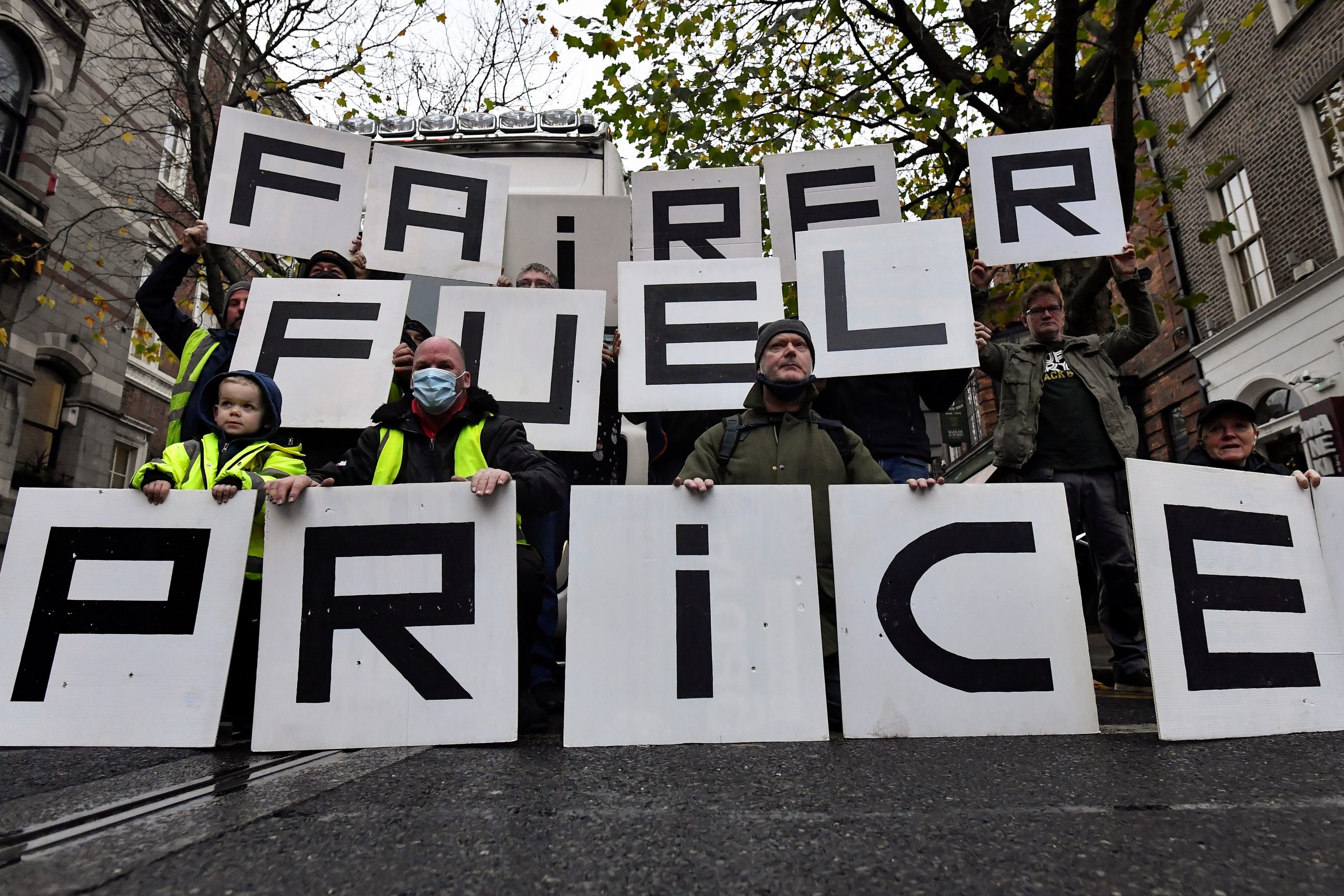
Hydrocarbons and the energy transition
Essays
Oil will continue to play a role in a low-carbon world
By H.E. Mohammad Sanusi Barkindo
Perspective on energy transition
By Mele Kolo Kyari
Partner perspective
This year proved that the world needs a smarter carbon transition strategy
By Majid Jafar
Partner perspective
From commitment to action: Driving the energy transition
By Tim Holt
Survey results
For those who might have thought otherwise, 2021 laid bare the critical role that hydrocarbons continue to play in the global energy system. After years of generally low hydrocarbon prices—and a historic drop in 2020 caused by COVID-19 lockdowns—prices spiked as demand came roaring back from 2020 lows. Even as clean energy deployment continues to grow at a record pace, oil demand is likely to surpass pre-pandemic levels in 2022, and coal demand might breach its previous 2014 peak. Natural gas demand likely exceeded pre-pandemic levels in 2021.
Experts disagree about the causes of the price spike, and there are surely several drivers. Some that have been proffered include: underinvestment during the recent low-price environment; climate policy and renewable energy; Russian market manipulation (which will be discussed in more detail in Chapter 3); OPEC+; and a production lag as producers struggled to keep up with rapidly-changing demand.
Across the energy sector, our survey respondents thought market fundamentals were the most common explanation for the current price spike in energy costs. About one in five respondents point to underinvestment in the sector due to pressure arising from environmental concerns. A similar number say that use of energy as a geopolitical tool is the key driver, while about a tenth blame profit-seekers.
We also asked respondents about their predictions for drivers of energy price volatility over the next decade. Market fundamentals remain the most commonly expected reason for volatility, but a larger number foresee both underinvestment and geopolitics having a dominant impact on the market (up to 29 percent and 28 percent, respectively).
These aggregate figures mask sometimes wide variations in views among survey respondents. These begin with differences related to geography.
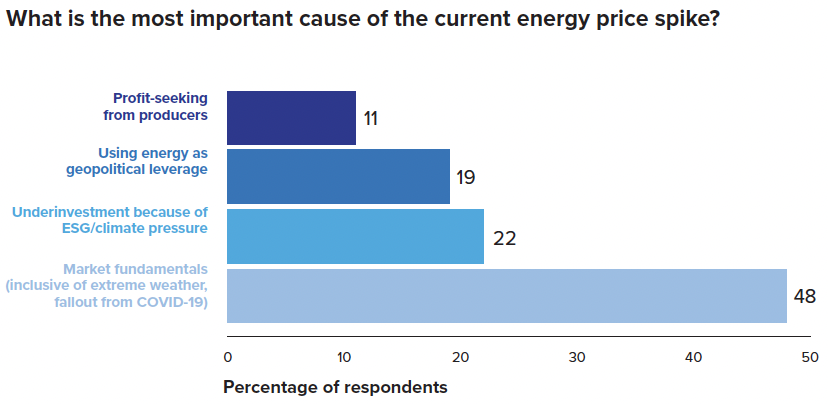
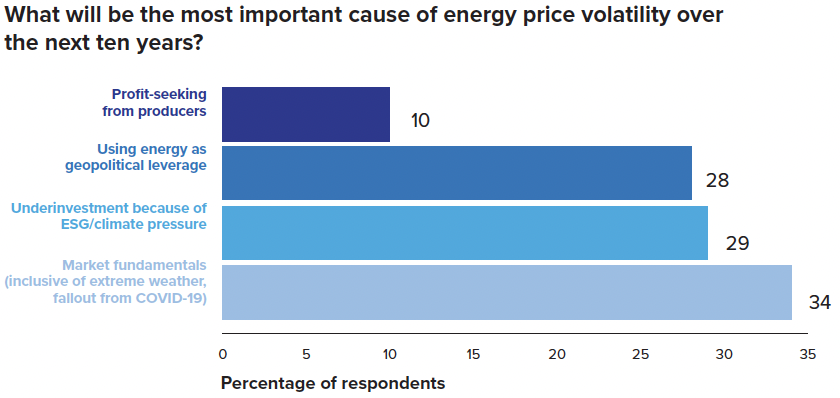
Although respondents in all three regions most commonly see market fundamentals behind current price issues, far more respondents in Europe (30 percent) than elsewhere point to the use of energy as geopolitical leverage. Similarly, the region has a higher proportion who see this issue as the driver of destabilized prices in the coming decade, although the difference is less pronounced. The most likely explanation is that Russia’s capacity to hold back natural gas supplies— with consequent price increases—as a way to secure foreign policy aims, including those related to the Nord Stream 2 pipeline, have focused European minds.
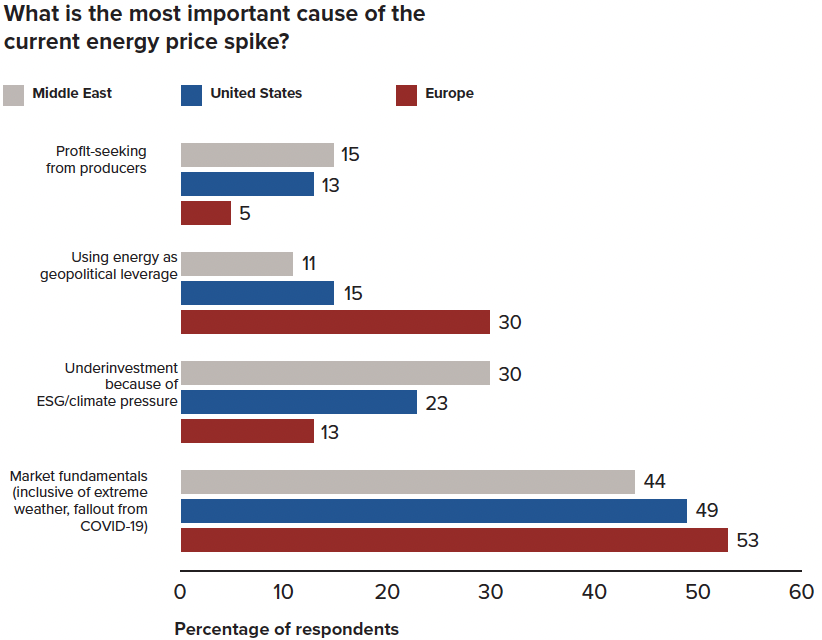
The other notable regional difference is a higher percentage of Middle Eastern respondents pointing to lack of investment in traditional sources of energy. This almost certainly arises from the large proportion of that region’s survey pool in the oil and gas industries (56 percent, compared to an overall figure of 24 percent).
A comparison of the answers to these questions of the renewables and the oil and gas sectors throws the differences visible in the Middle East responses into sharper relief.
Again, while market fundamentals are currently the most common explanation for surging prices, each of these two groups differs profoundly on other factors that might be at play. For oil and gas respondents, underinvestment is already a widespread worry. In the coming decade, it is the most commonly expected driver of price volatility (43 percent), surpassing market fundamentals as a driver (33 percent). This implies that, while the oil and gas sector as a whole thinks that it has enough product to meet global demand comfortably, it expects to be impeded in doing so.
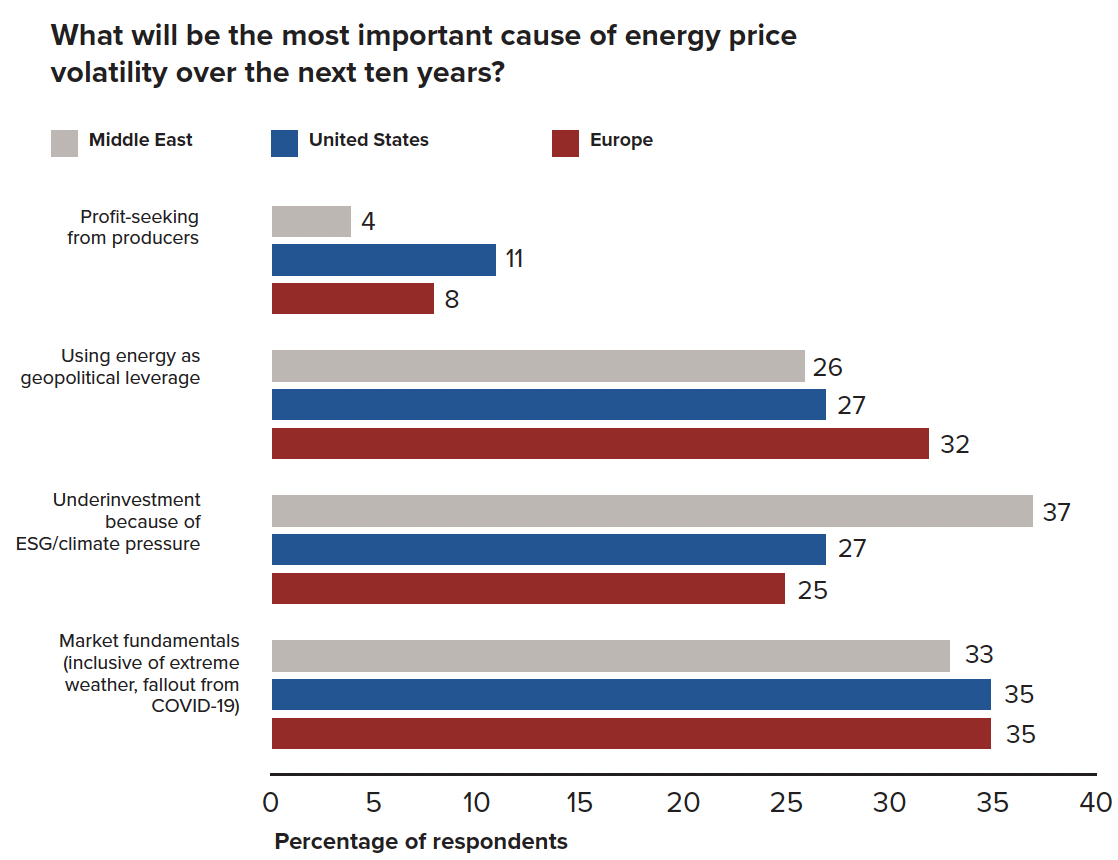
Those working in renewables understandably differ. Lower investment in fossil fuels is, for many of them, a feature of what the future should look like, not a bug. Accordingly, a majority (55 percent) already believe that price fluctuations reflect profit-seeking and governments playing politics. Most also expect that one of these drivers will be behind future volatility, with only a very small proportion seeing underinvestment as the leading issue.
A similar—and equally pronounced disagreement — exists between respondents who think that oil’s day is passing and those who believe it has decades to run.
Among the transition bulls group, 47 percent already believe that profit-seeking or a search for geopolitical leverage are behind the current price spike, and 62 percent say that one of these will be the predominant cause of volatility in future. For those who see fossil fuels as having a much longer-term future—the economic/technological pessimists—underinvestment is already driving up costs. Over half of these also believe that it will be behind future price instability. What these groups have in common is that they think market distortions, rather than fundamentals, will be at play. Bulls fear market manipulation that could take focus away from climate action; for those who believe that the world will need more oil, the problem will be poorly thought-out restrictions.
While there is a robust debate on the cause of the current price spike, looking to the future, the growing movement to divest from fossil fuels could cause price volatility if clean energy technologies are not able to meet demand, as suggested by the answers to the longer-term survey question. The specter of the Yellow Vests of 2018 casts a large shadow over energy transition policies that cut energy supply without changing the type of energy demanded.
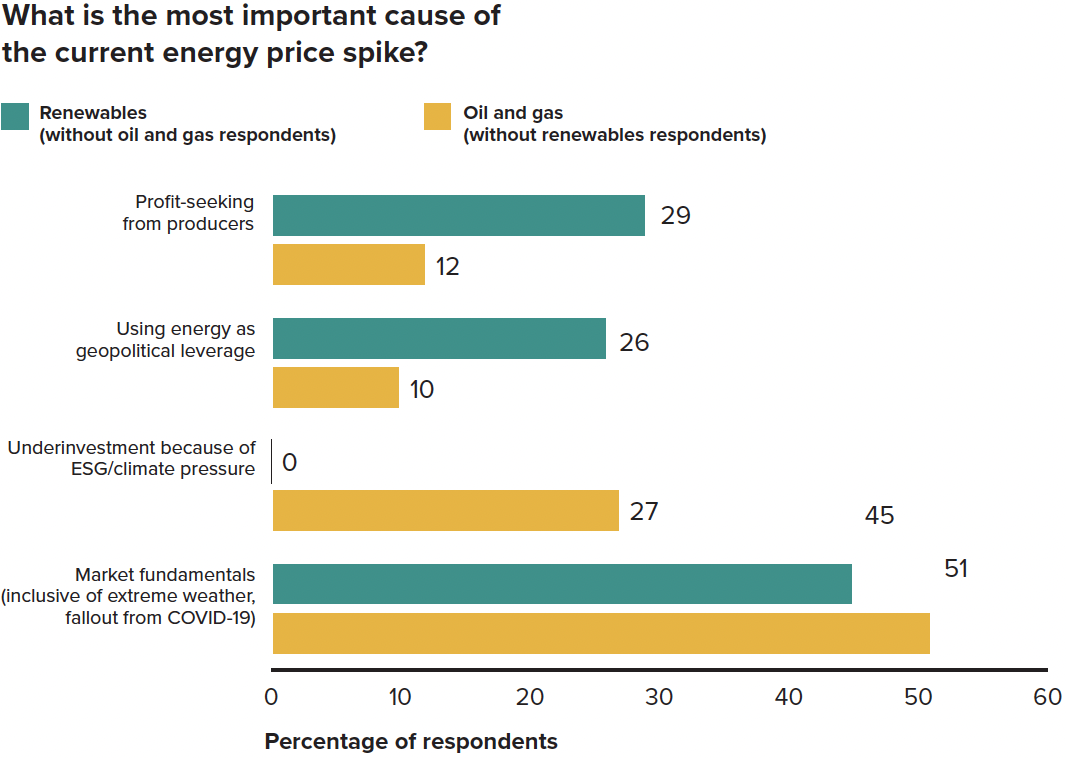
This sobering year for the energy transition is the likely cause of a marked change between this year’s survey results and those from 2020 in expectations about the timing of peak oil demand. As the chart shows, there has been some convergence around the two answers in the center (2026-2030 and 2031- 2040). More striking, though, is the decline in those who see an early drop in long-term demand and the more than doubling in those who see it growing until after 2040 at the earliest (22 percent).
The overall averages of these responses indicate the clear shift in expectation that peak oil demand will now occur several years later than earlier estimates said. Last year, the mean forecast was that demand would reach a maximum in 10.5 years. This time the figure is 12.8, even though a year has passed since the earlier projection. The median answer suggests an earlier date for peak oil in both cases, but a similar shift in sentiment: from early 2027 for maximum demand according to last year’s respondents to early 2030 this time around.
This shift in average forecast numbers is not the result of changes in the demographic base of respondents. Key sub-groups also now believe peak oil demand will occur later. In 2020, for example, those working in renewables believed that demand would begin to decline in 7.2 years. Now they put it out 12.2 years. Those in oil and gas saw less change, but still an increase from the already high estimate of 14.5 years last year to 14.8 today.
Similarly, the age-related gap in perceptions also shrank with most of the change occurring among those expecting peak oil to occur soonest. Respondents under 35, who last year projected that watershed in 6.0 years, now see it coming in 8.7; for those aged 36 to 54, the equivalent figures are 8.4 to 12.7; and for those over 55, they are 12.9 and 13.7.
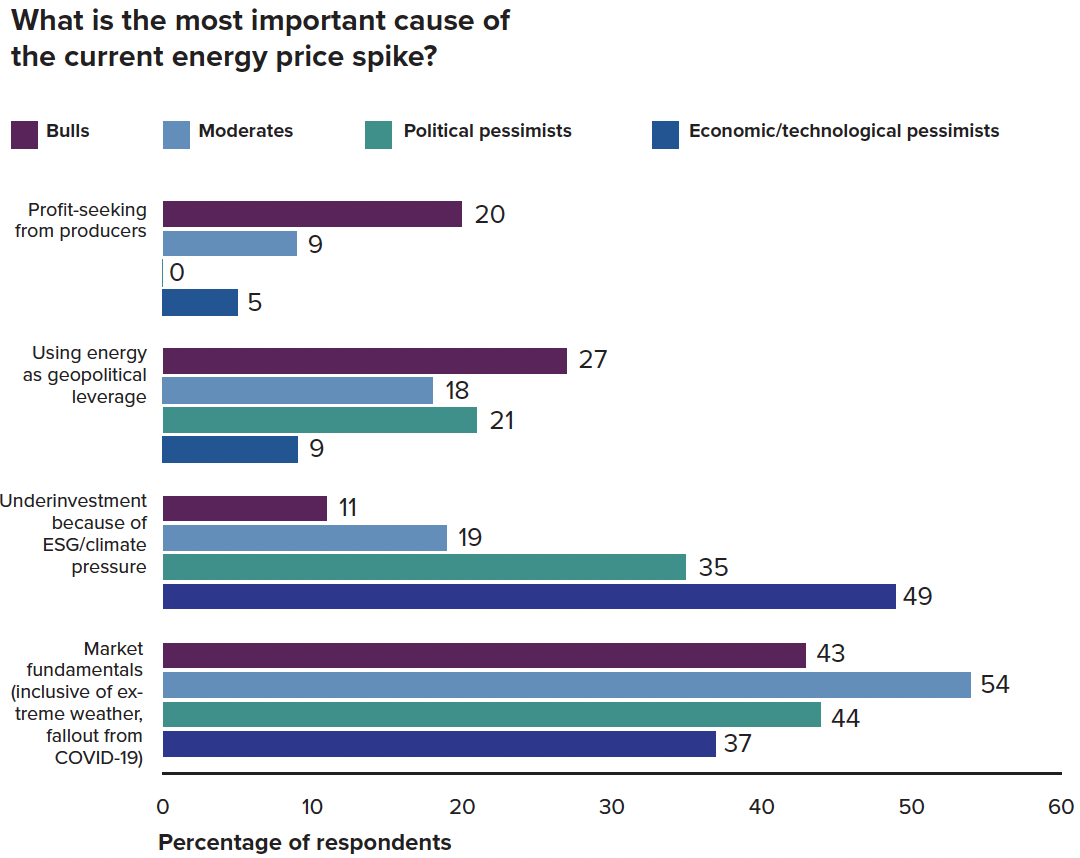
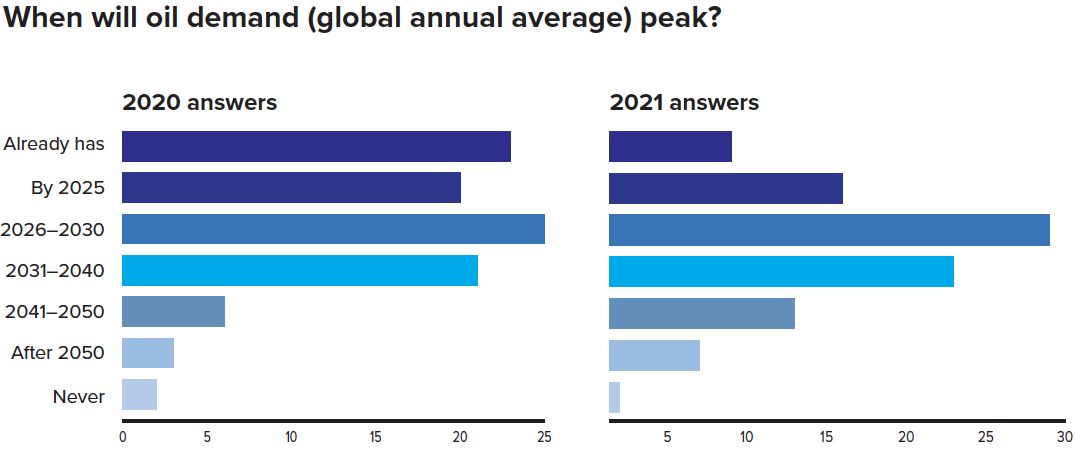
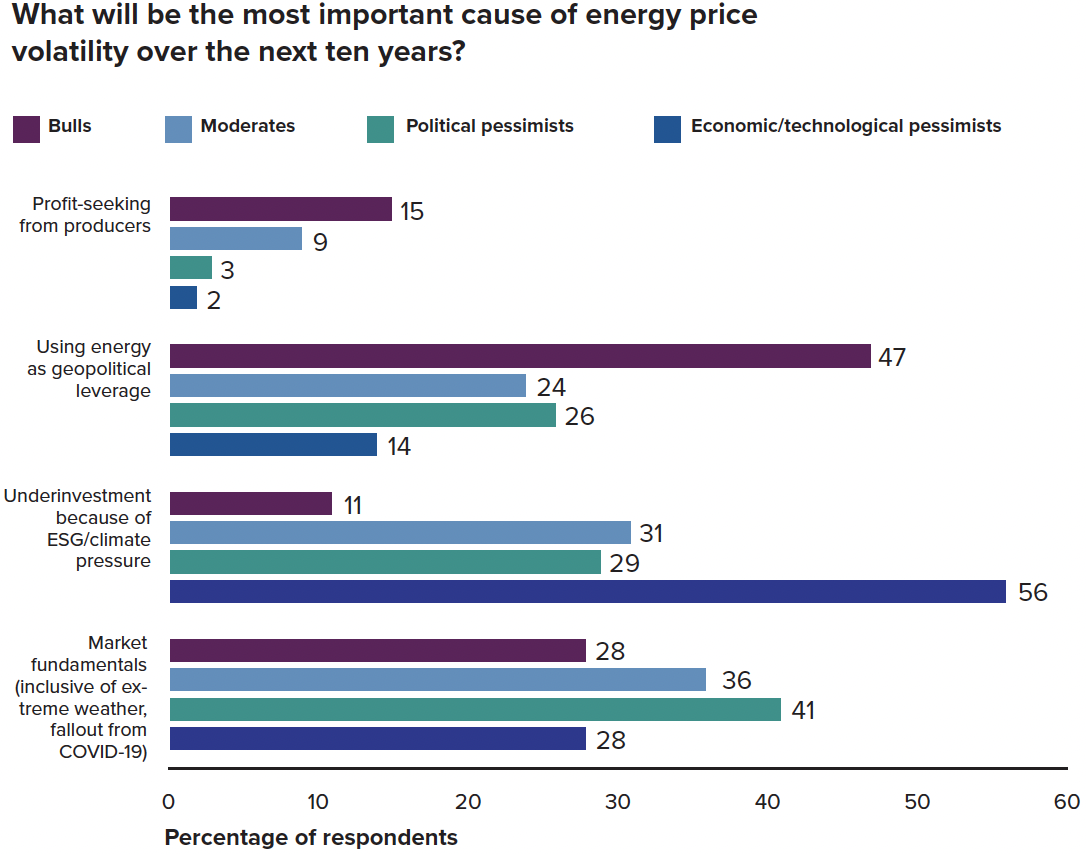
The most striking divergence in opinion, however, is between respondents from different regions, which last year had similar results. This time, those surveyed from Europe, on average, forecast peak oil to occur in 9.7 years; in the United States, 13.2; and in the Middle East, 16.9. This is one of several questions on which Europeans appear more pessimistic about fossil fuels and positive about green developments. The high-profile pursuit of early carbon cuts by policy makers across the European Union and in the United Kingdom may be shaping how respondents from the region see the future playing out.
In his essay, Mohammad Sanusi Barkindo, the Secretary General of OPEC, does not see this overall shift in sentiment as a sign that climate action is failing. Instead, he argues that it is more realistic to include oil within net-zero plans.
Mele Kyari, Group Managing Director of the Nigerian National Petroleum Company (and the country’s national representative to OPEC) brings the perspective of an oil producing, developing country that relies on oil revenue and also wants to play a productive role in meeting sustainability goals.
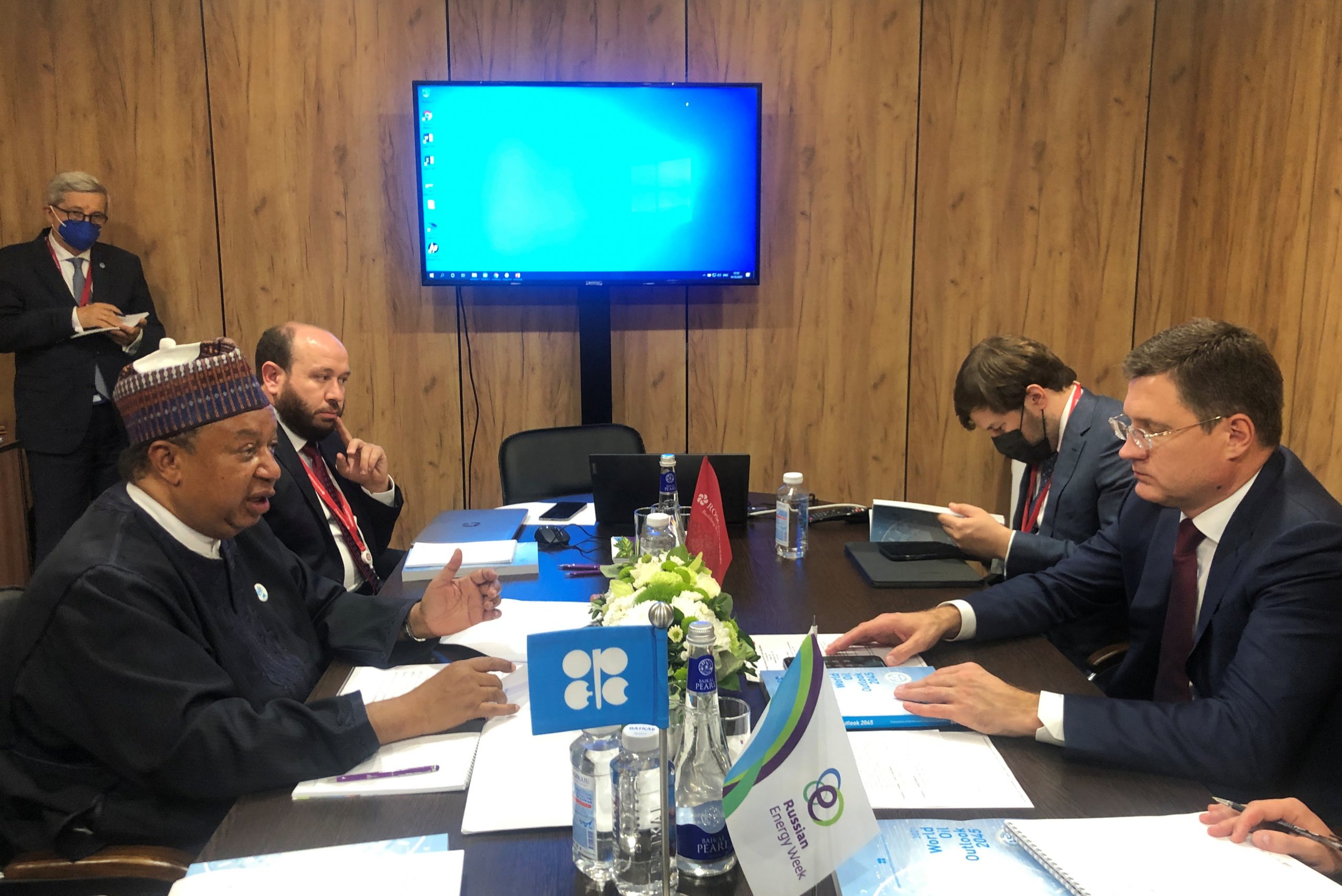
Oil will continue to play a role in a low-carbon world
By H.E. Mohammad Sanusi Barkindo
Looking back at the COP26 meeting in Glasgow, Scotland, while negotiations were tense at times, there were also positive outcomes: for example, the US is back at the head of the multilateral table, all Parties reiterated their commitment to the implementation and full operationalization of the Paris Agreement, and the Glasgow Climate Pact was announced.
This was all encouraging, given the pressing need to reduce global emissions, alleviate energy poverty, counter the impacts of the COVID-19 pandemic, and find a sustainable way forward that leaves no country, industry, or peoples behind.
However, the event also underlined that the discourse around energy, climate, and sustainable development continues to be extremely emotive with some voices all but excluded, including many from the oil industry. At times, it can feel like rational discussions based on facts, hard data, and science have taken a back seat.
The parameters of the public discourse around the energy transition seem reduced to the question: are you for or against fossil fuels? It is perhaps the ultimate false dichotomy.
It erroneously constrains what options are available. It should not be a question about one or the other. The complexity of the challenge calls for an inclusive approach, not the pursuit of a single ‘one size fits all’ panacea.
We appreciate and fully understand the move of many developed nations to set net-zero emissions targets. In fact, some developing nations have too. Some OPEC Member Countries—Nigeria, Saudi Arabia and the United Arab Emirates—have made political pledges on net zero.
However, it is important to appreciate the massive challenges for developing countries to reach net zero emissions, many of which are acutely focused on priorities such as energy access, living wages, and supplying basic necessities.
The challenges before us are enormous and complex. We have been delivered a stark reminder of this with the recent strains and conflicts related to energy affordability, energy security, and the need to reduce emissions playing out in regions across the world at the end of 2021.
Focusing on only one of these issues, while ignoring the others, can lead to unintended consequences, such as market distortions, heightened price volatility, and energy shortfalls.
It requires a delicate balancing act, comprehensive and sustainable solutions, and all voices at the table. It is an energy sustainability trilemma, with each piece of the jigsaw having to fit together.
We need to ensure energy is affordable for all; we need to transition to a more inclusive, fair, and equitable world in which every person has access to energy as referenced in UN Sustainable Development Goal 7; and we need to reduce emissions. Oil has a role to play in each part.
It will be required to meet the expected huge increase in energy demand. In OPEC’s World Oil Outlook (WOO) 2021, global energy demand is set to expand by 28 percent by 2045. This will require the use of all forms of energy to support the post-pandemic recovery, drive the energy transition, and address long-term energy needs.
We see oil still making up 28 percent of the world’s energy needs by 2045. This will require huge investments in the global oil upstream, midstream and downstream sectors, with the WOO showing that investments of $11.8 trillion will be required between now and 2045. OPEC Member Countries remain committed to investments to ensure supply meets the demand of their customers.
From the perspective of the developing world, if billions of people who suffer from a lack of energy access feel they are excluded from tapping into energies that have helped fuel the developed world, then this could sow further divisions and expand the divide between the haves and have nots, the Global North and South. Nobody should be left behind in the energy transition.
In terms of tackling climate change and reducing emissions, we fully believe that the oil industry can be part of the solution. The history of the oil industry from its very early beginnings has been one of innovation, of providing solutions to the most intractable of challenges.
We have no doubt that the resources and expertise of the oil industry can be harnessed again to help develop cleaner and more efficient technological solutions, contributing to a reduction of emissions as part of unlocking a low-emissions future. For example, carbon capture utilization and storage, including direct air capture, blue hydrogen, and other technologies, can be leveraged—along with the promotion of the Circular Carbon Economy—to improve overall environmental performance.
OPEC is ready, willing, and able to play a key role. As we have seen through the prism of recent events, any talk of the oil industry being consigned to the past—as well as talk of halting new investments in oil and gas—is misguided.
We need to follow all the right transition paths and appreciate there is not just one path for all. We need to connect all aspects of the energy sustainability trilemma.
Our energy future is not about ‘Them’ or ‘Us.’ It has to be about ‘We.’ This needs to be the focus as we approach the coming years and talks lead us to COP27 in Egypt in November 2022, and then to COP28 in OPEC Member Country UAE, in 2023.
H.E. Mohammad Sanusi Barkindo is the Secretary General of OPEC.
Perspective on energy transition
By Mele Kolo Kyari
Climate change has increasingly become a major concern for everyone. From Abuja to Algiers and Alaska to Antarctica, the impact of climate change on the environment is seen every day. Outdoor temperatures and sea levels are rising, water bodies are drying up, and the frequency of major weather events is increasing.
This worrisome impact of global warming has, over the years, triggered the best of human innovation, especially in the fields of energy and sustainability.
World leaders, leading institutions, scientific communities, businesses, and organizations are leading global solidarity in action against climate change and its impact on life on earth. The call to end the use of fossil fuels in order to reduce global CO2 emissions and achieve carbon neutrality by 2050 is becoming louder, and the coalition is big, but greater synergy is required to achieve sustainable outcomes.
This requires the global oil industry to play more than one important role; to lower the global carbon footprint, sustain global energy security, and drive prosperity especially in developing countries where population growth remains well above global average.
In most known instances, the oil industry has remained one of the major contributors to global economic growth, by guaranteeing energy flow to industrialized regions and revenue and taxes to oil-producing countries like Nigeria.
These dual roles cannot be simply ignored in our quest to address the impact of carbon emissions on the environment. Policies and views on the energy transition should therefore reflect global energy and economic realities surrounding both oil-producing and consuming nations.
As a national oil company, we believe inclusive policy actions that guarantee access to finance and low-carbon technology are key to sustaining global energy security and equitable growth as the world transits to a carbon-neutral economy.
Our strategy for achieving carbon neutrality is centered around three principles: adoption of low-carbon technology across our operations, deepening natural gas utilization to reduce energy poverty, and investment in clean energy technology and products.
We believe these principles are most likely to support a smoother transition to a carbon-neutral economy without compromising access to the cheap and readily available energy resources that will be required to address energy poverty and support country-specific development priorities.
Slowing down investment in hydrocarbon ventures may provide the right incentive for the energy transition, but it cannot guarantee global energy security in the near future, especially as energy demands grow faster than renewable energy maturation.
The world therefore needs to adopt a more inclusive consensus, one that considers complementarities and trade-offs between and within policies and policy objectives.
As a commercially driven entity, we are leveraging the current industry dynamics to diversify and grow our portfolio in order to maintain relevance in the global energy market. Additionally, we are reassessing the brown and green assets for our Carbon Budget and environmental credentials as part of our transition to an energy company of global excellence.
Mele Kolo Kyari is the Group Managing Director and CEO of the Nigerian National Petroleum Corporation.
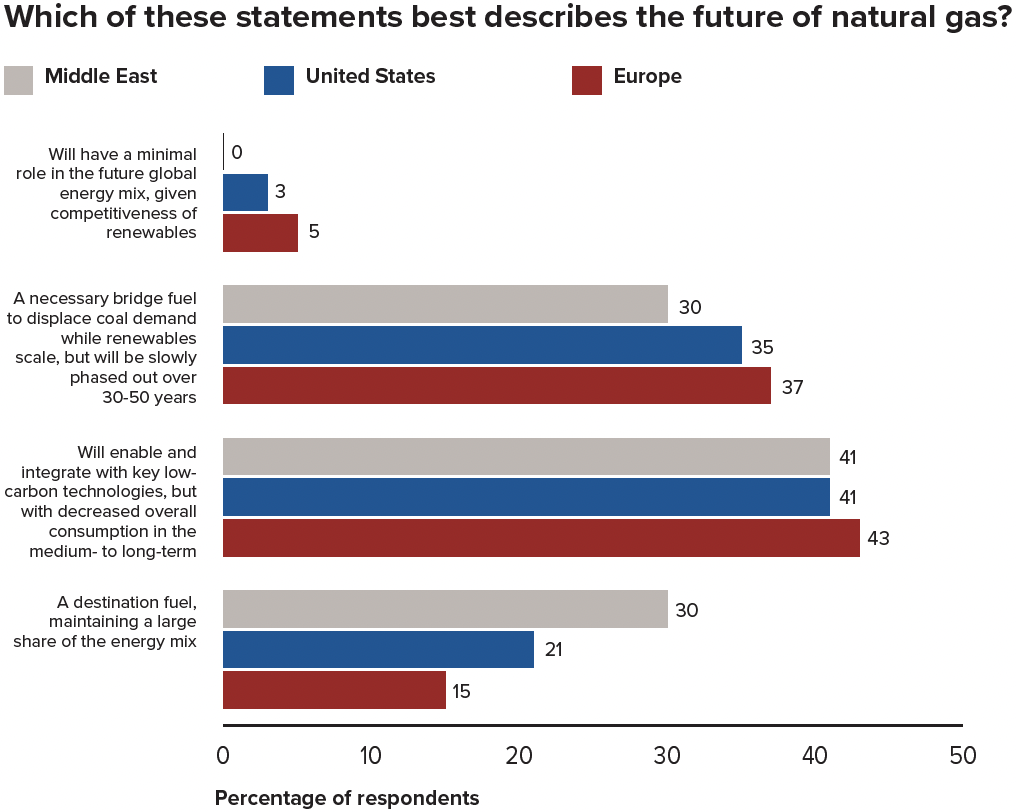
How our respondents think about the future of natural gas is more complicated than their predictions about oil. Like last year, we asked our respondents about the future of natural gas during the energy transition. These responses, in aggregate, have changed little in a year, with percentages that each differ by no more than three points from those in last year’s survey. Very few respondents (3 percent) think that gas will take on a minimal role. At the other extreme, one in five respondents believe that it will be a destination fuel. The rest are almost evenly split between those who think that gas will be a bridge to the future but then be unnecessary (38 percent) and those who believe it will be a long-term enabler of low-carbon technologies.
Looking more closely, however, reveals a wider variance between groups even though the average figures remain stable. Last year, results differed little by geography. This time around, Europe again stands out. In particular, respondents there are less likely to see natural gas as a destination fuel than are those from other regions—especially the Middle East—and more often expect it to be, at most, a bridge.
Meanwhile, a surprise in our previous survey was the similarity in answers to the natural gas question between the transition bulls and moderates. More predictably, over half of 2020 transition bears called gas a destination fuel. Now the differences between these groups are much starker.
Underlying attitudes about the energy transition in general are consistent predictors of specific views on the future of natural gas. For the bulls, with peak oil demand more or less upon us, gas becomes the next target for carbon reduction. For the transition bears, all fossil fuels seem to have longer futures. Moreover, given the lack of confidence in renewable technologies among the economic/technological bears, it makes sense that gas—a relatively low-carbon energy source—will be necessary as a destination fuel.
On the surface, then, attitudes toward the future of gas seem stable across the energy sector, but differences between groups within it are widening.
Majid Jafar, the CEO of Crescent Petroleum, sees the need for an “evolution over revolution” to address the risks of a price volatility while transitioning to a lower-carbon economy and argues for the important role natural gas can play in that revolution.
Tim Holt, Member of the Executive Board and Labor Director at Siemens Energy, comes to a similar conclusion about natural gas and, in the context of a global decarbonization effort, notes that gas can play a role in immediately reducing emissions while also creating a pathway to a hydrogen economy.
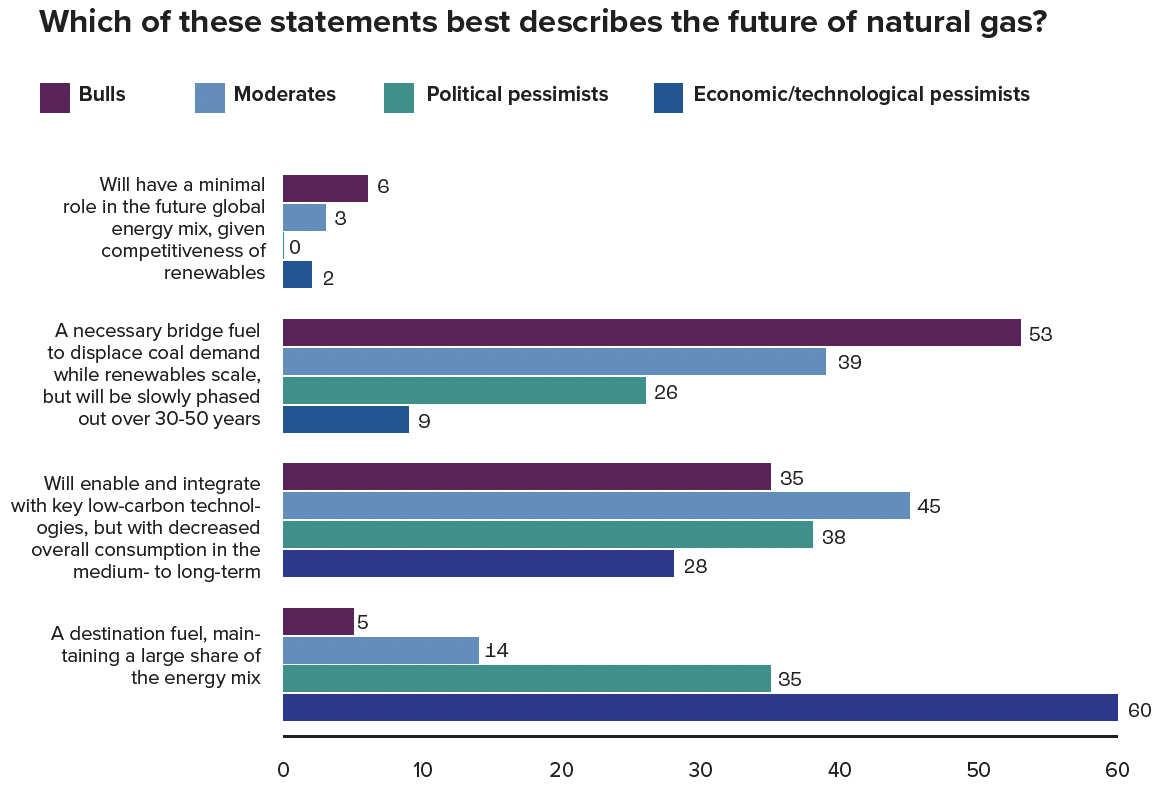
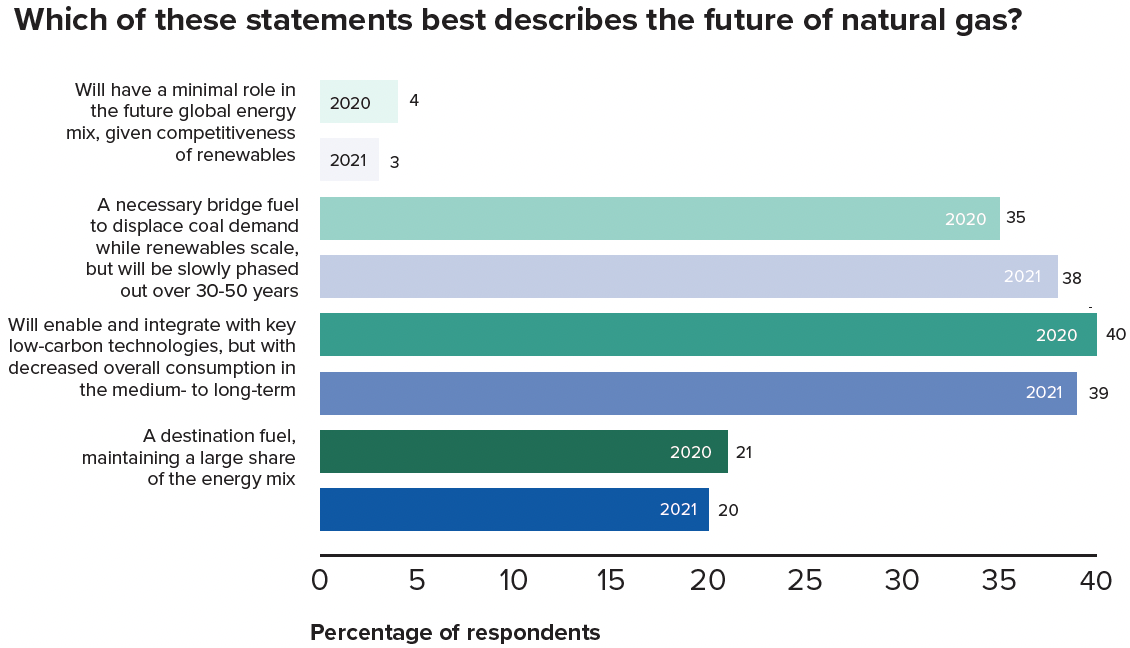
Partner perspective
This year proved that the world needs a smarter carbon transition strategy
By Majid Jafar
Activists and policymakers are enamoured with complex and expensive solutions to reduce CO2 emissions. But the results of the COP26 Summit—and the energy crises that coincided with it—highlight the need for a transition strategy that emphasises evolution over revolution.
When delegates descended on Glasgow for the COP26 summit this past November, their arrival coincided with one of the worst energy crises in recent decades. As many called for a total end to coal-fired power, the UK itself began firing up old coal-fired power plants for the first time in years amid a region-wide natural gas and renewable energy crunch.
Power companies were caught on the back foot, infrastructure creaked, and natural gas came to the rescue to plug many of the holes, at a decidedly steeper price. Gas, oil, and coal prices have risen dramatically, and many people braced for brownouts and power cuts in Europe even as factories in China literally went dark.
What can policymakers learn from this man-made crisis? The most important lesson is that the path to the carbon transition is just as important as the destination itself. Move too quickly to cut off traditional sources of power, and the supply shortfalls will have immediate and negative impacts.
This decade’s first major energy supply crisis highlighted the hidden problems in current carbon-transition policy and put to test many of the assumptions of green energy. Well-intentioned policymakers, encouraged by activists, have sought to strangle investment in hydrocarbons and embrace renewables wholeheartedly. That embrace is politically convenient when the wind is blowing and the sun is shining, but when winds died down and droughts hampered hydropower, the effects proved how ill-suited some of the current strategies are.
In this case, the energy crises were the result of three simultaneous but predictable problems. Most significant is the collapse in investment in oil and gas over the past decade further dampened by low energy prices last year as well as growing investor reluctance to invest in long-term projects, leaving shortfalls in oil and gas supplies just as demand spiked due to the global economic recovery.
As activists continue to push banks and institutions to halt oil and gas investment altogether, investors are growing wary of holding potentially stranded assets in a future low-carbon world. The limitations on capital investment can be felt today, years before renewables can catch up.
Oil and gas producers continue to find themselves unfairly framed as malevolent actors in the climate change discussion, when in fact they will inevitably be an important part of the transition. Even in the most aggressive scenario for carbon emissions cuts, hydrocarbons will continue to supply a majority of energy for decades to come. JP Morgan estimates that a $600 billion shortfall in upstream oil and gas investment will hamper future supply, leading to sustained pricing volatility and supply disruptions.
Secondly, investment in renewables has not made up for the lost energy supply, making matters worse. Renewables grew 3 percent in 2020, accounting for nearly 29 percent of power demand. But two-thirds of that total actually came from hydropower. As droughts impacted hydropower in 2021, the impact of the water shortfall was magnified, presenting a harbinger of future supply volatility.
The third major challenge has been the shutdown of nuclear power plants in Europe and the commensurate reliance on coal in some countries, which has proven self-defeating just as energy demand has risen during the post-COVID recovery. When nuclear has been phased out in Germany, elsewhere in Europe, the US, and Japan, important sources of baseload power that made for a more reliable grid have been lost.
The answer to the crisis is smarter transition policy, in which tailored solutions are applied in each region. There is a proven formula for cutting GHG emissions quickly that is easily applied today: reduce energy consumption by boosting efficiency, encourage reforestation, and switch from high-carbon-emitting fuels to lower-emitting ones. These steps would bring rapid reductions in emissions and complement renewables in the transition to a more sustainable energy future.
The remarkable success of the auto industry and other sectors in boosting efficiency can easily be leveraged around the world to use energy supplies more wisely. Mass transit and other efficiency measures can further reinforce the gains.
By reforesting land in developing countries the world could create a sink for 750 billion tons of CO2, which is the equivalent of 100 years of current global carbon emissions from transportation. COP26 commitments by Brazil and other rainforest nations to curtail deforestation are welcome developments that must be reinforced with reforestation efforts supported by carbon taxes. Subsidies now spent on renewables, supported by a global carbon tax, could fund the reinvigoration of the world’s forests and bring greater balance.
Switching to gas from coal-fired generation, particularly in India and China, where coal use is growing fastest, would yield considerable savings in CO2 emissions to help meet targets. Subsidies now spent spurring renewables adoption would be better spent on helping accelerate that switch.
Countries that have embraced a combination of these policies, like the United States and the UK, which have each seen gas substituting for coal in a major way—notwithstanding the recent coal forays—have enjoyed rapidly falling carbon emissions and energy costs. At the same time, Germany, which sought to exclude oil and gas from its energy mix while subsidising renewables, has instead increased its use of coal, resulting in higher emissions.
The oil and gas industry also has an important part to play by tackling methane leaks. The comparative investment is small compared to the immediate impact it would have: methane has more than eighty times the global warming impact as CO2 over its first twenty years in the atmosphere. Eliminating methane leaks would advance the world’s efforts to limit emissions considerably and in short order. The commitment at COP26 to tackle methane leaks was important in this regard.
Ultimately these challenges require sound technical and economic solutions rather than politically expedient ones. They require policymakers to acknowledge the intermittency inherent in renewables and to take steps to dampen such volatility as the transition continues. For example, while battery storage is still not able to fill in the supply shortages from renewables, increased gas storage certainly would do so, with limited emissions.
Reasonable people now accept that climate change is a global challenge that needs to be tackled. But those calling for overnight change are neglecting to account for the very real risk that such energy shocks may undermine political support for green policies, as citizens see their standards of living impacted and the shine of renewables and other low-carbon sources of energy is tarnished. That would be a bad outcome for everyone.
Majid Jafar is the CEO of Crescent Petroleum and a member of the Atlantic Council’s International Advisory Board. Crescent Petroleum is a sponsor of the 2022 Atlantic Council Global Energy Forum.
Partner perspective
From commitment to action: Driving the energy transition
By Tim Holt
Our planet is at a crossroads. The impact of man-made climate change is enormous and is already bringing numerous regions to the brink of disaster. Extreme weather events—such as droughts, savage storms, and floods—are threatening to become the norm. The Intergovernmental Panel on Climate Change has already warned that the average global temperature could rise by more than 1.5 degrees Celsius by 2030, with huge geopolitical consequences. The 2015 Paris climate goal, intended to save the world from a catastrophe, would thus be history in less than eight years.
But there is good news, too: we can still change a lot if we act now. As Alok Sharma, President of the 26th UN Climate Change Conference (COP26), put it, it’s time for the world to move from a decade of thinking about climate change to a “decade of delivery.”8 However, it is not just about introducing new technologies or saving energy. It is about fundamentally changing our approach to dealing with energy in an environmentally responsible and climate-friendly way. And it is something that affects everyone, including governments, businesses, and individuals.
One clear priority is the coal phase-out. Together with the decommissioning of related power plants, this must be accelerated swiftly and consistently. This is crucially important since coal-fired power plants account for roughly 70 percent of the global carbon dioxide (CO2) emissions from electricity generation. Worldwide, the number of planned coal-fired power plants has fallen by two-thirds since the UN climate summit in Paris in 2015. Yet numerous countries around the world still rely on coal. Richer countries have no choice but to support poorer ones in making the energy transition. In the end, of course, all the costs of this change are a key investment in our future.
Given the enormous amount of CO2 to be reduced, every ton counts. That is why we should consider using all currently available technologies along the entire energy value chain. One example: a fossil fuel like natural gas can build a bridge to a sustainable energy system. Hydrogen-capable gas turbines can be operated with gas today and with hydrogen once enough is available. While renewable energies are preferable, existing capacities are nowhere nearly sufficient to meet the world’s electricity needs. Switching to natural gas would immediately reduce CO2 emissions by around two-thirds compared to coal-fired generation, while guaranteeing security of supply.
Transmission grids are another—and often-underestimated—aspect of the transition. Their capacity and stability are bedrocks of the energy transition’s success, since renewable energy not only has to be produced, but must also be transported to where it is needed. For offshore wind farms, this requires the installation of underwater cables and an electrical substation at sea, sometimes hundreds of kilometers offshore. Once on land, the journey often continues over long distances, making it especially important to ensure low losses. Currently, more than eight percent of all electricity produced is lost in transmission and distribution. Here lies massive potential for improving efficiency, such as by expanding high-voltage direct-current (HVDC) connections.
Grids also need to cope with the fluctuations resulting from the growing share of renewable energy. Digital solutions can significantly support the detection and management of these intermittencies. And another important point: grids have to contribute to decarbonization. Harmful sulfur hexafluoride (SF6) is still widely used as a cooling and insulating medium for gas-insulated switchgear. Since this greenhouse gas is around 23,500 times more warming than CO2, it must be eliminated by replacing it, for instance, with “clean air.” In short: the grid of the future has to be resilient, digitalized, and decarbonized.
At the same time, we have to systematically expand renewable energies and innovate along the supply, distribution, and demand sides of a sustainable energy system. With power-to-X, for example, power can be decoupled from the electricity sector and made available to other sectors such as transport and chemicals.9 Also, the energy consumption of heat generation and industrial processes can be decarbonized through the integration of renewables. Here, it is of utmost importance to support the expansion of renewables and bring future technologies to market maturity quickly. Politicians are also called upon here to act: approval procedures for new power lines have dragged on for more than ten years in some countries.
While we all sometimes get caught up in the thicket of good intentions, what we need now is the courage and motivation to act. Public stimulus programs, along with the establishment of binding quotas and CO2 prices, are important for promoting sustainable technologies. However, they cannot replace private investment over the long run. The energy transition will cost money, and it will not happen overnight. But this should not prevent us from doing everything possible today. Every politician, every company, and every individual consumer has responsibility here, and the chance to change something for the better.
8 Rt Hon Alok Sharma MP, “International action and collaboration for a decade of delivery on climate change,” Government of the United Kingdom, March 31, 2021, https://www.gov.uk/government/speeches/international-action-and-collaboration-for-a-decade-of-delivery-on-climate-change
9 Power-to-X is an umbrella term for a number of electricity conversion, energy storage, and reconversion pathways that use surplus electric power from renewable energy, typically solar and wind. “X” refers to the type of energy into which the electricity surplus is being converted. These are usually gases, liquids, or heat.
Tim Holt is a member of the Executive Board of Siemens Energy AG and Labor Director of Siemens Energy Management GmbH.
Chapter 3: Geopolitical and economic risk

Geopolitical and economic risk
Essays
The Ukraine crisis could have global energy implications
By Daniel Fried & Richard L. Morningstar
Cyberattacks on our energy infrastructure: The need for a national response to a national security threat
By Sec. Jeh Charles Johnson
The future geopolitics of hydrogen
By The International Renewable Agency
Partner perspective
The energy transition is necessary but not easy
By Helima Croft
Survey results
As discussed in the previous chapter, our respondents see geopolitical risk becoming a much more significant driver of energy price volatility over the next decade. Indeed, at the time of publication, Russia seemed poised to invade Ukraine; North Korea had conducted three missile tests over the previous three weeks; Iran was increasing its uranium enrichment capacity; and US-China tensions over Taiwan were at their highest in recent memory. From a geopolitical perspective, the world looks far more dangerous at the beginning of 2022 than it did at the beginning of 2021.
Like last year, we asked our respondents what the biggest risk in energy geopolitics would be in 2022. Last year, COVID-19’s potential impact on supply and production was, by a large margin, respondents’ most common choice as the biggest danger in energy geopolitics for 2021. With viable vaccines against COVID- 19 being announced only during the collection of last year’s survey responses, the pandemic’s effect on energy supply and production was understandably the most frequently named geopolitical concern of the upcoming year. It was the choice of 39 percent of respondents, more than double the figure for any other risk. Similarly, a sense seemed to exist that such a big event had to be a harbinger of wider change: 61 percent said that the pandemic would accelerate the energy the transition; just 20 percent believed it would impede this development.
A year later, the figures are quite different. Only 11 percent now see COVID-19 as the leading geopolitical risk of the coming year, putting it in fourth place overall. This number differs little across regions and sectors.
Meanwhile, greater uncertainty has arisen in the kind of change the pandemic might bring, if any. Respondents are almost evenly split between those who see it leading to an acceleration of the energy transition and those expecting COVID-19 to slow this transformation. Just as striking, the most common choices are either muted change in speed one way or the other, or none at all (30 percent for each). The only differences by sector or geography tend to involve fewer people expecting no change at all: the numbers predicting acceleration, either rapid or slow, and those foreseeing some level of deceleration are typically close.
Even our groups with different visions of energy’s future appear to have grown more equivocal in their views. Last year, we noted that the response to this same question was, for them, a kind of Rorschach test. Among our transition bulls, 74 percent thought that the pandemic would accelerate the energy transition and just 13 percent said it would slow things down. This year, the equivalent figures are 44 percent and 32 percent. The change among our transition bears has been less discernable. Last year, 33 percent of this group said that COVID-19 and its societal effects would speed up the transition, and 15 percent said the pandemic would impede it. This year, the former figure has declined to 19 percent and the latter has dropped to 42 percent; those seeing no likely change of pace has climbed from 22 percent to 39 percent.
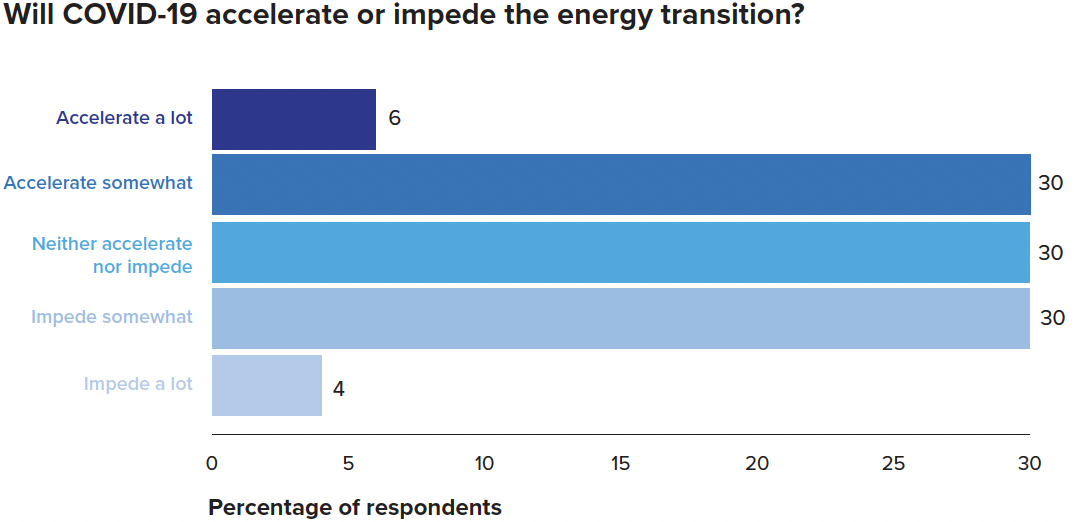
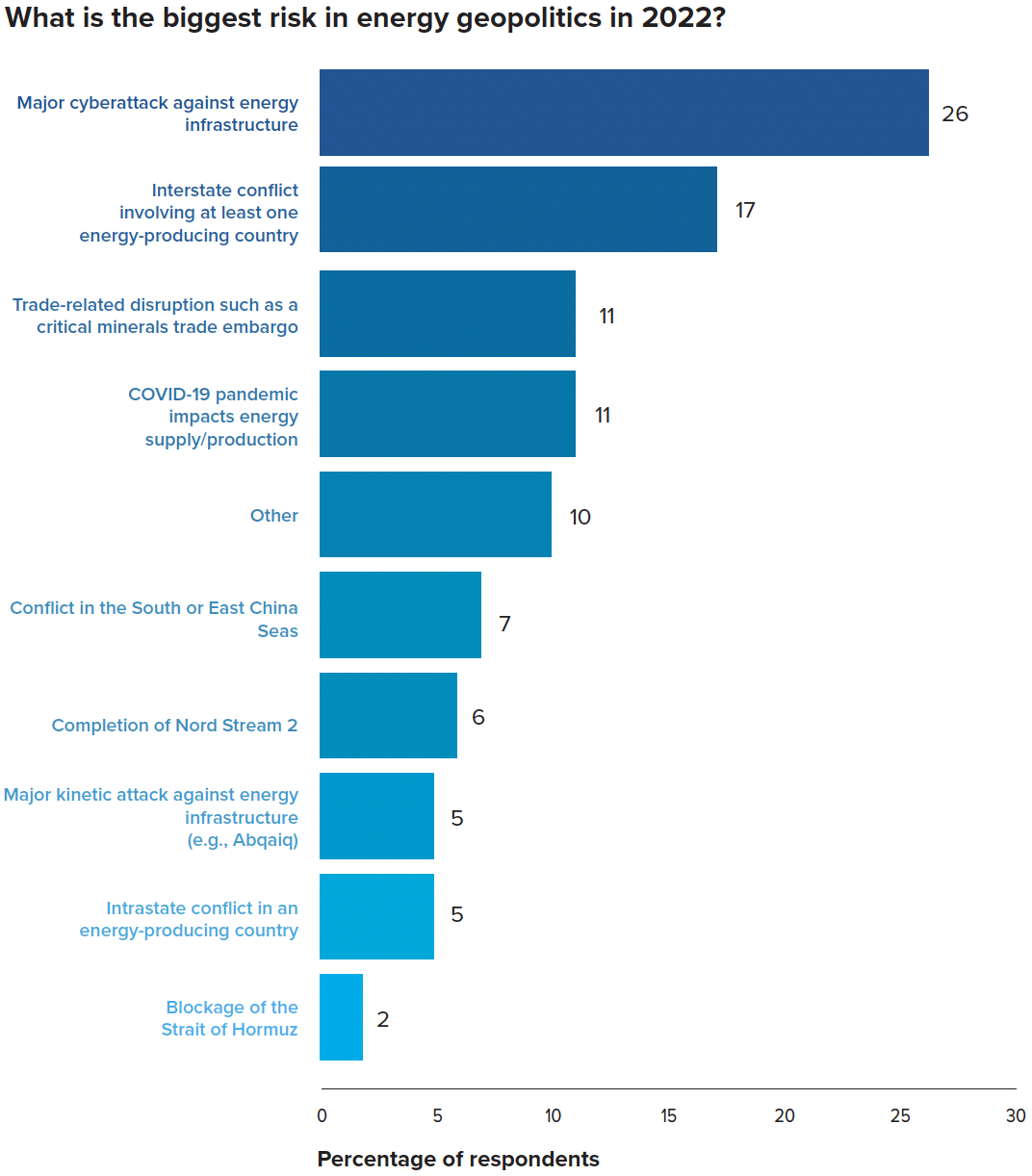
This year, the threat of a cyberattack has become the single largest geopolitical concern, followed by interstate conflict, trade disputes, and—again—COVID-19. Most of our survey sub-populations of interest paint a similar picture with their particular risk concerns. The specific numbers vary, but in oil and gas, renewables, Europe, the United States, and among our transition bulls, moderates, and transition bears, a major cyberattack is the most commonly noted threat, usually by a significant margin. Interstate war is typically second, although among both kinds of transition bears, the aggregate number of “other” risks instead comes next. When asked to explain further, these respondents often worried either about Russian unpredictability or US policy weakness.
An alternate way of grouping these answers, however, gives a different insight. Several describe the risk of being caught in the crossfire during conflict, which is not necessarily directly related to energy. This risk includes interstate violence, fighting in the South or East China Seas, and intrastate conflict. Similarly, two answers—cyberattack and major kinetic attack— involve attacks specifically against infrastructure and potentially separate from broader conflicts.
When these groups are treated as single categories of answers, across the survey as a whole, both are chosen by 31 percent of respondents. In other words, equal numbers focus on the risks of collateral damage from where their respective sector operates as are more concerned about attacks on the industry itself. As the specific conflicts that might hurt the sector are numerous, and as cyberattack is the obvious vector to use against the industry, this equality is harder to see in the overall answers.
Looking through this risk category-based prism, the regional differences become clear. Across the Middle East, violent conflict has broken out repeatedly in recent decades. It is no surprise that, while 30 percent of respondents from that region listed one of the types of attack against infrastructure as the leading geopolitical risk next year, 48 percent pointed to the danger of broader conflicts. In fact, the Middle East was the only region where cyberattack came second (22 percent), behind interstate conflict (30 percent).
In Europe, collateral risk from conflict (32 percent) was also ahead of direct attack (28 percent), albeit with a much smaller difference. There, completion of Nord Stream 2 (cited by 15 percent) was the issue where geographic proximity focused many answers, although it was mentioned by only 4 percent outside the region. In the United States, a country with interests in areas affected by violent conflict but with the physical buffer of oceans between itself and most hotspots, respondents were slightly more likely to see direct attacks on energy infrastructure (33 percent) as the biggest danger rather than general conflict (30 percent).
However, at least regarding Russia and Ukraine, these two categories may be a distinction without a difference. Recent reporting suggests Russia, if it were to invade Ukraine, would also use its cyber capabilities on infrastructure in the country, and has the potential to do so in many parts of the world.
Two of our essays address this concern head on. A piece by Ambassador Richard L. Morningstar and Ambassador Daniel Fried analyzes the geopolitical threat posed by Russia and Ukraine’s need for energy security. And Former US Secretary of Homeland Security Jeh Johnson discusses the importance of cybersecurity for energy infrastructure, and why it is particularly important for the energy transition.
The Ukraine crisis could have global energy implications
By Daniel Fried & Richard L. Morningstar
Diplomacy has failed to resolve the precarious situation in Ukraine. Despite a series of talks between Russia and NATO counterparts from January 10-13 in Geneva, Brussels, and Vienna, the threat of Russian aggression at the time of publication remains dangerously high; Moscow maintains 100,000 troops at Ukraine’s border and continues to escalate its bellicose rhetoric. As winter progresses, the standoff leaves European and global energy security at a tipping point.
In Washington, legislators remain divided on the appropriate measures to deter Russia. Nord Stream 2, an undersea pipeline that would allow Russian gas to bypass Ukraine en route to Germany, remains top of the agenda. On January 13, the Senate rejected Republican-backed legislation that would require immediate US sanctions on the pipeline, on the basis that unilateral action could undermine transatlantic unity.
Indeed, notwithstanding the perniciousness of the pipeline, the need to maintain cohesion among the United States and its European allies in the face of Russian aggression is of paramount importance. In any case, it is clear from statements on both sides of the Atlantic that it is highly unlikely that Nord Stream 2 could move forward if Russia were to invade Ukraine or take other provocative actions; German Vice-Chancellor Robert Habeck warned that “severe consequences”—including the government blocking the pipeline from becoming operational—could ensue should Russia escalate its assault.
If Russia were to intensify its attacks against Ukraine, even in the unlikely event Europe nevertheless allowed the pipeline to proceed, the Biden administration has indicated that it would not continue its waivers of sanctions against Nord Stream 2. While the Biden Administration has argued that threats to block the pipeline offers the West leverage against Russia, Moscow’s reaction to sanctions could put Europe on the horns of a dilemma.
Regardless of the need to deter Moscow, the fact remains that Europe is dependent on Russian gas. A new outright Russian attack on Ukraine would disrupt supply to Europe, which receives 40 percent of its Russian gas through Ukrainian pipelines. Even barring an attack, Russia may seek to cow the West into submission by further cutting gas transit through Ukraine and refusing to resume supplies until Nord Stream 2 is given final regulatory approval.
There are few arguments as risible as claiming the Kremlin does not use energy as a weapon. Russia has already reduced supply through Ukraine by a quarter over 2021, and the Yamal pipeline has flowed in reverse since December 21, as of the time of this publication. On January 11, International Energy Agency Executive Director Fatih Birol made this clear, blaming Russia for exacerbating Europe’s gas crisis by withholding supplies and drawing down its reserves in Europe.
Given the present energy crisis, in part due to contracting Russian supply, even a short term cutoff of gas in the winter months could be disastrous, much more so than when gas was temporarily cut through Ukraine in 2009, resulting in rationing and shortages for industry across Central and Eastern Europe.
Gas is not the only tool in Russia’s energy arsenal. Russia could also cut off or limit oil exports, causing significant turmoil for markets in Europe, the United States, and across the world. Inflation in the United States hit a nearly forty-year high of 7 percent in 2021 and shows no signs of abating, as labor and supply chain disruptions persist. Oil prices factor heavily, reaching a seven-year high on January 17 as OPEC+ continues to miss production targets. If tensions were to increase, oil would likely breach the $100 threshold.
The United States imports significantly from Russia, which became the United States’ second largest source of foreign oil after Canada in August 2021, due to refiners replacing Venezuelan heavy crude for similar products from Russia. Were Russia to further destabilize the market through an embargo—or if supply were disrupted through war or Western sanctions—prices would rise substantially and create increased large inflationary pressure as manufacturers and operators scramble to secure alternatives.
It is imperative that the United States and its European allies develop a common strategy to address this contingency and are visible in doing so. Some steps are already in progress. The US government has engaged the international energy industry on providing emergency gas supplies to Europe should Russia invade. Increased LNG shipments from the United States and other locations are part of the answer—and have already begun—but ramping them up will be difficult.
Markets determine where LNG is shipped. Europe has had to compete with Asia for LNG, where demand remains persistently high. Even if significant LNG were to be made available, it would have to be at competitive prices, which could require subsidies from European governments, who have already resorted to rebates and tax cuts to aid consumers with high bills. There are no obvious answers to Europe’s energy supply issues, but they must be immediately addressed if geopolitical necessities are to supersede economic needs.
Economic leverage, though, does not rest entirely with Moscow. Western financial and other sanctions, if strong enough, would inflict even greater pain on Russia than Russia can inflict on the West by
weaponizing oil and gas. Even energy leverage has drawbacks for the Kremlin. Russia could calculate that the short-term harm of sanctions (and other US, NATO, and EU responses) could be worth its greater political objectives, but the country still depends on oil and gas for a fifth of its economy and most of its exports. It needs to sell oil and gas somehow, and halting supply could accelerate Europe’s long-term efforts to diversify away from Russian energy. The threat of heavy sanctions on the Russian economy—in combination with creative diplomacy—can therefore deter Russia from crossing a red line in Ukraine. Otherwise, geopolitical necessities will require the United States and its European allies to take strong action, which makes it imperative to plan now for the potential ramifications of those actions.
To forestall Russian aggression, energy options—especially the threat to kill the Nord Stream 2 pipeline—will need to be employed by the West. At the same time, contingencies must made to ensure the alliance remains resilient in the face of Russian energy gamesmanship. By doing so, the United States and its allies can hopefully utilize energy politics to prevent war, rather than allowing energy to become a weapon of war.
Daniel Fried is the Weiser Family Distinguished Fellow at the Atlantic Council, and he served as the US Ambassador to Poland. Richard L. Morningstar is the Founding Chairman of the Atlantic Council Global Energy Center, and he served as the US Ambassador to the Republic of Azerbaijan, as US Ambassador to the European Union, and as the Secretary of State’s Special Envoy for Eurasian Energy.

Cyberattacks on our energy infrastructure: The need for a national response to a national security threat
By Sec. Jeh Charles Johnson
On May 6 of last year,
Colonial Pipeline was hit with a ransomware attack by the Russian-based group DarkSide. Reportedly, DarkSide attacked Colonial Pipeline’s billing system, not its operational technology. But as a precaution, for the first time in history, Colonial shut down its entire pipeline, which supplies 45 percent of all the gasoline and jet fuel consumed on the East Coast of the United States.
This shutdown had an immediate, direct, and far-reaching impact on the day-to-day lives of the American people. Shortages at gas stations popped up across Alabama, Florida, Georgia, North and South Carolina, and Virginia. On May 11, 71 percent of gas stations in Charlotte, North Carolina ran out of fuel. On May 14, 87 percent of gas stations in Washington, DC went dry. Gas prices shot up. Panic buying and hoarding occurred. Airports and airlines were affected. Colonial Pipeline paid the 5 million dollar ransom. The pipeline was turned back on. But one ransomware attack, directed at one company, had far-reaching consequences to our nation, its people, and its national security.
It was as if one water main break in downtown Houston, Texas caused kitchen faucets to run dry in Arlington, Virginia. Or as if a single pothole in a runway at the Atlanta airport had delayed every commercial flight in the southeastern United States.
This wasn’t the first cyberattack on energy infrastructure, and it won’t be the last.
In 2015, Russian hackers attacked the power grid in Ukraine, leaving 225,000 people in the dark.10
In 2012, Saudi Aramco was hit with a cyberattack, likely by the government of Iran, which forced the then-world’s largest oil company to shut down 35,000 computers and go back to operating with typewriters and fax machines.11
In February 2021, a hacker infiltrated a water treatment plant in Florida and attempted to increase the water supply’s sodium hydroxide to alarmingly dangerous levels.12
In August 2021, a nation-state attempted a cyberattack on the Port of Houston, the largest container port on the Gulf Coast.13
The cyber threat to our energy infrastructure is real and growing. Indeed, it’s not just a threat, it is our current reality.
Cyberspace is the new 21st century war zone. As reported by the New York Times in November 2021, the governments of Iran and Israel are actively engaged in covert cyberwarfare right now.14 Cyberattacks are replacing kinetic attacks. Covert actors are replacing conventional state actors. US Cyber Command now exists alongside the combatant commands of our nation’s military.
A cyberattack on our nation’s energy sector, or any other sector of critical infrastructure, must be viewed as an attack on the nation itself, warranting a national response.
In the energy sector in particular, assets of critical infrastructure are becoming increasingly interconnected and increasingly vulnerable to a cyberattack of widespread consequences. And just as every organ of the human body depends on a healthy heart, all of the other sectors of critical infrastructure depend on the energy sector.
To be sure, there are compelling reasons for the increasing interconnectivity of our energy sector. With climate change comes the need for renewable energy. With renewable energy, wind and solar power, efficient uses of fossil fuels, and smarter uses of electric grids come the need for digitization and interconnectivity. As a result, the US electricity grid is now referred to as “the largest interconnected machine in the world.”15
All this leads to cleaner uses of energy. But it need not mean trade-offs for our cybersecurity.
With the recent passage of the new bipartisan infrastructure law, nearly $2 billion will be devoted to making our infrastructure more resilient against the impact of cyberattacks.16 But there are other things we must do to strengthen the cybersecurity of the energy sector and the other sectors of critical infrastructure in this country.
First, and perhaps the easiest, least expensive and most obtainable solution: continue to raise awareness about the threat of spear-phishing. Spear-phishing occurs when a system user is lured into responding to an email from a bad cyber-actor posing as a benign and familiar caller. And, once the user answers the knock and lets the bad actor into the secure zone, that bad actor can pose as almost anyone for any purpose. To this day, many of the most devastating cyberattacks on our nation began by a simple act of spear-phishing. Simply raising awareness about weak passwords or the value of two-factor authentication can prevent a large number of attacks that originate due to lack of what we refer to as “cyber hygiene.”
Second, achieve and ensure redundancy. Whether it is the ability to count ballots or control a pipeline, redundancy is key. Like the retention of paper ballots after an election, some call for back-up manual control of power grids and pipelines. This may not be doable in all circumstances, but the point is to have redundant systems that exist off the internet in the event the primary system is corrupted. Or at the least, it is important to have a contingency plan for how services are to be delivered if redundancy is not possible.
Third, Congress should not give up on efforts to legislate certain minimum standards for cybersecurity in critical infrastructure. Most of our nation’s critical infrastructure is in the hands of the private sector. Working with the private sector, the government ought to be able to develop basic, practical, and implementable standards. The good news is that many large and sophisticated companies within critical infrastructure are far along in the cybersecurity of their own assets. Others are not, including many new entrants to sectors of critical infrastructure.
Successive administrations, including the current one, have moved to regulate cybersecurity by executive action. This is no substitute for laws passed by Congress. By federal law, we regulate aviation security, road safety, maritime security, and nuclear and chemical facilities. Why not cybersecurity? The need is no less compelling.
Fourth, we must bolster mandatory reporting to the federal government of certain categories of cyber incidents within critical infrastructure. I am disappointed that bipartisan efforts to insert such a requirement in last year’s National Defense Authorization Act failed.17
Fifth, we must recognize that a cyberattack on a pipeline or a power grid could now cause as much physical damage and suffering as a natural disaster. The good news here is that the bipartisan Infrastructure Investment and Jobs Act signed into law by President Biden in November creates a Cyber Response and Recovery Fund to be administered by the Department of Homeland Security for this purpose.18
Sixth, I join the many calls for the education, recruitment, and retention of a cyber workforce to meet the urgency of the current threats in cybersecurity. Exchange programs between the public and private sectors should be encouraged. Given the current threats we face, why not a National Cybersecurity College or University for both civilians and military, funded by the Departments of Defense and Homeland Security, to exist alongside our military academies, the National Defense University and the National War College?
Seventh, and finally, we must make it clear to the world that, in the eyes of the United States, a cyberattack from overseas on our nation’s critical infrastructure may rise to the level of an armed attack on the nation itself, warranting a military response, as the term “military” is now understood in the 21st century.
In reaction to the terrorist attacks on 9/11, our government reshaped itself to go to war against terrorist organizations. We reshaped how we think of war. We recognized that warfare can be conducted against unconventional, non-state actors, and that conflict
against non-state actors may not be limited to the boundaries of a particular nation.
Cyberspace is the new 21st century war zone. Covert state and non-state actors launch cyberattacks from overseas on our critical infrastructure that have the potential to cause death and destruction to the same extent and in the same manner as an air strike or a terrorist attack.
In testimony before the House Armed Services Committee in 2018, I said that a cyberattack which causes large-scale death or physical destruction can be considered an armed attack on the United States, warranting a military response.19 The President has the constitutional authority to take military action to defend the nation, so long as the action does not rise to the level of a war in scope and duration, which only Congress can declare.20 Under international law, the United States is authorized to act in self-defense if the host nation is unwilling or unable to address the threat itself within its boundaries. 21 And under established principles of the international laws of war, a military response to an attack should be proportionate, but it need not be in kind.22
The United States has offensive cyber capabilities that are second to none. They should serve as both a defense and as a deterrent.
I am a recipient of the Ronald Reagan Peace Through Strength Award. Like President Reagan, I believe that peace and security is achieved though strength. In 2018, when I accepted the Reagan Award, I said this: “Peace is not the default; you have to work for it. Peace is the goal toward which the human race must continually strive, but it is not the natural state of affairs across the globe. Peace must be guarded and protected against the belligerent impulses of far too many on this planet. Strength forges peace, and perceived weakness tempts aggression.”
10 Pavel Polityuk et al., “Ukraine’s Power Outage Was a Cyber Attack,” Reuters, January 18, 2017, https://www.reuters.com/article/us-ukraine-cyber-attack-energy/ukraines-power-outage-was-a-cyber-attack-ukrenergo-idUSKBN1521BA.
11 Jose Pagliery, “The Inside Story of the Biggest Hack in History,” CNN Business, August 5, 2015, https://money.cnn.com/2015/08/05/technology/ aramco-hack/
12 Tasha Jhangiani & Madison Lockett, “How the Energy Department Can Improve Cybersecurity in the Energy Industry,” Nextgov, August 4, 2021, https://www.nextgov.com/ideas/2021/08/how-energy-department-can-improve-cybersecurity-energy-industry/184282/; Andy Greenberg, “A Hacker Tried to Poison a Florida City’s Water Supply, Officials Say,” Wired, February 8, 2021, https://www.wired.com/story/oldsmar-florida-water-utility-hack/.
13 Alan Suderman, “Port of Houston Target of Suspected Nation-State Hack,” AP, September 24, 2021, https://apnews.com/article/business-technology-rob-portman-1e9ff8dac8dbb500d15661c816c22084; “Statistics,” Port Houston, https://porthouston.com/about-us/statistics/.
14 Farnaz Fassihi & Ronen Bergman, “Israel and Iran Broaden Cyberwar to Attack Civilian Targets,” The New York Times, November 27, 2021, https:// www.nytimes.com/2021/11/27/world/middleeast/iran-israel-cyber-hack.html.
15 Don C. Smith, “Enhancing Cybersecurity in the Energy Sector: A Critical Priority,” 36 J. Energy & Nat. Res. L. 373, 373 (2018).
16 Infrastructure Investment and Jobs Act of 2021, Pub. L. No. 117-58, §§ 40124, 70602, 70612, 135 Stat. 429 (2021).
17 Joseph Marks, “Congress can’t even pass the easy cyber stuff,” The Washington Post, December 8, 2021, https://www.washingtonpost.com/ politics/2021/12/08/congress-cant-even-pass-easy-cyber-stuff/
18 Infrastructure Investment and Jobs Act of 2021 § 70602
19 “Cyber Operations Today: Preparing for 21st Century Challenges in an Information-Enabled Society: Hearing Before the H. Armed Servs. Comm.,” 115th Cong. 69 & n.5 (2017), statement of Jeh C. Johnson citing Jack Goldsmith, “How Cyber Changes the Laws of War,” 24 Eur. J. Int’l L. 129 (2013); Oona Hathaway, et al., “The Law of Cyber Attack,” 100 Cal. L. Rev. 817 (2012); Charlie Dunlap, “Are Cyber Norms as to What Constitutes an “Act of War” Developing as We Would Want?,” Lawfire, September 15, 2017, https://sites.duke.edu/lawfire/2017/09/15/are-cyber-norms-as-to-what-constitutes-an-act-of-war-developing-as-we-would-want/).
20 “April 2018 Airstrikes Against Syrian Chemical-Weapons Facilities,” 42 Op. O.L.C. May 31, 2018; “Targeted Airstrikes Against the Islamic State of Iraq and the Levant,” 38 Op. O.L.C. 82 (2014); “Authority to Use Military force in Libya,” 35 Op. O.L.C. 20 (2011).
21 U.N. Charter art. 51; US Department of Def., Law of War Manual ¶¶ 5.10, 5.11 (2016); Daniel Bethlehem, “Self-Defense Against an Imminent or Actual Armed Attack by Nonstate Actors,” 106 Am. J. Int’l L. 770, 773–77 (2012) (offering principles “that apply, or ought to apply, to the use of force in self-defense against an imminent or actual armed attack by nonstate actors”); Ashley Deeks, “‘Unwilling or Unable’: Toward a Normative Framework for Extraterritorial Self-Defense,” 52 Va. J. Int’l L. 483, 486 (2012) (“More than a century of state practice suggests it is lawful for State X, which has suffered an armed attack by an insurgent or terrorist group, to use force in State Y against that group if State Y is unwilling or unable to suppress the threat.”)
22 International Strategy for Cyberspace, May 2011, https://obamawhitehouse.archives.gov/sites/default/files/rss_viewer/international_strategy_for_ cyberspace.pdf (“When warranted the United States will respond to hostile acts in cyberspace as we would to any other threat to our country. All states possess an inherent right to self-defense, and we recognize that certain hostile acts conducted through cyberspace could compel actions under the commitments we have with our military treaty partners. We reserve the right to use all necessary means—diplomatic, informational, military, and economic—as appropriate and consistent with applicable international law, in order to defend our Nation, our allies, our partners, and our interests.”)
Sec. Jeh Charles Johnson is a partner at Paul, Weiss, Rifkind, Wharton & Garrison, LLP; he served as US Secretary of Homeland Security from 2013 – 2017; as General Counsel of the US Department of Defense (2009 – 2012); as General Counsel of the Department of the Air Force (1998 – 2001); and as Assistant US Attorney in the Southern District of New York (1989 – 1991).
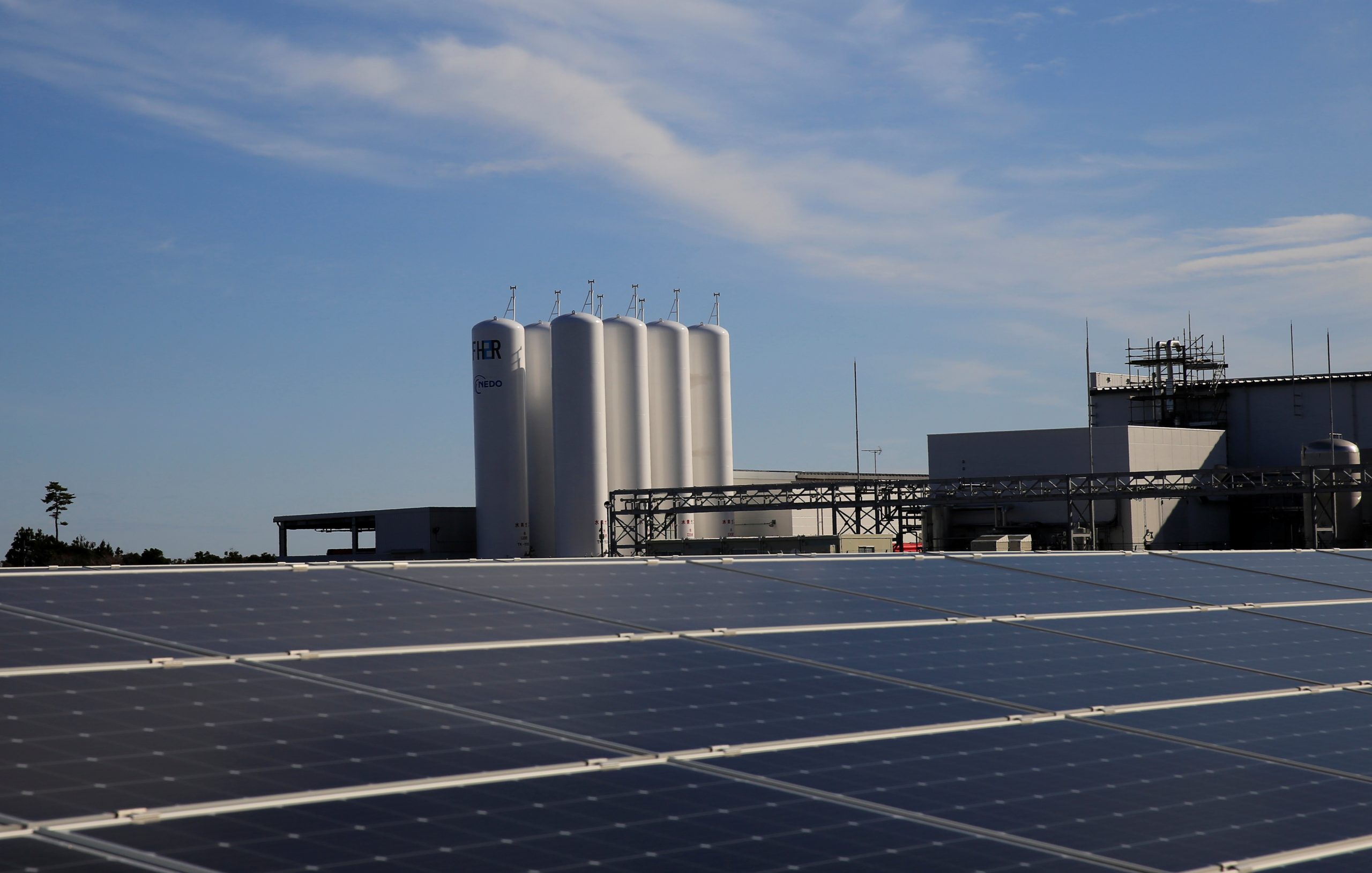
As the energy system transforms over the coming decades, geopolitical relationships currently defined by resource concentration and dependence could shift as new technologies displace current energy sources. Last year, this volume addressed the growing understanding of the role hydrogen will play in a decarbonized energy system. Hydrogen could displace oil in certain transportation use cases and displace gas as a fuel to balance renewables in the power system, among other applications.
The International Renewable Energy Agency (IRENA) has assessed how these changes could impact energy geopolitics in their recent report Geopolitics of the Energy Transformation: The Hydrogen Factor, which is adapted here.23
23 IRENA (2022), Geopolitics of the Energy Transformation: The Hydrogen Factor, International Renewable Energy Agency, Abu Dhabi, https://www.irena.org/publications/2022/Jan/Geopolitics-of-the-Energy-Transformation-Hydrogen
The future geopolitics of hydrogen
By The International Renewable Agency
In recent years, hydrogen has ascended as a potential missing piece of the clean energy puzzle. The climate change imperative firmly in mind, a growing number of countries now have a national hydrogen roadmap or strategy, and a considerable portion of COVID-19 stimulus and recovery funds have been dedicated to the acceleration of hydrogen. At the climate conference in Glasgow, thirty-two countries and the European Union agreed to work together to accelerate the development and deployment of clean hydrogen—constituting up to 12 percent of final energy consumption by 2050 in IRENA’s 1.5°C scenario—and to ensure that “affordable renewable and low-carbon hydrogen is globally available by 2030.”a
With hydrogen taking up such a sizable portion of the future energy mix, the impact of green hydrogen would cause a geopolitical shift, even though blue hydrogen would only replicate the current gas market patterns. The energy transition—unprecedented in its scale and its profound influence on the established macro trends around the world—represents so much more than a fuel replacement; it is a shift to a different system entirely, with commensurate political, technical, environmental, and economic disruptions. Hydrogen uptake will be no exception, for several reasons.
First, hydrogen production, and its status as a uniquely capable low-carbon fuel in harder-to-abate sectors, will play a part in forging new links in the energy trade. With the costs of renewable energy falling but those of transporting hydrogen high, the emerging geopolitical map is likely to show a large degree of regionalization in energy relations. But new bilateral relationships for cross-border hydrogen trade that extend well beyond either party’s immediate region have the potential to restructure political dynamics, as countries that have not traditionally traded energy create economic ties based on hydrogen-related technologies and molecules. (IRENA envisages that two-thirds of green hydrogen production in 2050 will be used locally, and one-third traded across borders.) Nations that expect to be hydrogen importers, like Germany and Japan, are already proactively seeking out such agreements, with other countries not far behind.
Second, green hydrogen could alleviate many countries’ energy security worries. While blue hydrogen will continue to be subject to the vagaries of the fossil fuel market, green hydrogen brings all of renewables’ energy security benefits—namely, reduction of import dependence, diversification of supply option, mitigation of price volatility, and boosting of the energy system’s flexibility and resilience through diversification—with it. And hydrogen trade is much less likely to be weaponized or cartelized, as the fuel can be produced from many primary energy sources and in a wide variety of places worldwide.
Third, countries with an abundance of low-cost renewable power could become the winners in the green hydrogen market, with commensurate geoeconomic and geopolitical consequences. Green hydrogen could be most economical in locations that have the optimal combination of abundant renewable resources, space for solar or wind farms, and access to water, along with the capability to export to large demand centers. Africa, the Americas, the Middle East, and Oceania have the technical potential to exploit their advantages in these categories to become centers of hydrogen production and use as markets mature. And traditional fossil fuel exporters— though more often thought of as a natural fit for blue hydrogen production—are exploring the possibility of leveraging their expertise, existing infrastructure and energy ties, and native renewable capacity to power the growth of their green hydrogen sectors as well, in a bid to diversify their economies.
Fourth, hydrogen will prove a more competitive market than oil and gas but will still provide lucrative opportunities across value chains. Hydrogen is a conversion, not an extraction business, and therefore has the potential to be produced competitively in many places. And as the cost of green hydrogen falls—it is projected to start competing with blue on cost by the end of this decade—new and diverse participants will enter the market, raising competition even higher. Though clean hydrogen will not generate returns comparable to those of oil and gas today, the hydrogen value chain is extensive; according to major investment banks, by 2050, global hydrogen sales could be worth $600 billion,1 and green hydrogen value chains could become a $1.7 trillion investment opportunity in the next thirty years,2 covering everything from dedicated renewable capacity and electrolyzers to transport infrastructure.3 Countries that come out on top of the battle for market share will be attractive locations for energy-intensive industries and, as a result, the race to find champions and establish technology leadership has likely already begun.
The potential impact of hydrogen trade on future energy geopolitics necessitates action now. Mineral security will become a bigger concern as hydrogen markets grow, and it will behoove countries to secure varied and redundant supply options quickly so that they avoid simply trading one set of supply chain issues for another. Fixed infrastructure development is more fraught than ever; the risk of stranded assets must be considered, with renewable hydrogen production likely to take place in different locations than today’s oil and gas extraction infrastructure (though some degree of repurposing is possible). And the international community has substantial work to do on standards and governance, emissions measurement methodologies, pricing mechanisms, fair distribution and support for developing countries, and prioritization of the most immediately promising applications.
If countries can get out ahead of these concerns, however, hydrogen might join the ranks of steam power, electricity, and the internal combustion engine: technologies that transformed the machines and fuels on which much of our modern civilization runs and altered the global balance of power in the process. Behind the simple chemical formula of hydrogen gas (H2)—a molecule composed of two hydrogen atoms— lies an entire ecosystem of infrastructure to produce, transport, convert, and use it. Such an ecosystem could foster partnerships that transcend traditional industry and national boundaries. Eventually, it might even lead to an entirely new economic geography of industrial activity.
a “World leaders join UK’s Glasgow Breakthroughs to speed up affordable clean tech worldwide,” UNFCCC, November 2, 2021, https://racetozero.unfccc.int/world-leaders-join-uks-glasgow-breakthroughs-to-speed-up-affordable-clean-tech-worldwide/.
1 Natalie Thomas, David Sheppard, and Neil Hume, “The race to scale up green hydrogen,” Financial Times, March 8, 2021, https://www.ft.com/ content/7eac54ee-f1d1-4ebc-9573-b52f87d00240.
2 includes renewable power, hydrogen power plants, electrolysers and gas pipeline reconfiguration.
3 “Green Hydrogen: The Next Transformational Driver of the Utilities Industry,” Goldman Sachs, September 22, 2020, https://www.goldmansachs.com/ insights/pages/green-hydrogen.html.
As Secretary Johnson noted above, cyber risk is not just an issue for energy security; it is also a risk for the energy transition. As the energy price spike has shown, geopolitics broadly can be a risk to the energy transition.
But risks to the transition go beyond geopolitics and include economic issues.
We asked survey respondents which current economic risk is most likely to slow down the energy transition. While two macroeconomic choices are commonly cited—economic slowdown (20 percent) and inflation leading to monetary tightening (16 percent)—the most widespread listed worry is insufficient government spending. Although the numbers vary, these top three choices come in the same rank order in all the analyzed geographies.
This suggests that public funding is an essential—if not the dominant—driver of the transition. It turns out, though, that those working in energy’s private sector differ, especially those involved in renewables.
The chart below compares three groups. The first consists of public and third sector individuals—all survey respondents associated with government, academia, think tanks, and non-governmental organizations (NGOs)—as well as members of the media. The other two are the remaining respondents from the oil and gas and the renewables sectors after everyone in the first group is removed. This is smaller than the renewables and oil and gas groups used elsewhere in the study, which typically include relevant academia, think tank, and NGO respondents. As a result, these trimmed groups now consist largely of people working within businesses either within or servicing renewables or oil and gas companies.
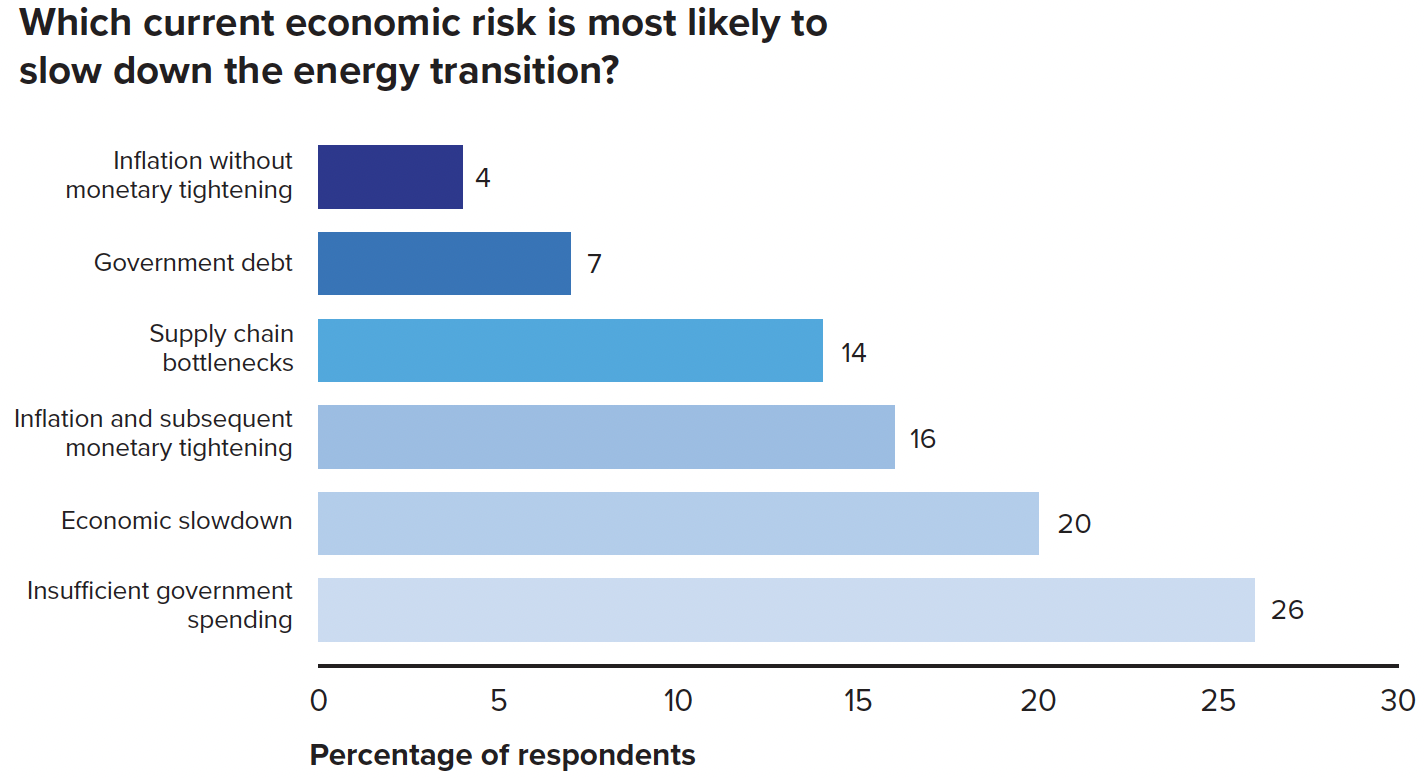
The differences are marked. The public sector and third sectors put far more emphasis on the risk of low government spending and, by extension, the importance of such funds in moving the energy transition forward. The respondents from each of the private fields instead point to macroeconomic and industry-specific considerations. Among those from renewables—who will have to deliver the technology that will undergird the shift away from fossil fuels— only a remarkably small number have government outlay as their leading concern. Instead, they point to inflation and money tightening as well as that traditional headache of renewables companies, supply chain issues.
Two possible interpretations arise. One is that public and third sector respondents should consider whether robust economic fundamentals may make a bigger contribution to a low-carbon future than funding change directly. The other is that those in the renewables business are confident that their product is economically competitive and can stand on its own two feet compared to other sources of power. That should be heartening for those who were concerned about the lack of progress made at COP26.
In our final essay, Helima Croft, Head of Global Commodity Strategy and MENA Research at RBC Capital Markets, discusses how the energy transition and net-zero goals will reshape the energy production map and the new risks that might bring.
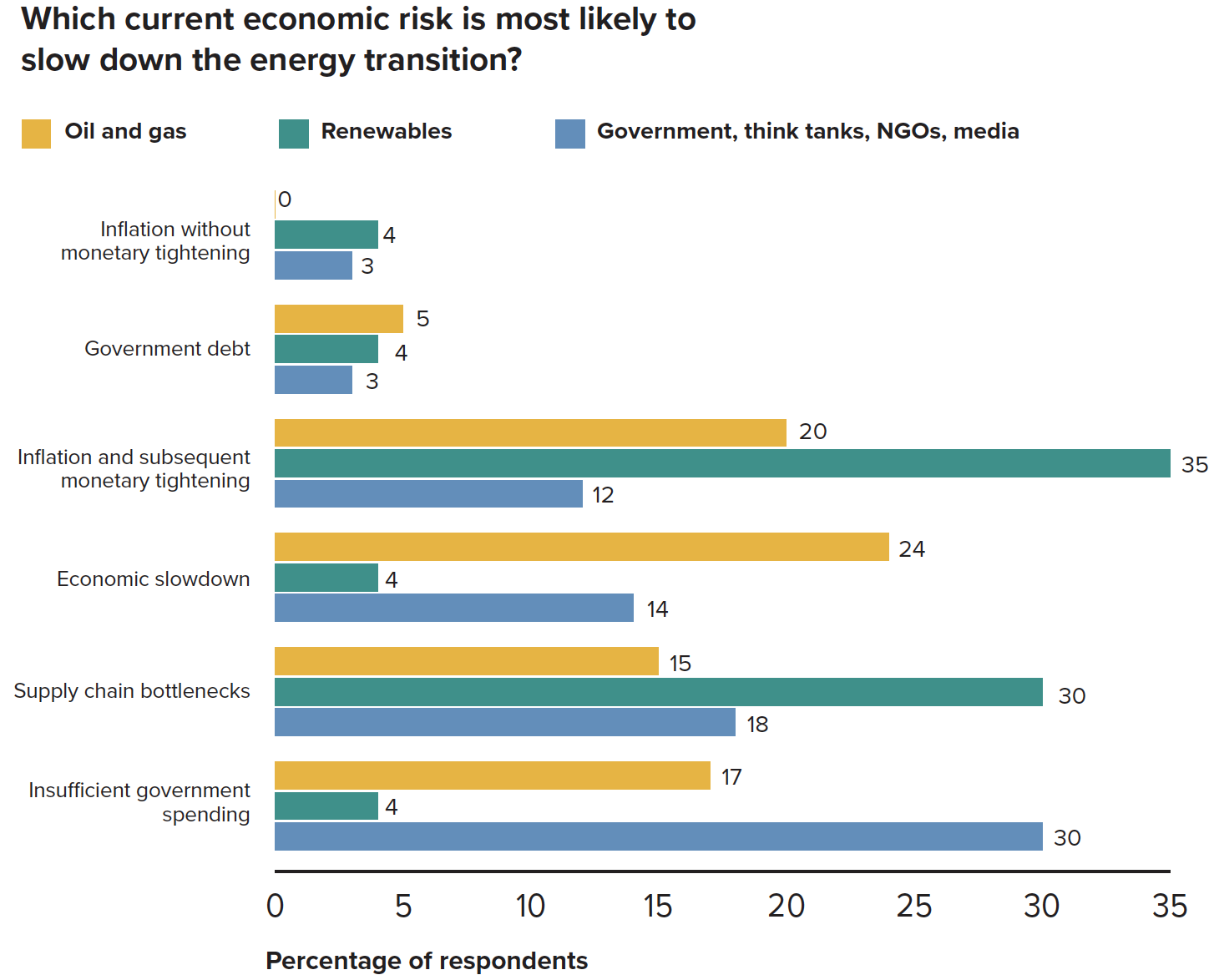
Partner perspective
The energy transition is necessary but not easy
By Helima Croft
Combatting climate change is one of the most important priorities for the Biden administration, a clear policy break with the previous one. Yet faced with a potential consumer revolt over rising gasoline prices, this White House has found itself forced to follow the long presidential tradition of making direct appeals to Riyadh for more OPEC barrels, a move which does not easily align with its ambitious net-zero pledges. Recently, President Biden’s energy team has signaled a desire for more US production; however, a full-fledged revival of President Trump’s American energy dominance agenda remains a nonstarter due to the Democratic party’s green base. Hence, we expect the Biden administration to continue to pressure OPEC and signal a willingness to release more oil from the Strategic Petroleum Reserve in conjunction with consuming countries, to try to keep prices in check in advance of the mid-term elections.
Low-cost producers in the Middle East will likely gain greater market share as their international oil company (IOC) and shale rivals face pressure from government regulation, shareholder activism, and ESG mandates. The Gulf states maintain that they are well-placed to navigate the energy transition, with their barrels on the low end of the cost and emissions curve and optimal economics for key transition fuels such as hydrogen. November’s Abu Dhabi International Petroleum Exhibition and Conference (ADIPEC) was one of the first major global gatherings of energy leaders in the immediate aftermath of the COP26 climate talks, and the issue of energy scarcity loomed large in the conversations. H.E. Dr. Sultan Al Jaber, the CEO of Abu Dhabi National Oil Company (ADNOC) outlined his country’s parallel policy approach; the plan seeks to reach a net zero by 2050 climate target (through measures such as having 100 percent of ADNOC’s grid powered by nuclear and solar and the company making its first move into the renewables space), while at the same time increasing investment in the upstream sector and raising spare capacity to 5 million barrels per day by 2030.24 Representatives of other national oil companies in the region also touted similar plans to bolster investment in conventional hydrocarbons. If an energy version of musical chairs does unfold, these regional NOCs seem intent on being the last ones standing. We remain most concerned about how some of our OPEC Watch List “fragile five” members—Libya, Venezuela, Nigeria, Iraq, and Algeria—will fare in an accelerated energy transition scenario, as it looks like it will be far more jarring for the petrostates that have not commenced serious economic reform efforts and/or have higher cost and higher emissions per barrel.
The issue of energy access will also likely take on greater prominence as the global climate gathering moves to the African continent this year when Egypt hosts COP27. Leaders of developing nations have frequently criticized climate campaigners in the industrialized world for failing to address their deep concerns about energy access and poverty alleviation. Countries like India insist that a balance must be struck between accelerating the transition to a greener, cleaner future while ensuring that the millions of people using biomass to heat their homes have access to reliable and affordable sources of energy. Energy poverty is particularly pronounced in Sub-Saharan Africa. The continent accounts for 75 percent of the world’s population without access to electricity, and the region’s access deficit increased from 556 million people in 2010 to 570 million people in 2019.25 Electrification is lagging behind population growth in many places on the continent, including the Democratic Republic of Congo, Nigeria, and Malawi.
Finally, securing a supply chain of critical minerals required to build out the clean electricity infrastructure will likely become an increasingly important concern for the White House and other Western leaders. According to the World Bank, the production of critical minerals, such as graphite, lithium, and cobalt, would need to grow by over 500 percent by 2050 to meet the demand for clean energy technologies.26 And yet, much of the current critical mineral production that will be needed to scale up electric vehicle use globally is concentrated in a small number of nations, more than a few of which have profound governance and security problems. In our view, this poses serious questions about whether the energy transition will really eliminate concentration risk or just swap out reliance on one set of commodities and commodity producers for another. Senior Biden administration officials have indicated that building a domestic supply chain of critical minerals is an urgent priority, particularly given China’s entrenched position in this arena. President Biden has found that the energy transition does not necessarily mean low energy prices, and he will continue to face the twin challenges of implementing his ambitious climate agenda and preventing pain at the pump for US consumers in 2022.
24 “Khaled bin Mohamed bin Zayed launches landmark clean energy partnership between ADNOC and EWEC,” ADNOC Press Release, October 26, 2021, https://www.adnoc.ae/en/news-and-media/press-releases/2021/khaled-bin-mohamed-bin-zayed-launches-landmark-clean-energy-partnership-between-adnoc-and-ewec.
25 Mary Blankenship and Christina Golubski, “Figure of the week: Increasing access to electricity in sub-Saharan Africa,” June 18, 2021, https://www. brookings.edu/blog/africa-in-focus/2021/06/18/figure-of-the-week-increasing-access-to-electricity-in-sub-saharan-africa/.
26 World Bank Group, Minerals for Climate Action: The Mineral Intensity of the Clean Energy Transition, 2020, https://www.worldbank.org/en/topic/ extractiveindustries/brief/climate-smart-mining-minerals-for-climate-action.
Helima Croft is the Head of Global Commodity Strategy and MENA Research at RBC Capital Markets, LLC. RBC Capital Markets, LLC is a sponsor of the Atlantic Council Global Energy Forum.
This content is based on information available at the time it was written, and is for informational purposes only. It is not an offer to buy or sell, or a solicitation, and no recommendations are implied. It is outside the scope of this communication, to consider whether it is suitable for you, and your financial objectives. For Disclosures and Disclaimers, see: https://www.rbccm.com/en/policies-disclaimers.page
Conclusion
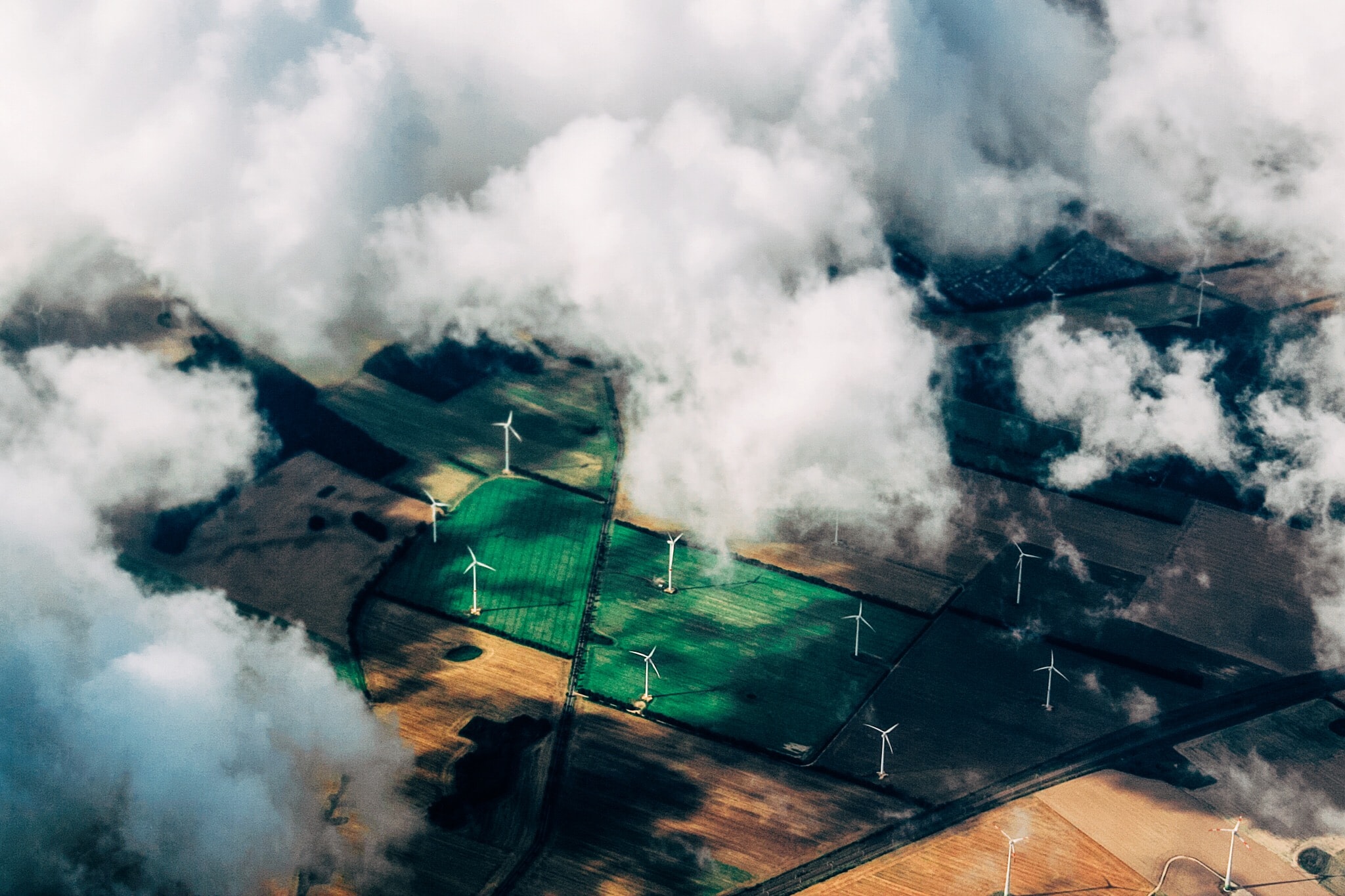
Conclusion
Entering 2022, The Global Energy Agenda survey respondents were far more ambivalent about the future—perhaps even pessimistic—than they were entering 2021. Last year, we concluded they thought “2021 could be an inflection point in the fight against climate change.” With the predictions about reaching net zero and the timing of peak oil demand sliding back by several years, they clearly no longer thought that 2021 had been the inflection point they had anticipated.
But the actual picture is not as clear as the dour mood might suggest. As Alok Sharma noted, COP26 “kept 1.5 alive.” Negotiators completed the Paris rulebook, which our respondents had thought would be nearly impossible. And while countries did not agree on a coal “phase out,” they did agree on a “phase down,” the first time that fossil fuels were specifically mentioned in a COP communiqué.
And momentum continues on clean energy. 2021 was a record year for deployment of renewable capacity, as well as for investment in cleantech startups. That our renewables respondents think they will be successful regardless of government spending suggests that their business model is sound and the private sector is moving in the right direction.
The work needed to reach climate goals while managing short-term energy needs is immense, and leaders are not going to get it right all the time. The direction of travel is correct, but leaders must double down on their efforts on pragmatic, actionable solutions that bring everyone along.
And who knows what 2022 will really bring? Respondents were clearly wrong about 2021. To put a finer point on this, we asked last year’s respondents what the price of Brent crude would be on December 31, 2021. The mean response: $51.22. The actual price: $77.24.
This year’s respondents predicted that, on December 31, 2022, the price will be $78.00, about $5 more than when this year’s survey was finalized, but about $8 less than at the time of publication in mid-January 2022.
As analysts predict oil will jump to over $100 if tensions continue to ratchet up in Ukraine, it is clear that the global community has its work cut out for it. The global energy agenda has perhaps never been as challenging, and never been as important, for ensuring global economic stability and the fate of our planet.
Appendix
Appendix
The survey samples comes from across the globe, with respondents based in 41 countries. Nearly two-thirds (65 percent) live in the United States; 18 percent live in Europe; and 7 percent live in the Middle East and North Africa, with the remainder in Asia, Africa, Canada, Mexico, and Australia.
Those surveyed also include all age groups from 18 to over 75, although more senior individuals are also more heavily represented. The mean age of survey respondents is 56.
Respondents also come from across the energy sector broadly defined. For example, 31 percent are consultants, and 26 percent work in think tanks. As for areas within the energy sector, 26 percent report that they are connected to oil and gas (including pipelines, exploration, production, refining, and oilfield services), 20 percent are in renewables in some way, and 19 percent are in a predominantly electricity-related field (nuclear power, transmission, or distribution).
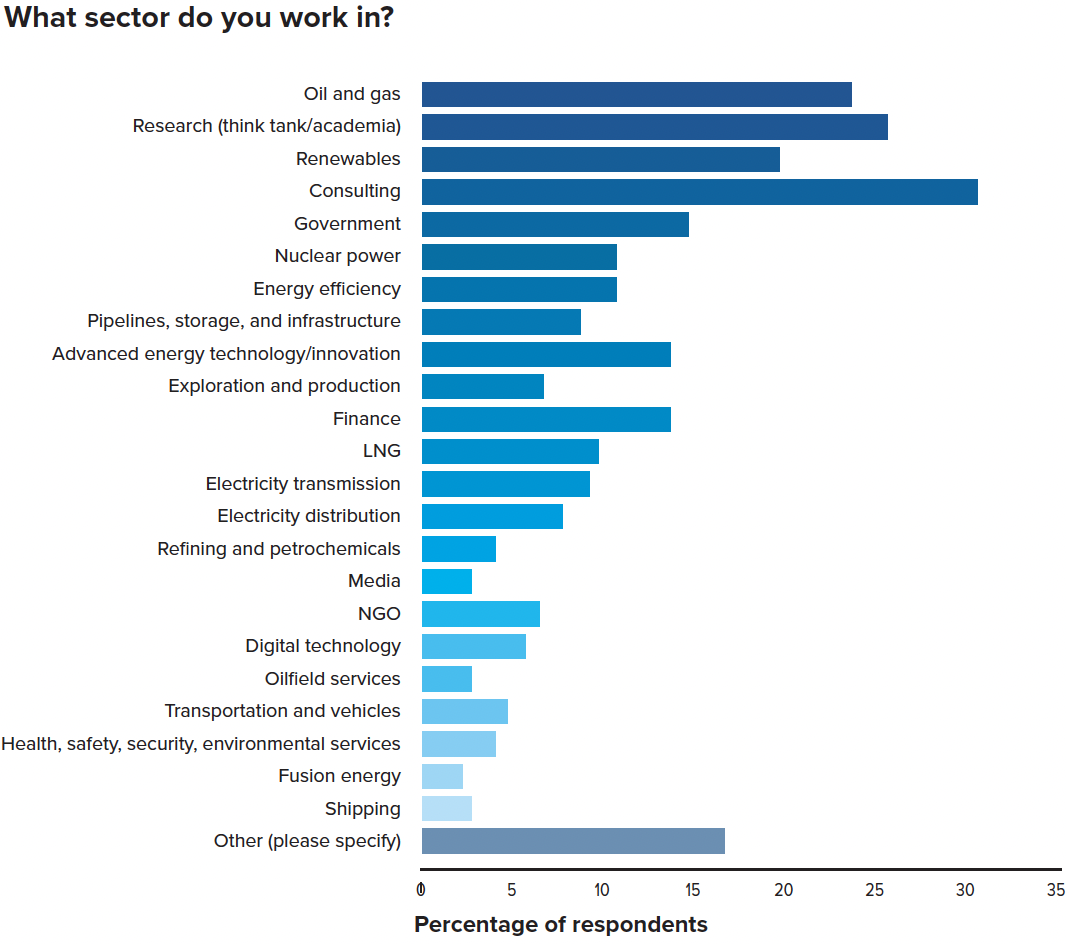
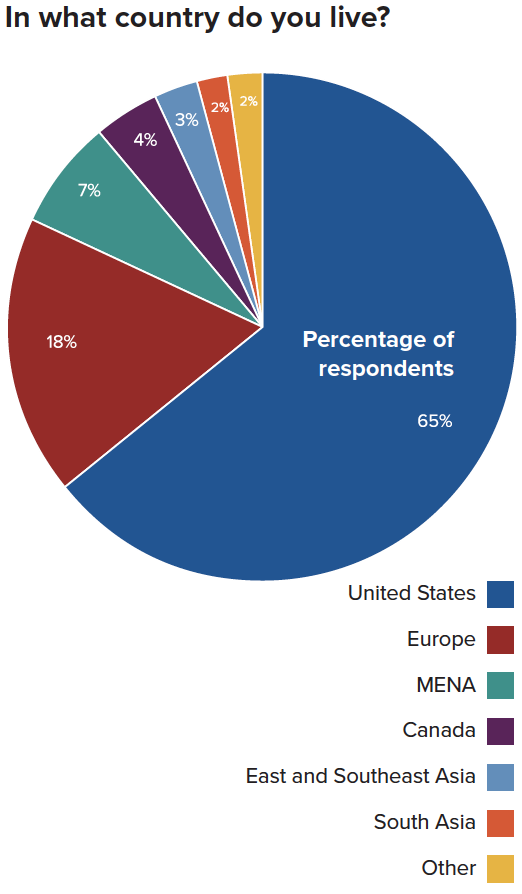
Rather than distinct groups, these sectors are heavily intertwined: on average, those surveyed say that they fall into more than two different categories. Sometimes this overlap points to ongoing debates about the role of any given activity in the energy future. For example, 38 percent of those in nuclear power also say that they are in renewables. More generally, though, these multiple categories point to the nature of the sector. For example, presumably because so many renewables generate electricity, this year we are not able to tease out those two sectors to look at them separately.
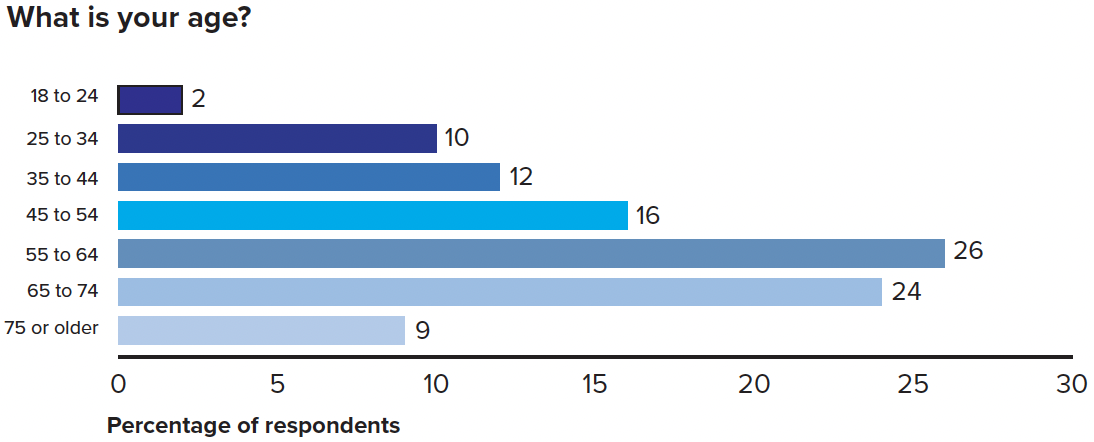
That said, after removing the oil and gas respondent pool, those who are also in renewables and government, a sufficient number (14 percent of the survey total) remain to provide a viable sample for analysis. Like last year, our analysis—when discussing “oil and gas” or “renewables” as a group—uses the figures after the respondents who say that they are in both have been removed. Otherwise, the large overlap between groups would blur distinctions. When the text refers to those associated with renewables—or to those associated with oil and gas—we use the unadjusted figures.
THE 2021 GLOBAL ENERGY AGENDA
EDITORS
Randolph Bell is a Distinguished Fellow of the Atlantic Council Global Energy Center; Jennifer T. Gordon is the Director of the Nuclear Energy Policy Initiative; Ameya Hadap is a Program Assistant for the Atlantic Council Global Energy Center; and Paul Kielstra is a freelance editor, analyst, and writer based outside of London.
SPONSORS
Presenting partners

Platinum co-chair

Gold partners

Knowledge partner

International media partner

Silver partners

Bronze partners

Digital partners

Media partners

RELATED EVENT
The Atlantic Council Global Energy Forum is the premier international gathering of government, industry, and thought leaders to set the energy agenda for the year.
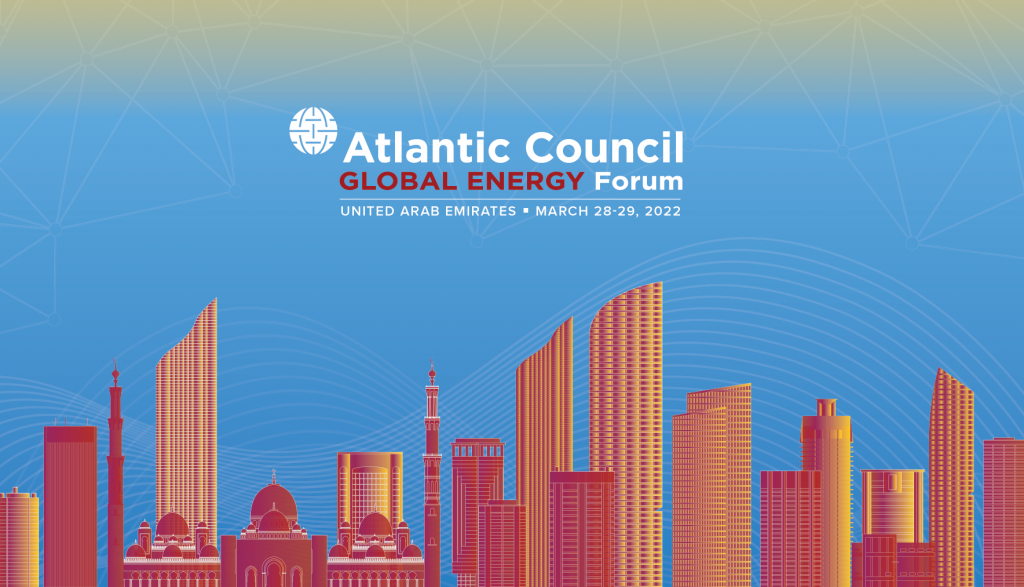

The Global Energy Center develops and promotes pragmatic and nonpartisan policy solutions designed to advance global energy security, enhance economic opportunity, and accelerate pathways to net-zero emissions.
Subscribe to our newsletter
Sign up to receive our weekly DirectCurrent newsletter to stay up to date on the program’s work.


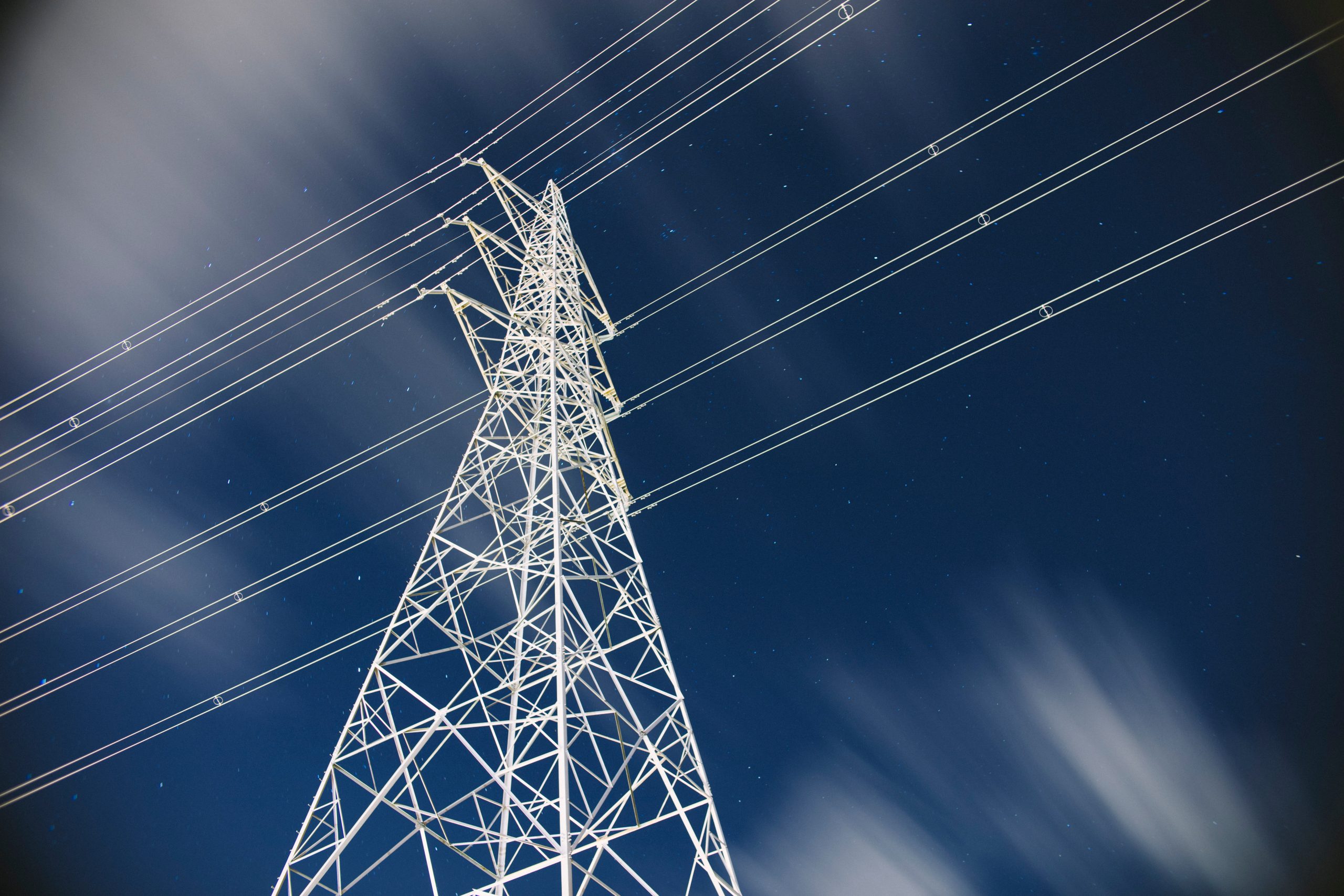




Follow the conversation on social media using #2022GlobalEnergyAgenda